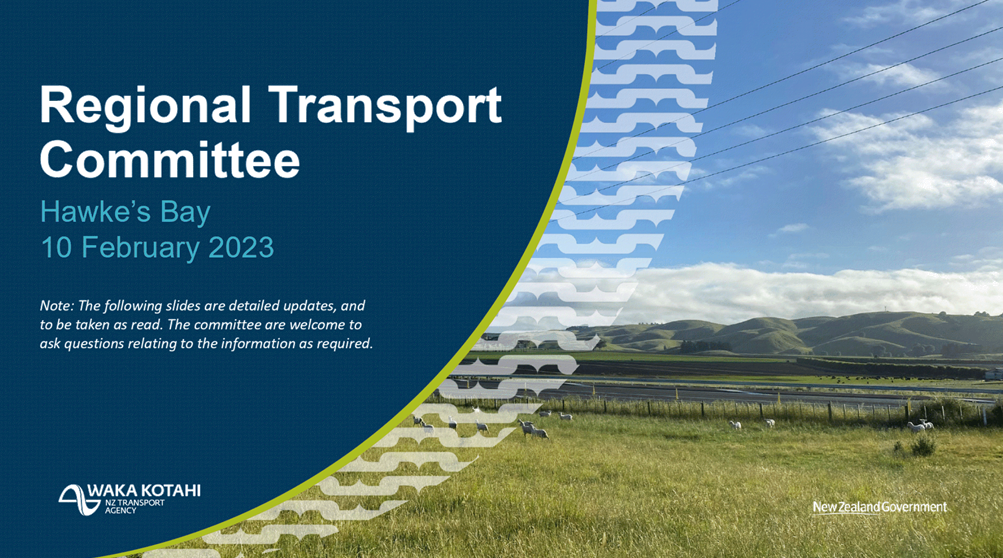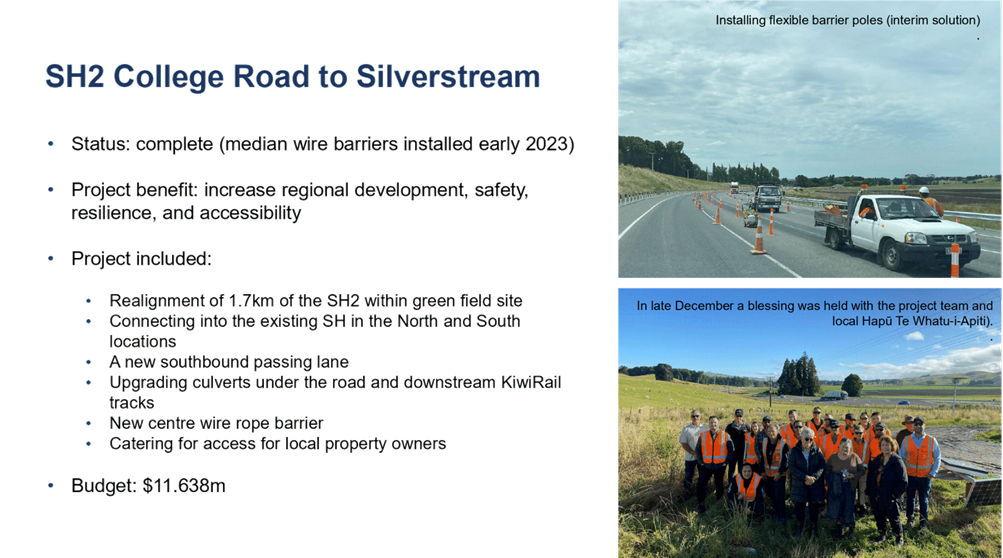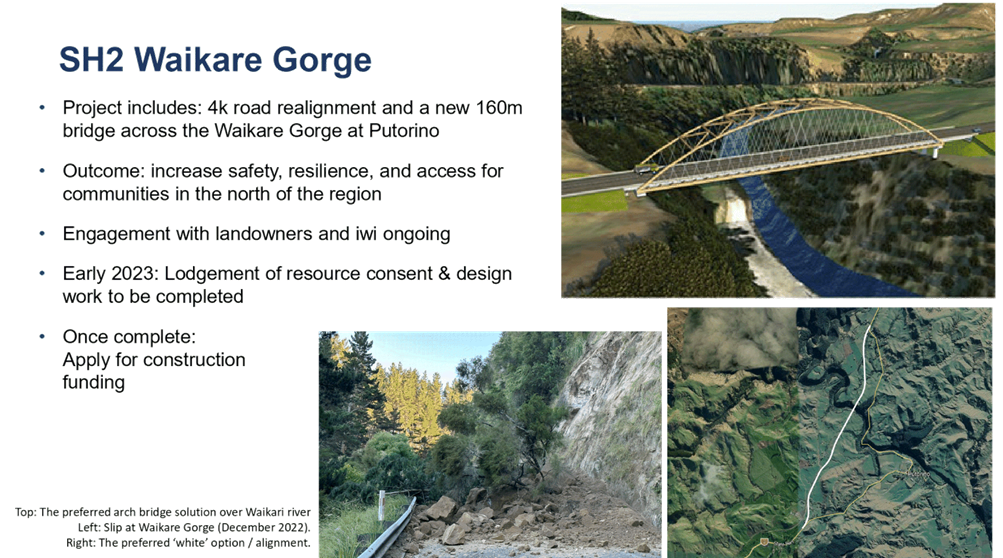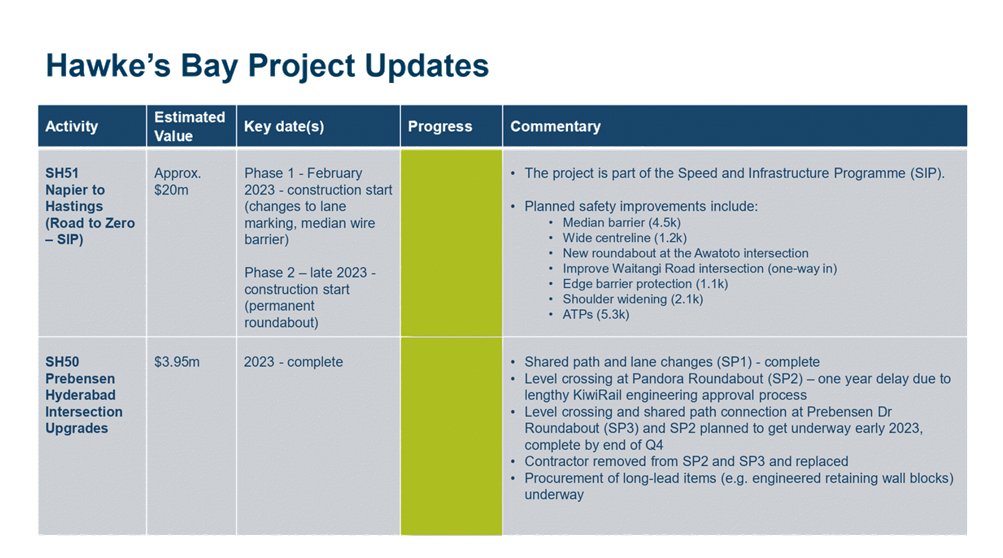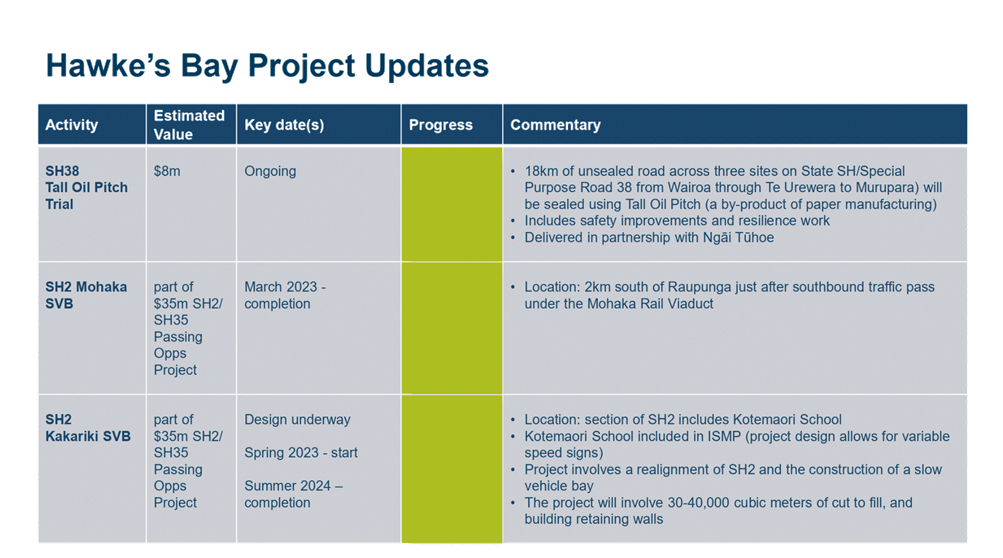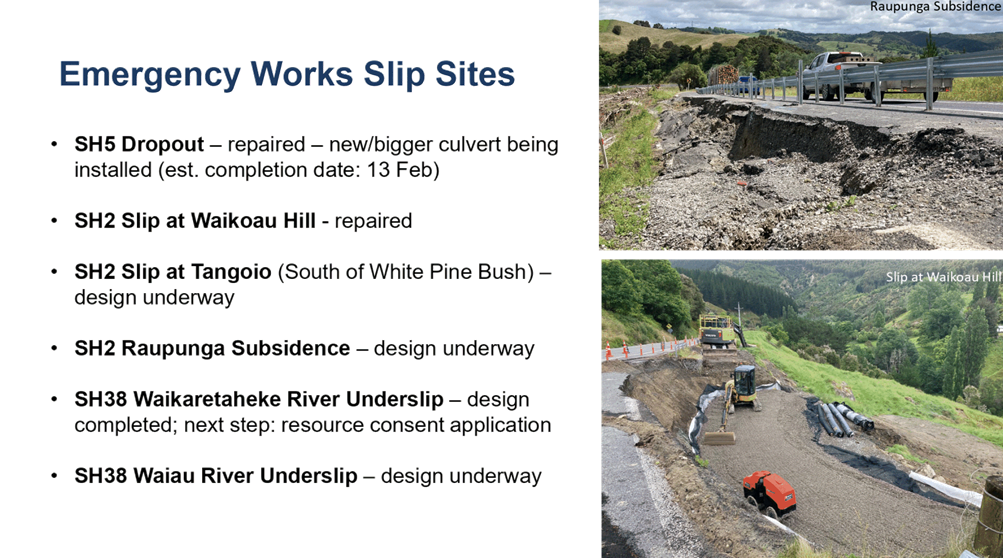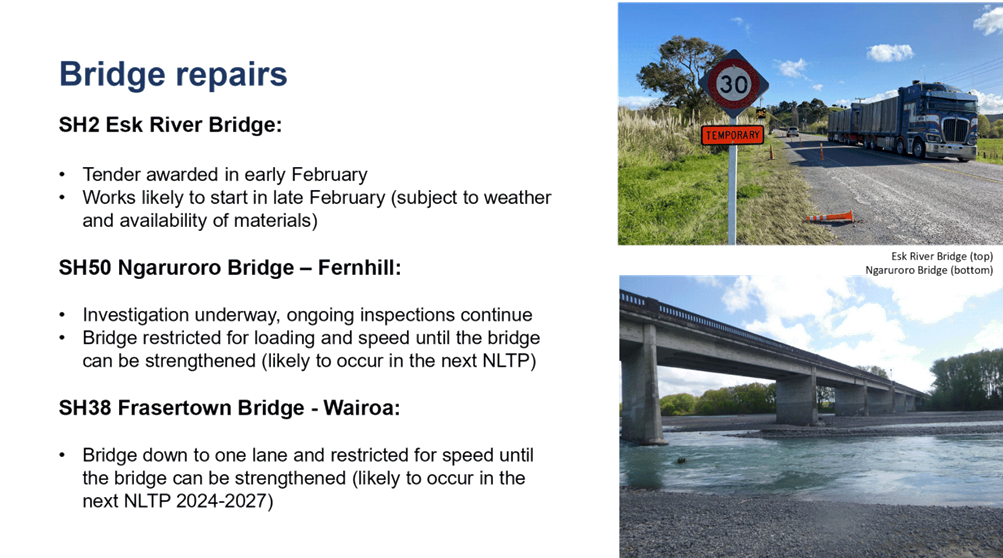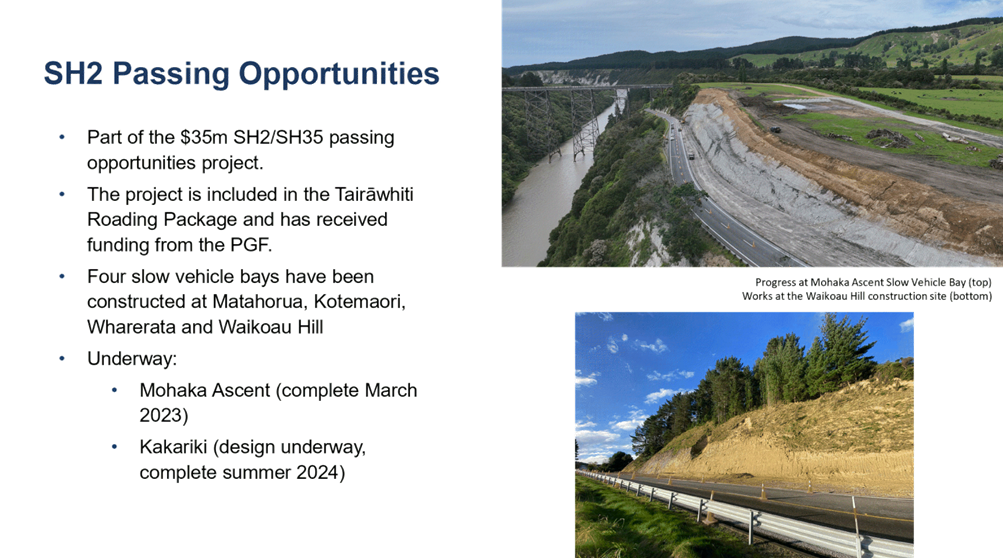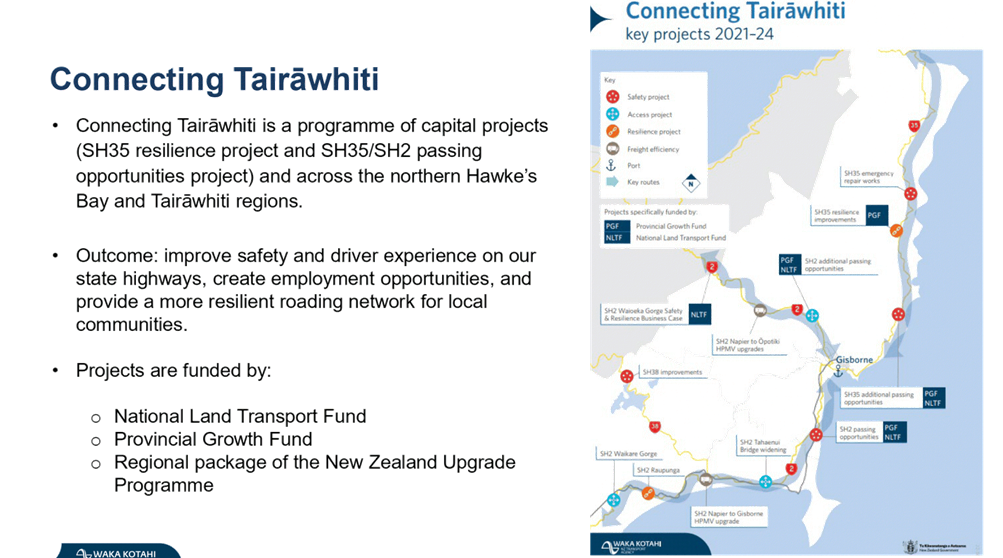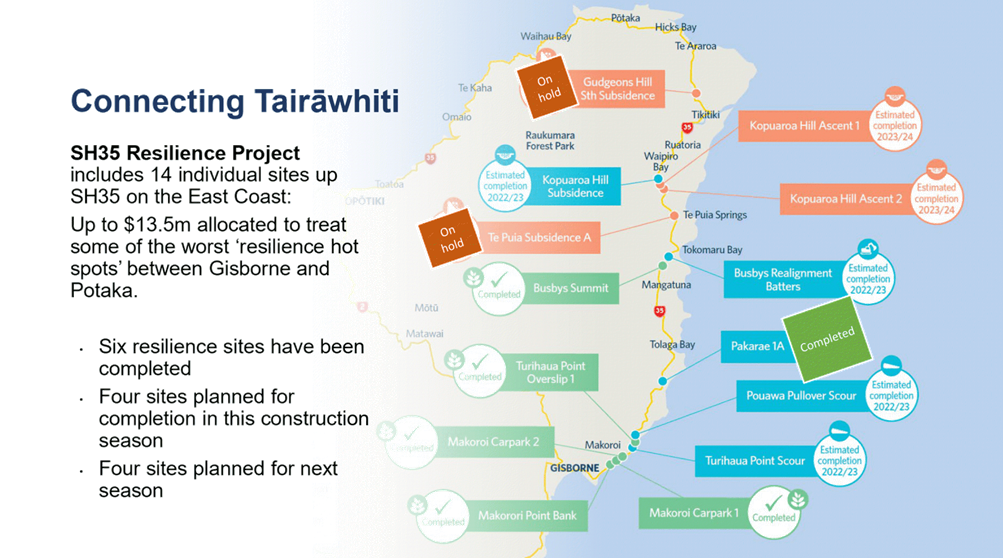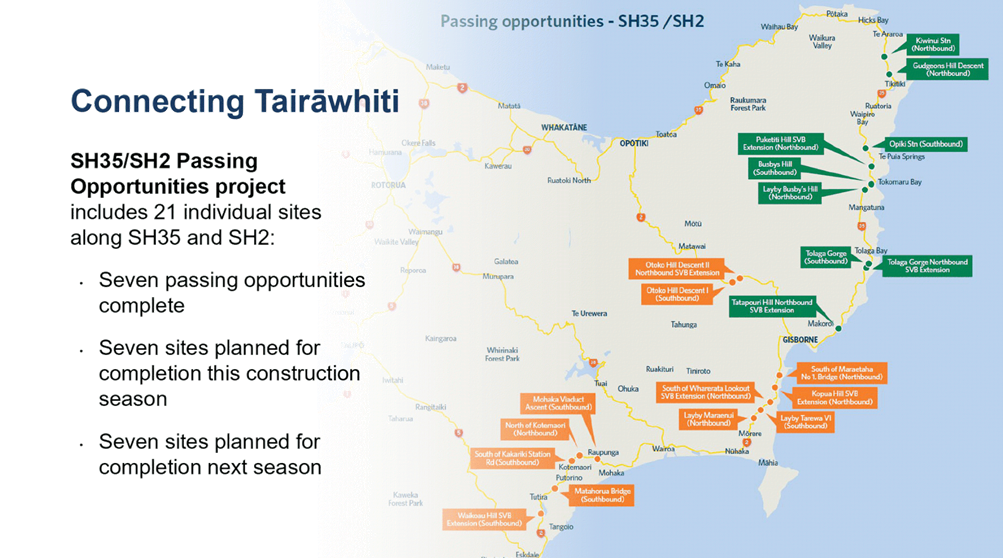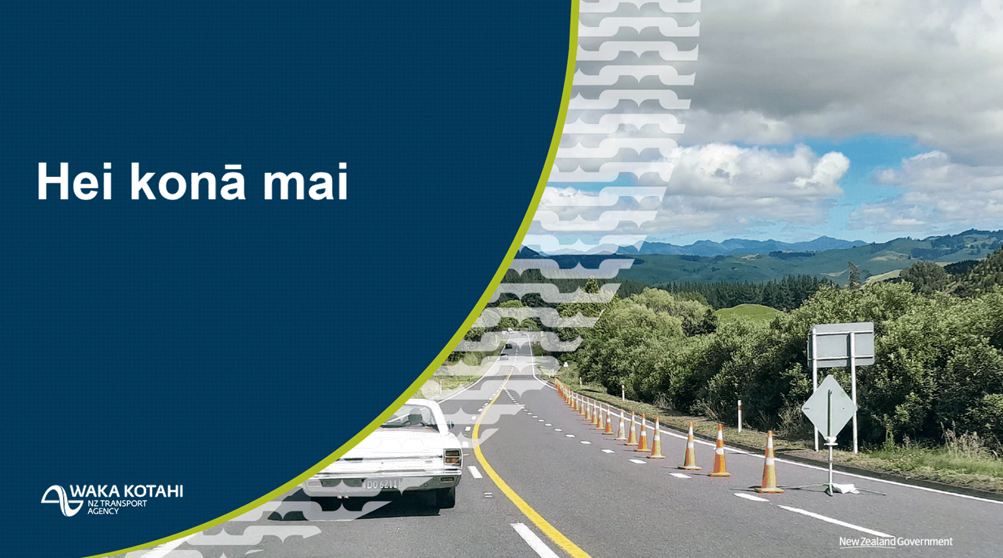Meeting of the
Regional Transport Committee
Date: Friday 10 February 2023
Time: 10.00am
|
Venue:
|
Council
Chamber
Hawke's
Bay Regional Council
159
Dalton Street
NAPIER
|
Agenda
Item Title Page
1. Welcome/Karakia/Notices/Apologies
2. Conflict
of Interest Declarations
Decision
Items
3. Regional
Transport Committee Terms of Reference and member appointments 3
4. Setting
the priorities and principles for the Regional Speed Management Plan 19
Information
or Performance Monitoring
5. Johanna
Birrell Deputation - Te Whatu Ora HB Safe Cycling report 29
6. Regional
Land Transport Plan investment and delivery update 83
7. Transport
Emissions Reduction Plan update 91
8. Regional
Transport Programme Tracker February 2023 143
9. Regional
Road Safety update 147
10. Public
Transport update 159
11. Active
Transport update 165
12 NZTA
Regional Relationships Director's February 2023 report 169
13. Verbal
updates by Advisory Representatives
Hawke’s Bay Regional
Council
Regional
Transport Committee
Friday 10
February 2023
Subject:
Regional Transport Committee Terms of Reference and member appointments
Reason for Report
1. This agenda item provides
the means for the Regional Transport Committee to confirm its Terms of
Reference and the appointments to its membership.
Executive
Summary
2. Following the 2022 Local
Body Elections, the Regional Transport Committee was re-established by
resolution of Hawke’s Bay Regional Council, including its Terms of
Reference, as required by the Land Transport Management Act 2003.
3. The Territorial Local
Authorities of the region also met following the 2022 Local Body Elections and
resolved their representatives on the Committee.
Background
4. The Regional Transport
Committee and its membership is prescribed by the Land Transport Management Act
2003 as being:
4.1. As
soon as practicable after each triennial election, every regional council must
establish a regional transport committee under this section for its region.
4.2. Each
regional council must appoint to its regional transport committee— 2
persons to represent the regional council, 1 person from each territorial authority
in the region to represent that territorial authority and 1 person to represent
the Agency.
4.3. Each
regional council must appoint from its representatives the chair and deputy
chair of the committee.
4.4. At
any meeting of a regional transport committee, the chair, or any other person
presiding at the meeting has a deliberative vote and in the case of an equality
of votes, does not have a casting vote (and therefore the act or question is
defeated and the status quo is preserved).
4.5. S105A KiwiRail
representation on regional transport committees - A regional transport committee must include 1 additional
member to represent KiwiRail (the KiwiRail
member); KiwiRail must appoint the KiwiRail
member; and The KiwiRail member has no voting rights at any meeting of the
committee and must not be appointed as the chairperson or deputy chairperson
(or by any other process preside at any meeting).
Discussion
5. At the Regional Council
meeting on 16 November 2022, councillors Martin Williams and Jerf van Beek were
appointed as the Council’s representatives, as Chair and Deputy Chair
respectively.
6. The Territorial Authority
representatives for Napier City, Central Hawke’s Bay District, and
Hastings District Council, and the advisory representative for KiwiRail have
been confirmed as attached and noted in the Recommendations section.
7. We await confirmation of
the appointments from:
7.1. Wairoa District Council (1
rep & 1 alternate)
7.2. HBRC Māori Committee
(1 advisory rep)
7.3. Te Whatu Ora Hawke’s
Bay (1 advisory rep)
7.4. Active Transport (1
advisory rep to be appointed once the group has been established).
Decision Making Process
8. Councils and their
committees are required to make every decision in accordance with the
requirements of the Local Government Act 2002 (the Act). Staff have assessed
the requirements in relation to this item and have concluded:
8.1. Councils are required to
(LGA sch.7 cl.19(1)) hold the meetings that are necessary for the good
governance of their district or region
8.2. Councils may appoint (LGA sch.7 cl. 30(1)(a)) the committees,
subcommittees, and other subordinate decision-making bodies that they consider
appropriate, including joint committees
8.3. The establishment of a
Regional Transport Committee, including its membership, is prescribed by the Land Transport Management
Act 2003 Part 4, sub-part 2, sections 105-107 inclusive.
8.4. Given the provisions above,
the Regional Transport Committee can exercise its discretion and make these
decisions without consulting with the community or others having an interest in
the decision.
Recommendations
That the Regional Transport Committee:
1. Receives and considers the Regional
Transport Committee Terms of Reference and member appointments staff
report.
2. Agrees that the decisions
to be made are not significant under the criteria contained in Council’s
adopted Significance and Engagement Policy, and that Council can exercise its
discretion and make decisions on this issue without conferring with the
community or persons likely to have an interest in the decision.
3. Confirms the Terms of
Reference for the committee as adopted by Hawke’s Bay Regional Council on
16 November 2022.
4. Agrees to the membership as
detailed in the Terms of Reference adopted by Hawke’s Bay Regional
Council on 16 November 2022, and accepts the appointment of representatives,
being:
4.1. Councillor Martin Williams
representing Hawke’s Bay Regional Council as Chair of the Regional
Transport Committee
4.2. Councillor Jerf van Beek
representing Hawke’s
Bay Regional Council as Deputy Chair of the Regional Transport Committee
4.3. Mayor Alex Walker and
councillor Kate Taylor as alternate, representing Central Hawke’s Bay
District Council.
4.4. Councillor Tania Kerr and
Mayor Sandra Hazlehurst as alternate, representing Hastings District Council.
4.5. Councillor Keith Price and
Mayor Kirsten Wise as alternate, representing Napier City Council.
4.6. Councillor ____ and
councillor __ as alternate, representing Wairoa District Council.
4.7. Linda Stewart and Sarah
Downs as alternate, representing Waka Kotahi.
4.8. Angus Hodgson representing
KiwiRail as a non-voting advisory member.
4.9. Matthew Broderick
representing New Zealand Policy as a non-voting advisory member.
4.10. Nick Ganivet representing
Napier Port as a non-voting advisory member.
4.11. Paul Michaelson
representing Automobile
Association (access and mobility, including private motorists, pedestrians,
cyclists and public transport users) as a non-voting advisory member.
4.12. Ian Emerson representing Road Transport Association
NZ (road transport industry) as
a non-voting advisory member.
4.13. ________ representing the HBRC Māori
Committee (cultural and environmental interests) as a non-voting advisory member.
4.14. ___________representing Te Whatu Ora in
Hawke’s as a non-voting advisory member.
4.15. A representative of active
transport in the Hawke’s Bay region to be confirmed.
Authored by:
|
Leeanne Hooper
Team Leader Governance
|
Katie Nimon
Transport Manager
|
Approved by:
|
Katrina Brunton
Group Manager Policy & Regulation
|
|
Attachment/s
|
1⇩
|
2022-25 Regional Transport Committee
Terms of Reference
|
|
|
|
2⇩
|
HDC 2022 appointments to HBRC
committees
|
|
|
|
3⇩
|
NCC appointments
|
|
|
|
4⇩
|
2023 Kiwirail advisory member
appointment
|
|
|
|
5⇩
|
CHBDC Committee Appointments 2022
|
|
|
|
2022-25 Regional Transport Committee
Terms of Reference
|
Attachment
1
|


|
HDC 2022 appointments to HBRC committees
|
Attachment
2
|

|
NCC appointments
|
Attachment
3
|




|
2023 Kiwirail advisory member appointment
|
Attachment
4
|

|
CHBDC Committee Appointments 2022
|
Attachment
5
|

Hawke’s
Bay Regional Council
Regional
Transport Committee
Friday 10 February
2023
Subject:
Setting the priorities and principles for the Regional Speed Management Plan
Reason for Report
1. This report presents the
draft regional principles, priorities, and guidelines to be reflected and built
into the local road controlling authority Speed Management plans to create a
regionally aligned plan to enable a decision by the Regional Transport Committee
(RTC).
Officers’
Recommendation
2. Staff recommend the RTC
adopts the proposed regionally aligned speed management planning principles and
priorities to progress Road Controlling Authority (RCA) speed management
planning.
Executive
Summary
3. Speed management is a facet
of Waka Kotahi’s Road to Zero strategy, recognising speed management as a
key part of an all of system approach to safer roading and roading
environments. Hawke’s Bay has some challenging roads with speeds that are
currently not fit for their intended form and function.
4. The report sets the context
for regionally aligned speed management planning principles and priorities. It
lays out the roles and responsibilities of HBRC and the RCA within the region
and discusses the importance of having aligned, agreed, and endorsed speed
management principles and priorities
Background
/Discussion
Road to Zero
5. Road to Zero is the
governments road safety strategy, replacing Safer Journey’s strategy
which reached the end of its’ tenure in 2019. The strategic vision is for
New Zealand to be a country where no one is killed or seriously injured in road
crashes. Effectively, this means that no death or serious injury is acceptable
while travelling on New Zealand roads. The strategic target of Road to
Zero is a 40% reduction in Death and Serious Injuries by 2030.
6. The Road to Zero strategy
is an evidence based and internationally proven approach to practically
reducing serious road trauma. It takes an all of system approach that actively
recognises that humans are inherently vulnerable and make mistakes. This means
that a holistic all of system approach must be taken that enables us to promote
good choices and behaviour, but plan for mistakes. This strategy is informed by
a range of guiding principles and strategic priorities. Importantly, the five
focus areas of Road to Zero inform and direct investment and education
activities through an all of system approach. The focus areas are:
6.1. Vehicle safety –
focused on significantly improving the safety performance of the national fleet
6.2. Work related safety –
ensuring that businesses and other organisations treat road safety as a
critical health and safety issue
6.3. Road user choice –
Encouraging safer choices and safer behaviours on our roads
6.4. System Management –
develop a management system that reflects international best practice.
6.5. Infrastructure improvements
and speed management – improve road safety of our cities and regions
through infrastructure improvements and speed management
7. Speed management forms a
part of the Road to Zero strategy and is a proven low-cost tool that can be
applied to enable positive change in road deaths and serious injury.
Land
Transport Rule: Setting of Speed Limits 2022
8. In May 2022 the new Land
Transport Rule: Setting of Speed Limits 2022 (the Rule) came into force. The
new Rule is designed to form a more consistent approach to applying speed
management within regions, with consideration of speed limits alongside investment
in safety infrastructure by RCAs.
9. More specifically, the Rule
establishes an integrated speed management planning process the considers how
safety infrastructure, safety cameras, and speed limits can be combined
effectively to help achieve a safe transport system. The Rule sets out to
achieve this by:
9.1. Providing for a whole of
network approach where speed management is considered alongside investment in
safety infrastructure
9.2. Empowering or requiring
RCAs to set speed limits for roads under their control
9.3. Setting out requirements
RCAs must comply with when setting speed limits
10. Each RCA in Hawke’s
Bay will be required to develop a speed management plan for the roads they
control. This will subsequently be offered for public consultation ahead of
adoption and certification by Waka Kotahi.
11. Waka Kotahi have developed
resources to assist with the development of speed management plans, outlining
their place and importance in an all of system approach. The Speed
management guide: Road to Zero edition provides detailed information and
guidance around safe and appropriate speeds along with applicable roles and
responsibilities in relation to the development of speed management guides. The
speed management guide also provides guidance around partnerships with
Māori throughout the speed management plan development process.
The
role of Hawke’s Bay Regional Council (HBRC)
12. HBRC is not a road
controlling authority, therefore cannot develop or implement a speed management
plan. However, the Rule does encourage and empower regional councils to
collectively create regionally aligned principles and priorities. These are
outlined below.
13. The ongoing role of HBRC in
the speed management process will be largely administrative and see HBRC assisting
RCAs with engagement and consultation as requested. HBRC will also enable
Māori to have opportunities to contribute to the preparation of the
regional speed management plan.
14. HBRC will work to
facilitate the administrative function of regional consultation, for all RCA
plans following the regional process.
15. HBRC officers will also
assist in the collation and analysis of RCA consultation feedback, if requested
and play a role in collating the overall regional speed management plan.
16. HBRC must ensure the
regionally aligned principles and priorities are endorsed and adopted by the
Regional Transport Committee. RCA speed management plans will then be developed
following the regionally agreed principles and priorities. For completeness,
HBRC and council transport officers are developing a suite of regional
guidelines to ensure a consistent approach is taken in the development and
implementation of RCA speed management plans.
17. The full regional speed
management plan that is a collation of the RCA speed management plan must be
certified through Waka Kotahi by 30 June 2024. Agreeing the vision, priorities,
and principles at this stage enables RCAs to adopt a consistent regional
approach. Additionally, it will assist HBRC with the collation of the final
regional speed management plan, giving sufficient time to ensure consistency.
Regional
approach to be taken by RCAs in developing speed management plans
18. The RCAs of Hawke’s
Bay recognise and have reviewed the Speed Management Guide: Road to Zero,
developed by Waka Kotahi, fully understanding the all-of-system approach
discussed within the guide.
19. Given the diverse nature of
the roads in Hawke’s Bay, it is likely the RCAs will take a road-by-road
approach to speed management planning. Waka Kotahi guidance suggests a speed
management approach that aligns with the One Network Framework urban street
categories and safe speed limit ranges. This is a roading classification
applied to an area or grouping of roads. The nature of the roads in
Hawke’s Bay mean it is more practical and robust to adopt a road-by-road
approach to speed management planning and implementation.
20. It is important that the
RTC is aware that the process of developing and implementing speed management
plans occurs over a 10-year period. Schools will be completed in the short
term, with other roads and areas implemented in a phased manner. Ultimately,
this is one tool in and all of system approach of Road to Zero.
21. To support a regionally
aligned approach a suite of guidelines is being developed to ensure consistency
across all RCAs in approach and process. These draft regional guidelines can be
found in appendix 1 and are subject to change. Regional guidelines do not form
part of the legislative responsibility held within the speed management
planning process. However, all officers saw significant added value in the
development and use of region wide guidelines / ways of working.
The
role of the Regional Transport Committee (RTC)
22. Following the development
of speed management plans by the relevant RCA, the RTC will play a role in
consolidating the information from RCAs into a draft regional speed management
plan.
23. The RTC will also provide a
forum to address any regional boundary or consistency issues that may arise
from the RCA speed management process and require decision making.
24. The RTC will play a role in
preparing a final draft regional speed management plan for certification by the
Director of Land Transport.
Draft
vision, principles, and priorities
25. The RTC is charged with
endorsing and adopting the principles and priorities for speed management in
Hawke’s Bay. These recognise the diversity of the physical roading environment
and communities within our region and set the tone for an aligned and proactive
approach to speed management. Further, these principles and priorities actively
recognise that speed management is part of an all of system approach to
achieve safer roads.
26. HBRC and RCA staff are
working on a draft regional speed management plan. This will evolve along with
the overall process. The document sets the context and tone for the regional
speed management plan, with the principles and priorities forming the
foundations.
27. The vision, principles, and
priorities have been developed by HBRC and RCA transport staff as subject
matter experts.
Vision
28. The vision for
Hawke’s Bay is to have a transport system that is safe, appropriate,
coherent, and fits the intended form, function, and use across our vastly
different regional landscape.
29. While the vision sets the
strategic tone, it does not require RTC approval or endorsement.
Principles
30. The following principles
will be closely considered when making decisions about appropriate speed
management across Hawke’s Bay:
30.1. Safe communities and
connections for all
30.2. Greater public
understanding of safe system principles, including that of elected members
30.3. Increased connectivity
within and between communities – designed with and for the community
30.4. Network coherence /
uniformity across the region and beyond
30.5. Increased opportunity for,
and access to multi-modal / active transport
30.6. A speed management approach
that serves the needs of the community that the network is serving / supporting
30.7. Work with Iwi and community
leaders as key partners in the development of speed management plans.
Priorities
for speed management
31. The below priorities
articulate the collective initial focus areas across Hawke’s Bay. This
list seeks to outline the initial priority areas that will be the short to
medium term focus. This is not an exhaustive list.
32. Primary priority areas include:
32.1. Schools / Kura
32.2. Marae
33. Other priority areas
include:
33.1. Community plan areas
33.2. Those streets and roads
with currently misaligned speed limits across our urban and rural networks
33.3. Isolated rural communities
33.4. Town centres
33.5. Locations with the presence
of other key community facilities, such as hospitals, parks, rest homes, early
childhood education centres, etc
33.6. Road works zones, as
applicable and appropriate.
Options
Assessment
Option 1
34. The Regional Transport
Committee endorses and adopts the draft principles and priorities, as above.
34.1. Advantages –
Satisfies the requirements of the RTC’s role in the initial development
of speed management plans, creating regionally aligned and agreed principles,
and priorities. Additionally, sets a strong regionally aligned tone.
34.2. Disadvantages – there
are no perceived or material disadvantages.
Option 2
35. The Regional Transport
Committee does not endorse the draft principles and priorities. The RTC
provides council staff with clear direction on changes and amendments to ensure
momentum is maintained.
35.1. Advantages – The RTC
can give clear and concise input into the principles and priorities over and
above discussion of changes or amendments in the context of the RTC meeting.
35.2. Disadvantages – this
would stifle the progress of speed management planning and subsequent
consultation, pushing the timeline back to mid-year. It may result in the
requirement to hold an out of cycle RTC meeting to agree and endorse any
changes.
Option 3
36. The Regional Transport
Committee elects to do nothing.
36.1. Advantages – there
are no perceived or material advantages
36.2. Disadvantages – The
RTC will not meet the requirements of its role within regional speed management
planning and may push timelines back significantly. Additionally, to meet their
legislative requirements, the RCAs will develop speed management plans that do
not consider a regionally aligned approach.
Strategic Fit
37. Safer speeds support
sustainable and climate-resilient services and infrastructure.
Significance
and Engagement Policy Assessment
38. The priorities and
principles inform the Speed Management Plan which is of a high significance due
to the likely impact of change and requires detailed community engagement.
39. This is assessed as having
a low significance; however, it informs the Speed Management Plan which will
have a high significance as it will be of substantial interest to the community
and will be likely to impact individuals and groups in the region, however, it
promotes positive community safety outcomes. This will be subject to its own
consultation process.
Considerations
of Tangata Whenua
40. As Marae are a primary
priority area for speed management plans it is expected engagement and
consultation with Tangata Whenua will occur. As this will be within each RCA
the requirement for engagement and consultation will fall there. HBRC will
support, if requested
41. Waka Kotahi’s speed
management guide: Road to Zero edition clearly sets out the expectation
that RCAs will closely partner with Māori throughout the speed management
plan development process. A regional principle has been included highlighting
the role Iwi and community leaders plan as key partners in the development of
speed management plans.
Financial
and Resource Implications
42. It is anticipated there will
be very minimal budget implications to developing this plan.
43. There will be a resource
requirement to support consultation. Staff will be required to assist in the
collation of consultation feedback and development of a complete regional speed
management plan. It is expected this will firmly fall within staff BAU
activities.
44. An education and
communication campaign may be required to assist with driving public awareness
and understanding of safe system principles. This will fall into staff BAU activities
and will run across all councils.
Consultation
45. HBRC will be conducting
consultation on the Speed Management Plan on behalf of and in partnership with
the Hawke’s Bay RCAs.
Decision Making Process
46. Council and its committees
are required to make every decision in accordance with the requirements of the
Local Government Act 2002 (the Act). Staff have assessed the requirements in
relation to this item and have concluded:
46.1. The decision does not
significantly alter the service provision or affect a strategic asset, nor is
it inconsistent with an existing policy or plan.
46.2. The use of the special
consultative procedure is not prescribed by legislation.
46.3. The persons affected by
this decision are all residents, rate payers, tourists, and inter-regional
authorities.
46.4. Given the nature and
significance of the issue to be considered and decided, and also the persons
likely to be affected by, or have an interest in the decisions made, Council
can exercise its discretion and make a decision without consulting directly
with the community or others
having an interest in the decision.
Recommendations
That the Regional Transport Committee:
1. Receives and considers the Setting
the principles and priorities for the Regional Speed Management Plan staff
report.
2. Agrees that the decisions
to be made are not significant under the criteria contained in Hawke’s
Bay Regional Council’s adopted Significance and Engagement Policy, and
that the Committee can exercise its discretion and make decisions on this issue
without conferring directly with the community or persons likely to have an
interest in the decision.
3. Adopts the principles and
priority areas as proposed; being:
Principles
3.1. Safe communities and
connections for all
3.2. Greater public
understanding of safe system principles, including that of elected members
3.3. Increased connectivity
within and between communities – designed with and for the community
3.4. Network coherence /
uniformity across the region and beyond
3.5. Increased opportunity for,
and access to multi-modal / active transport
3.6. A speed management approach
that serves the needs of the community that the network is serving / supporting
3.7. Work with Iwi and community
leaders as key partners in the development of speed management plans.
Primary
priority areas
3.8. Schools / Kura
3.9. Marae
Other
priority areas
3.10. Community plan areas
3.11. Those streets and roads
with currently misaligned speed limits across our urban and rural networks
3.12. Isolated rural communities
3.13. Town centres
3.14. Locations with the presence
of other key community facilities, such as hospitals, parks, rest homes, early
childhood education centres, etc
3.15. Road works zones, as
applicable and appropriate.
Authored by:
|
Bryce Cullen
Transport Strategy & Policy Analyst
|
Katie Nimon
Transport Manager
|
Approved by:
|
Katrina Brunton
Group Manager Policy &
Regulation
|
|
Attachment/s
|
1⇩
|
Draft Regional Speed Management
guidelines
|
|
|
|
Draft Regional Speed Management
guidelines
|
Attachment
1
|


Hawke’s
Bay Regional Council
Regional
Transport Committee
Friday 10
February 2023
Subject:
Johanna Birrell Deputation - Te Whatu Ora HB Safe Cycling report
Reason for Report
1. This item introduces the
deputation from Johanna Birrell about the Te Whatu Ora HB Safe Cycling report
(attached).
Decision Making Process
2. Staff have assessed the
requirements of the Local Government Act 2002 in relation to this item and have
concluded that, as this report is for information only, the decision making
provisions do not apply.
Recommendation
That the Regional Transport Committee receives
and notes the That the Regional Transport Committee receives and notes the Johanna
Birrell Deputation - Te Whatu Ora HB Safe Cycling report.
Authored by:
|
Peter Martin
Senior Governance Advisor
|
|
Approved by:
|
Katie Nimon
Transport Manager
|
|
Attachment/s
|
1⇩
|
Supporting safe bike and e-bike
commuting report
|
|
|
|
Supporting safe bike and e-bike commuting
report
|
Attachment
1
|


















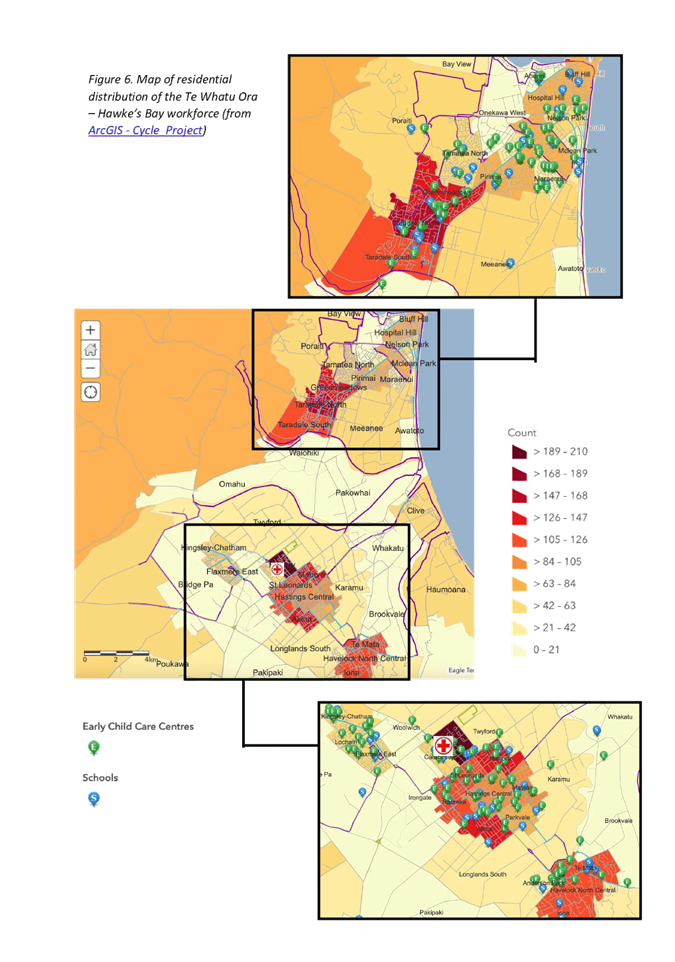
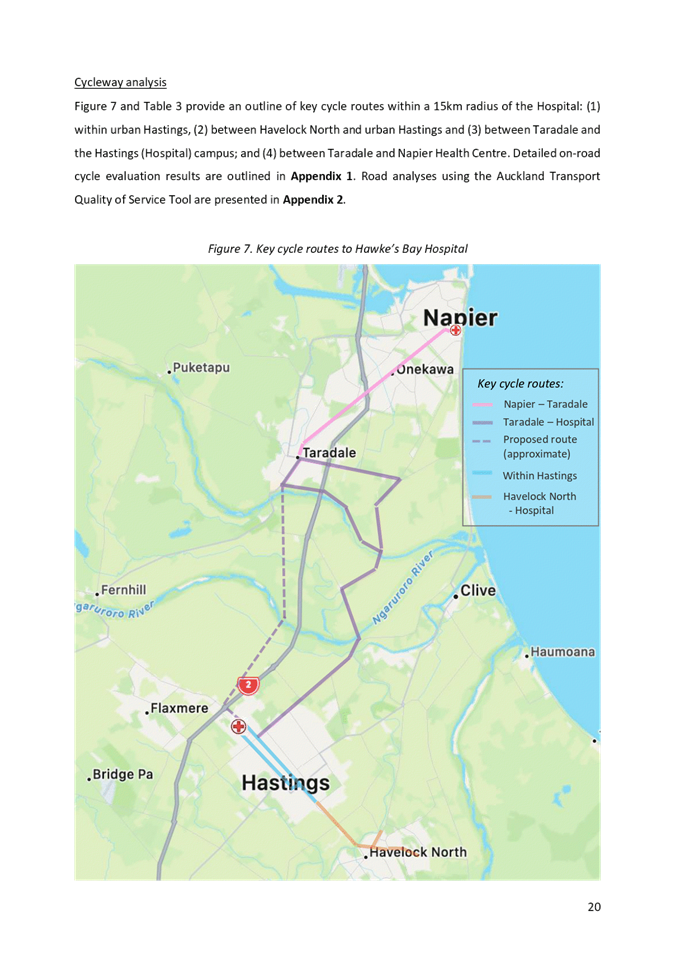
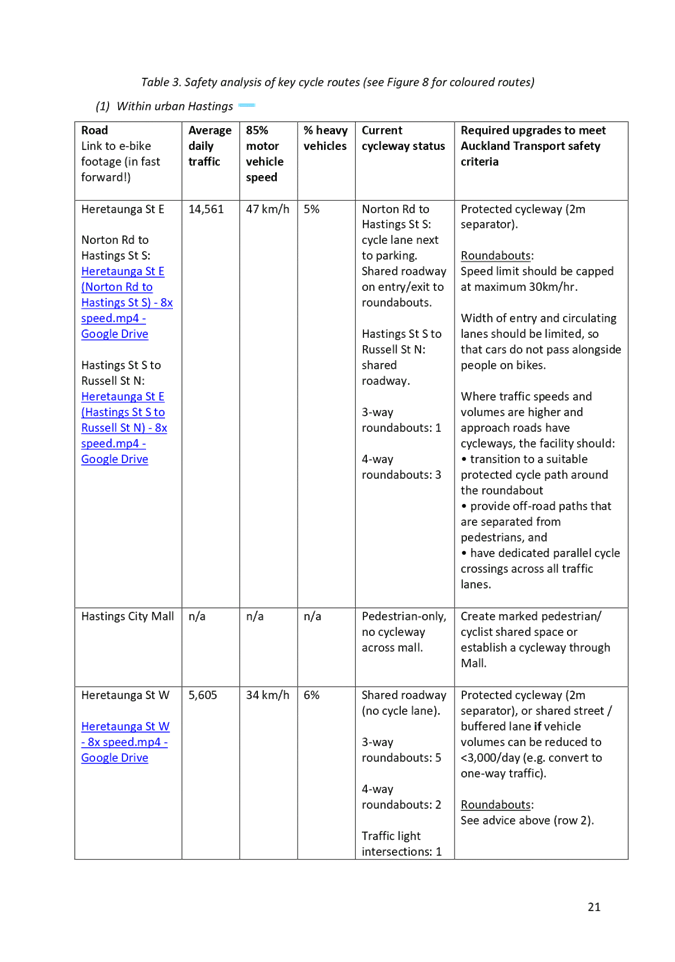
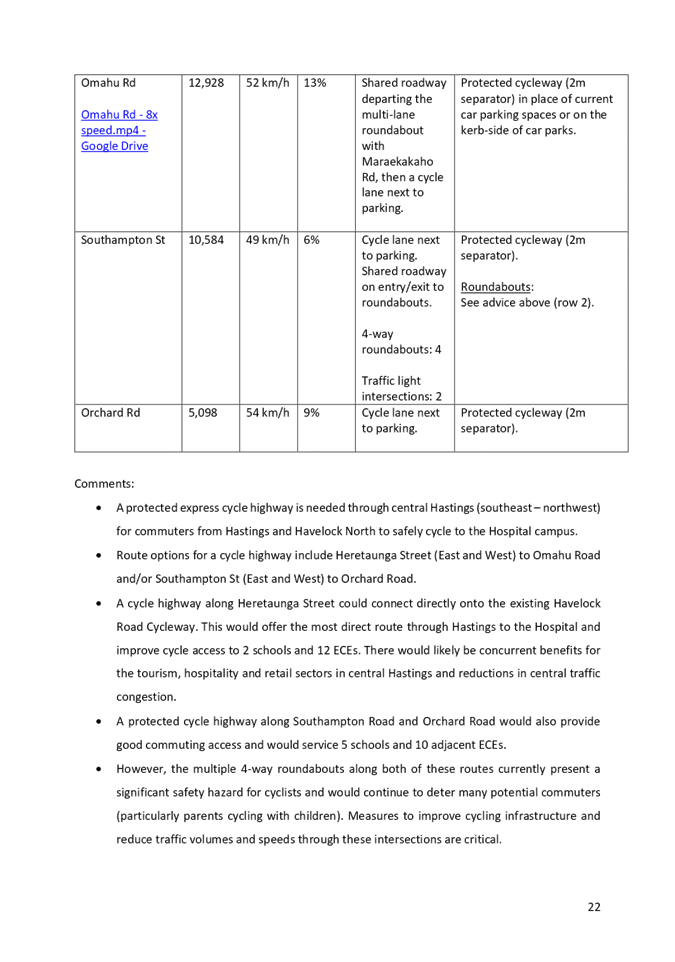
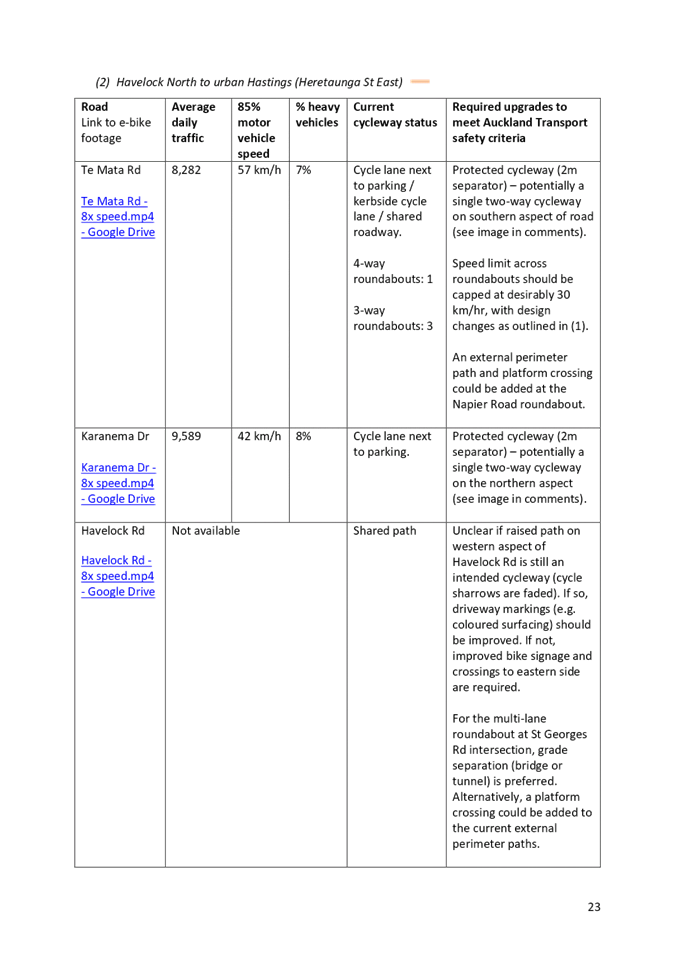
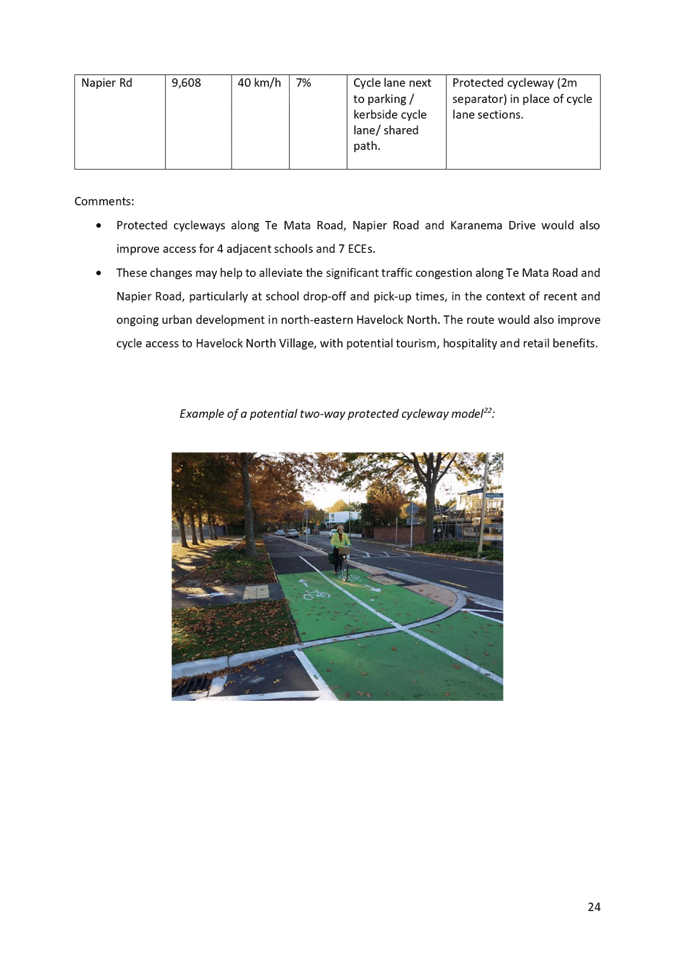
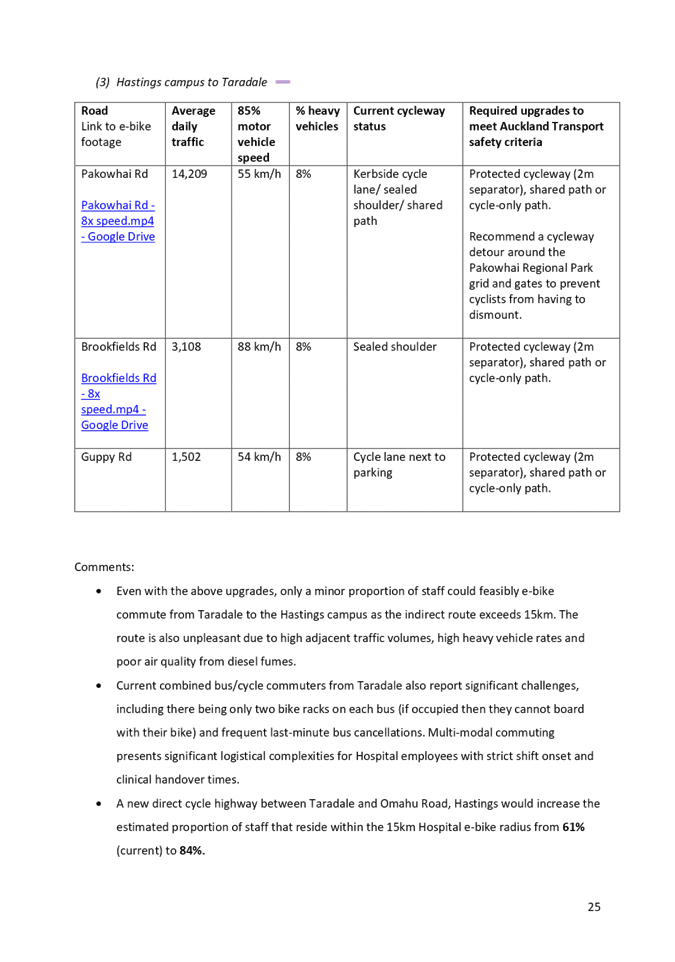
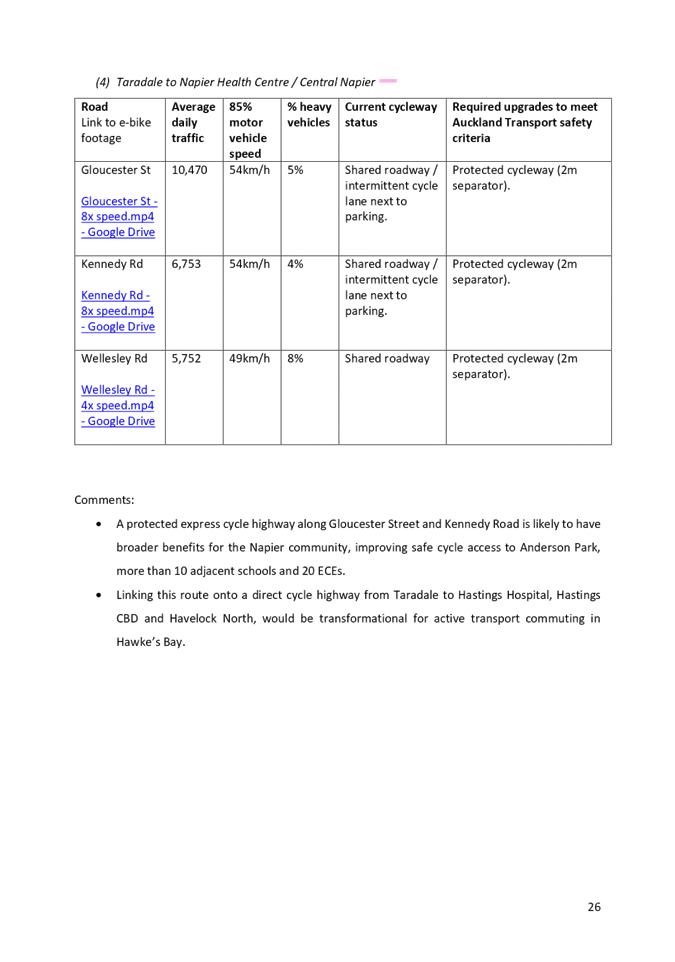
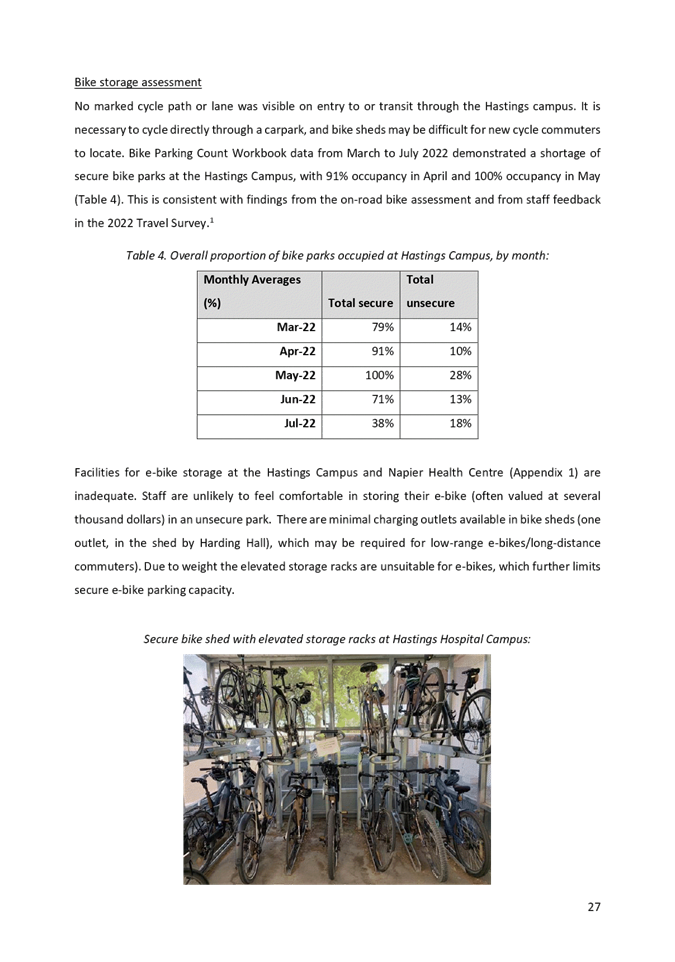
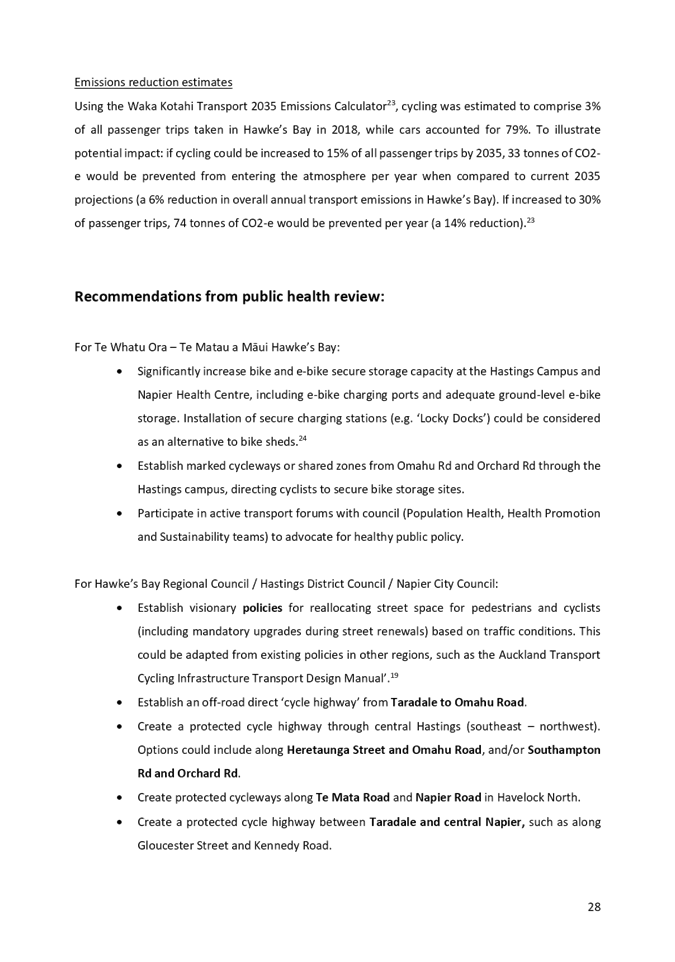

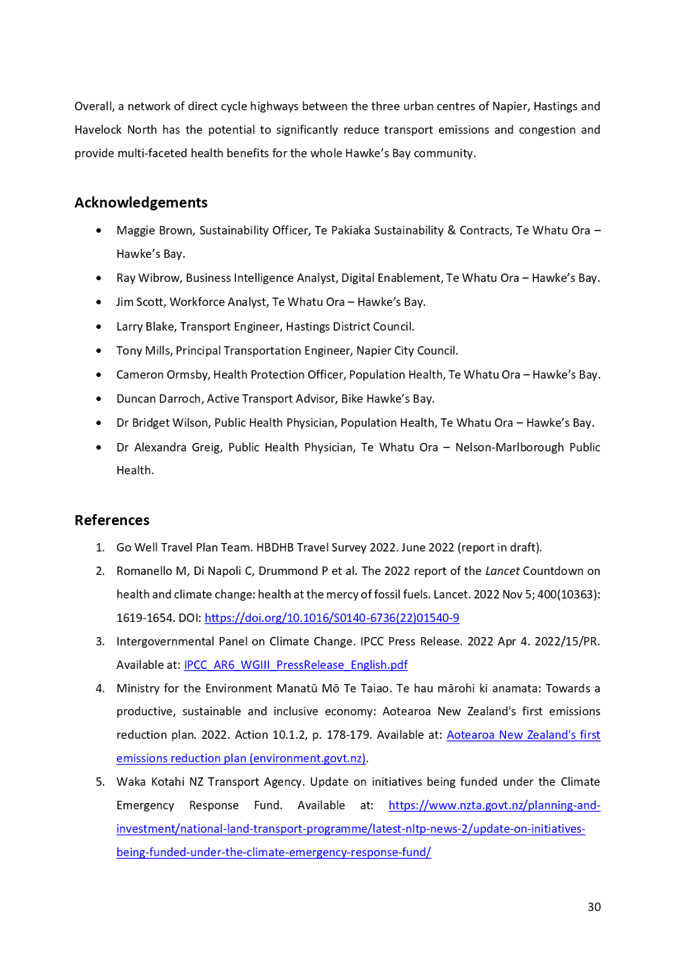
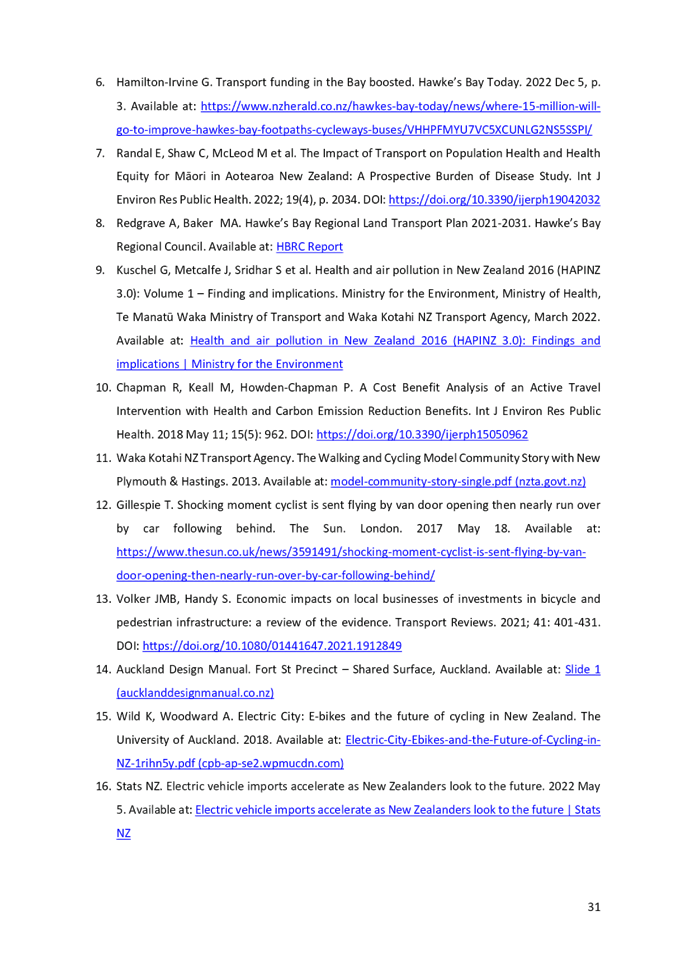
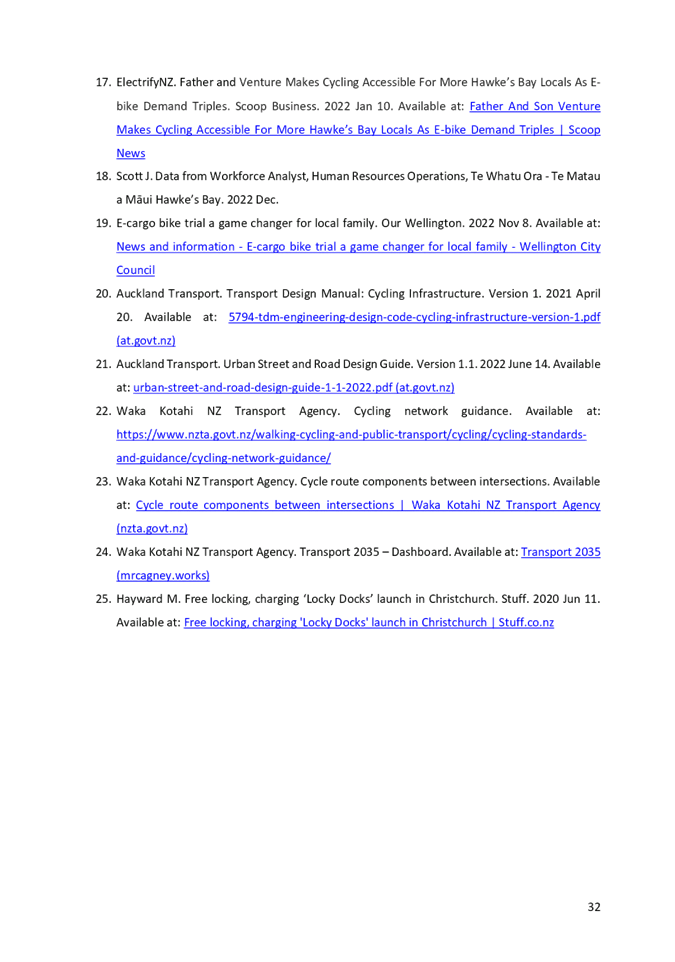
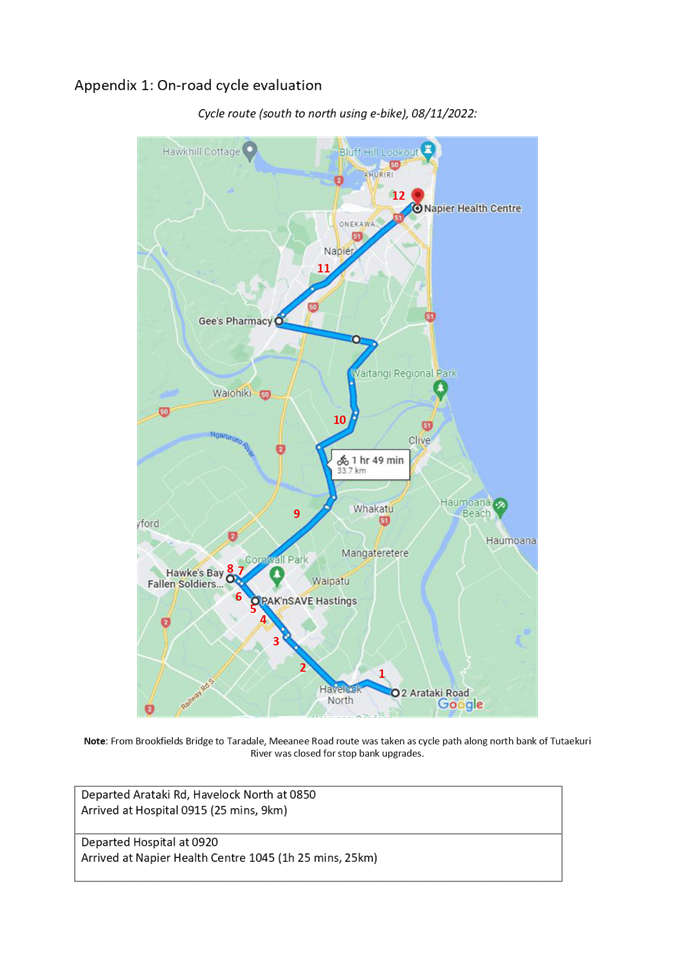
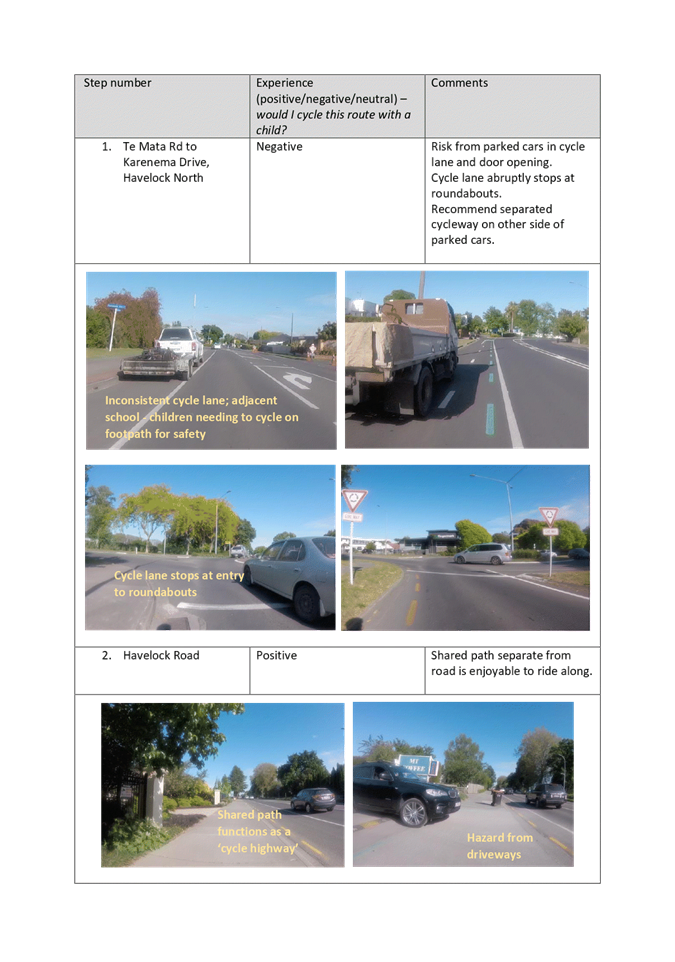
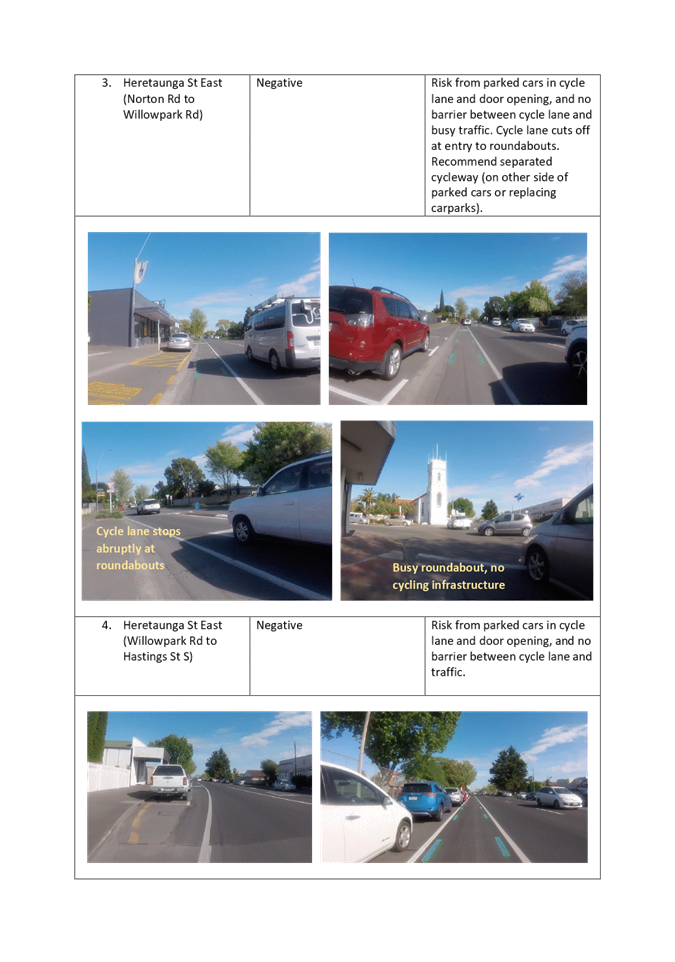
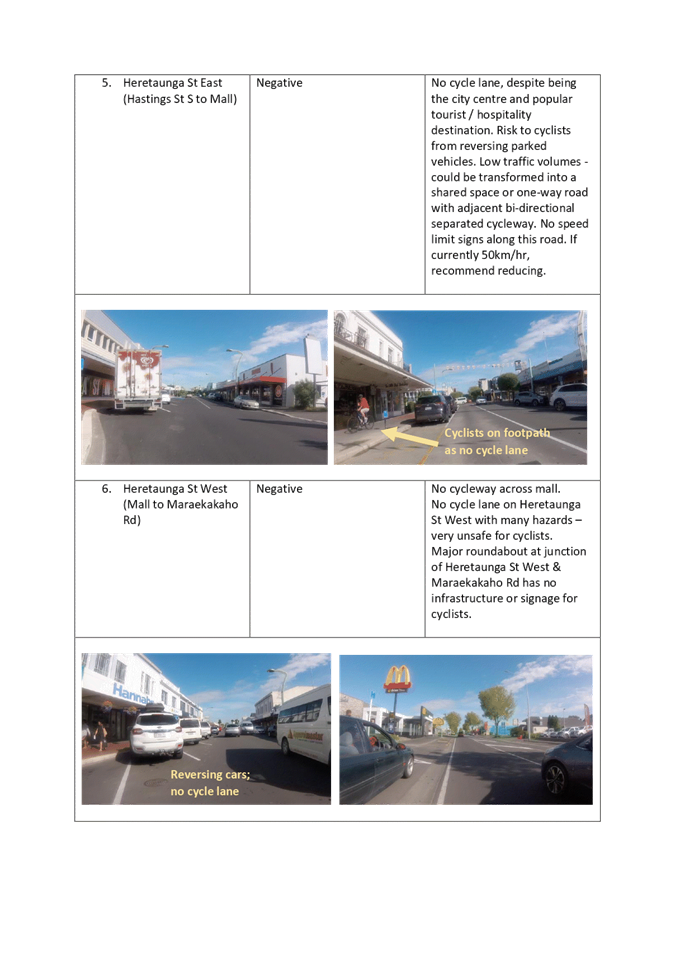
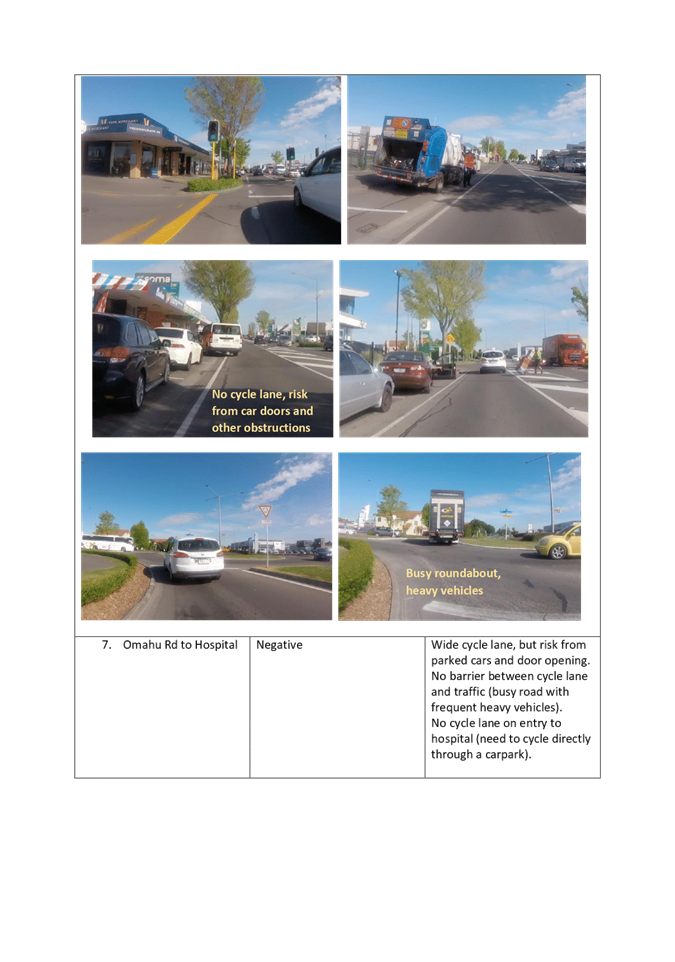
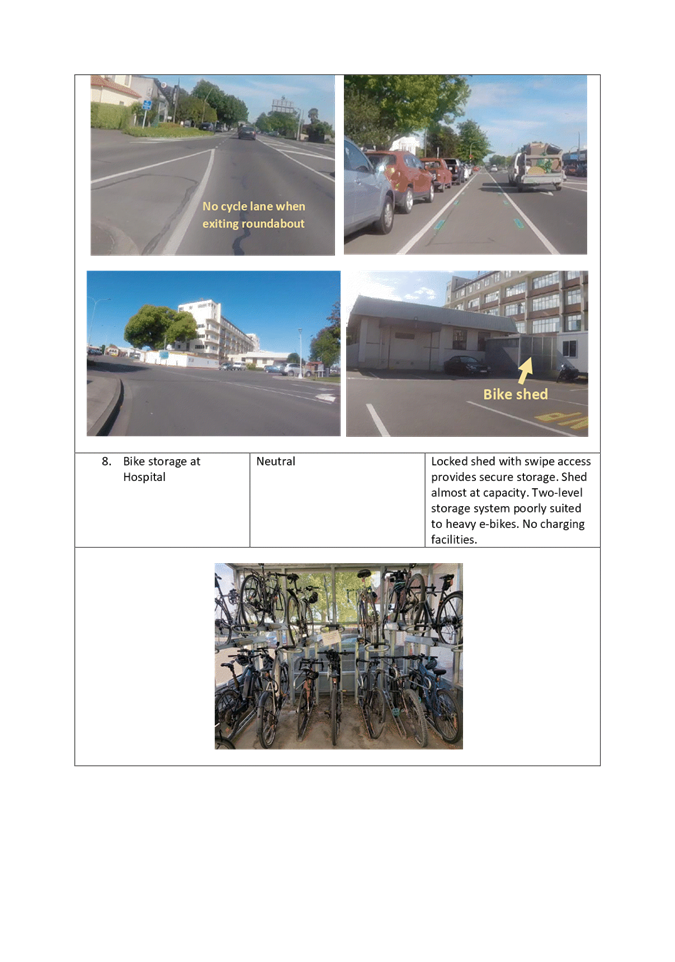
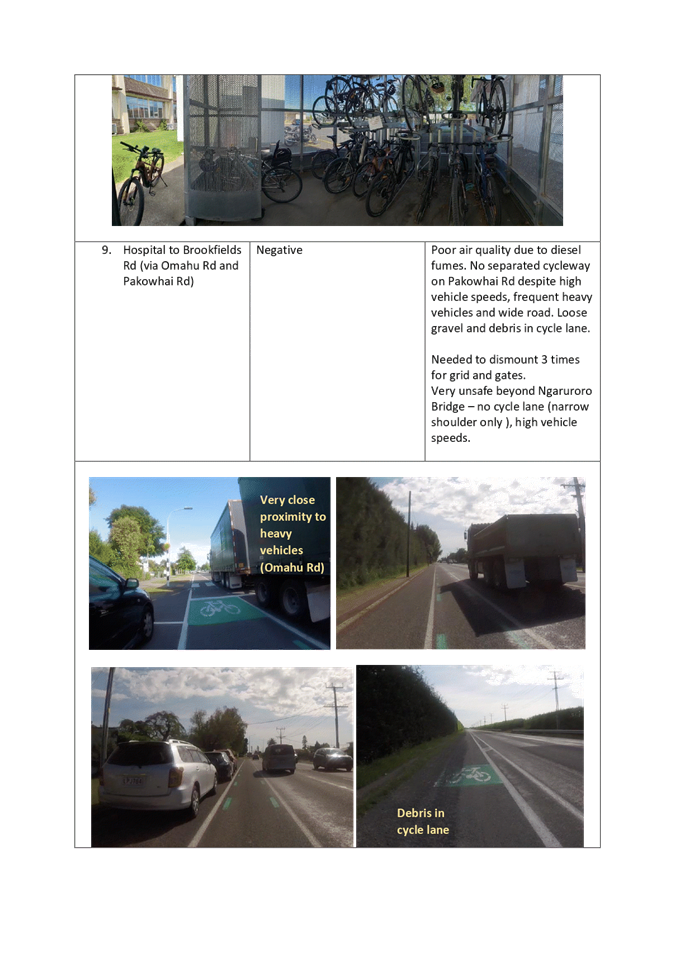
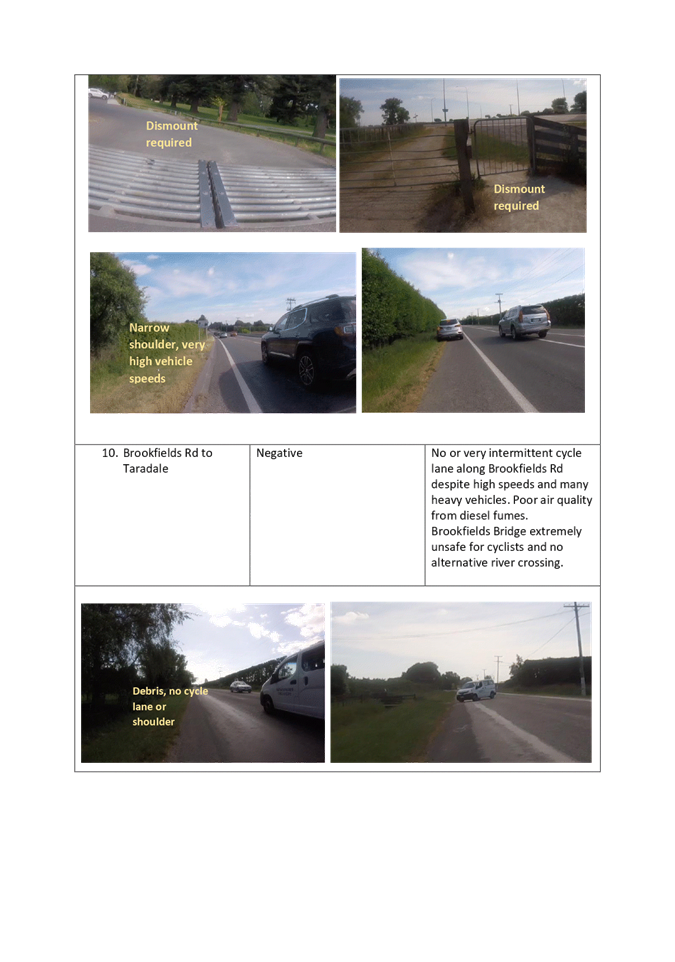
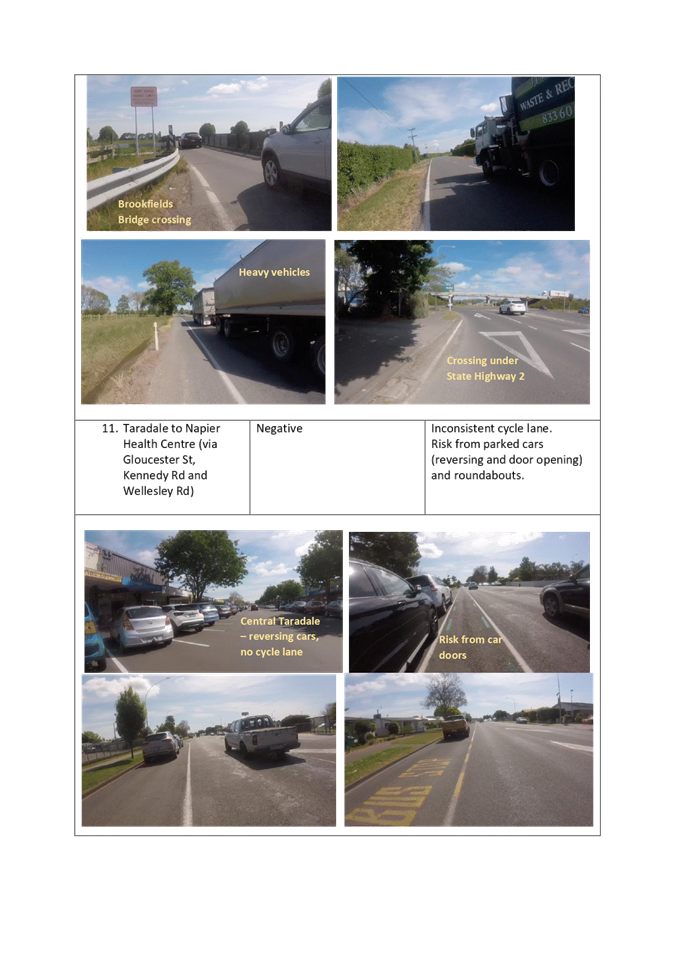
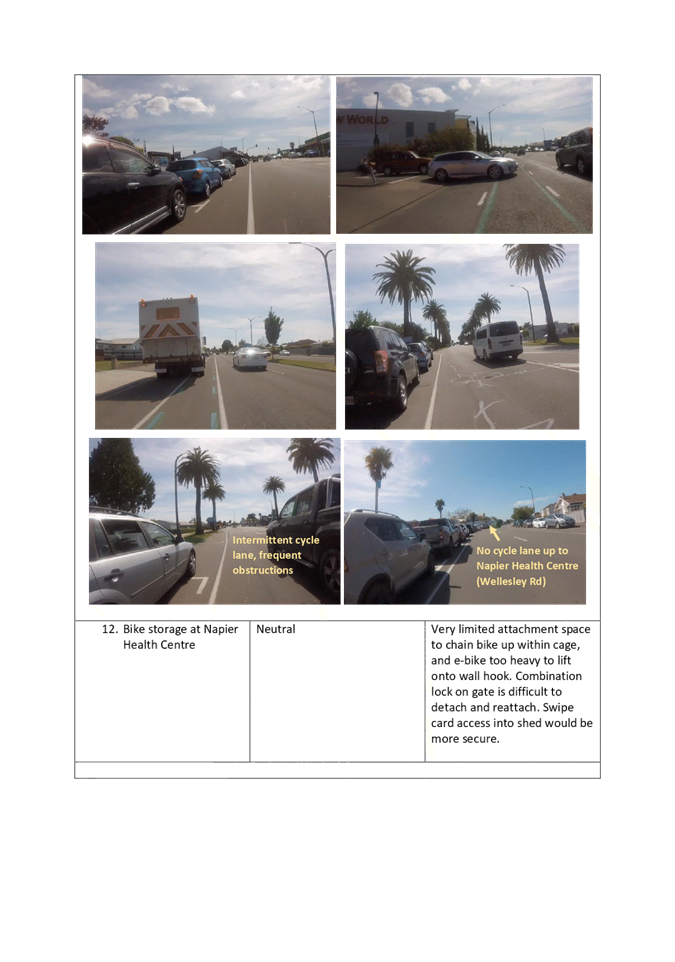

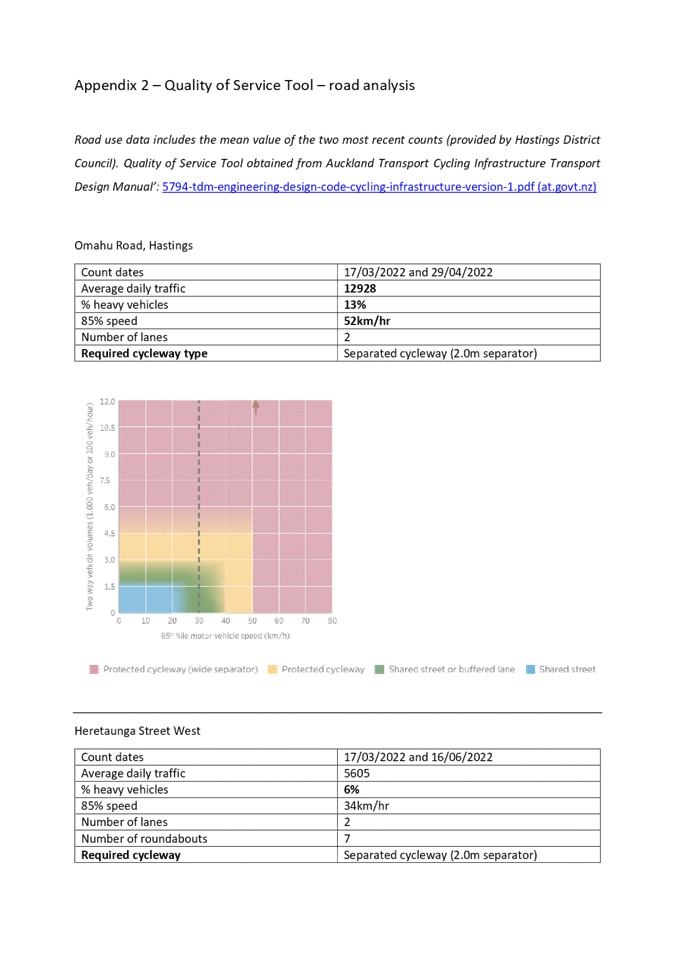
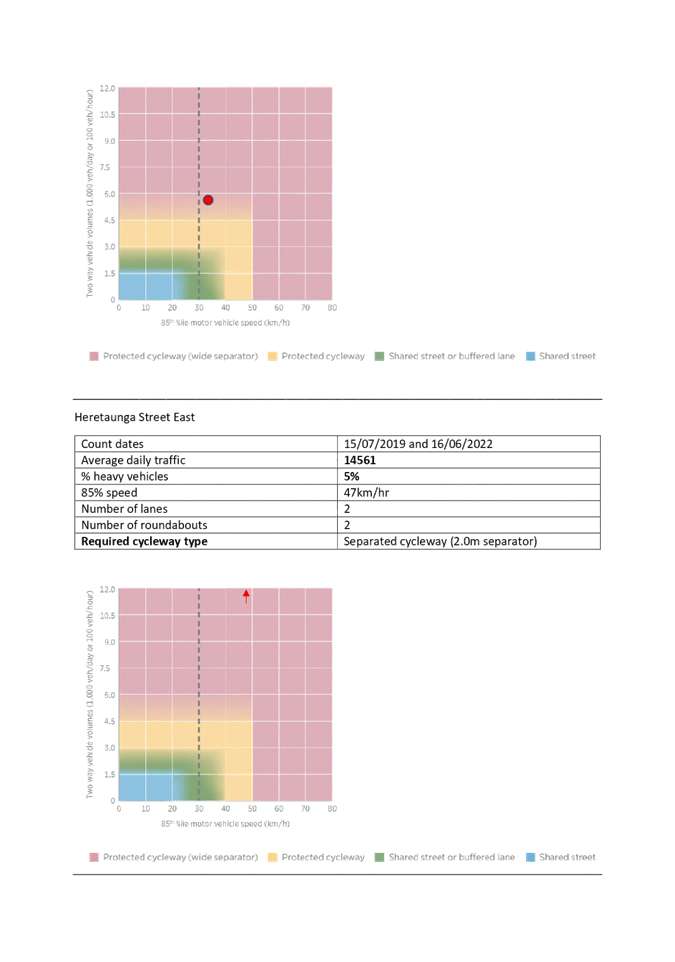
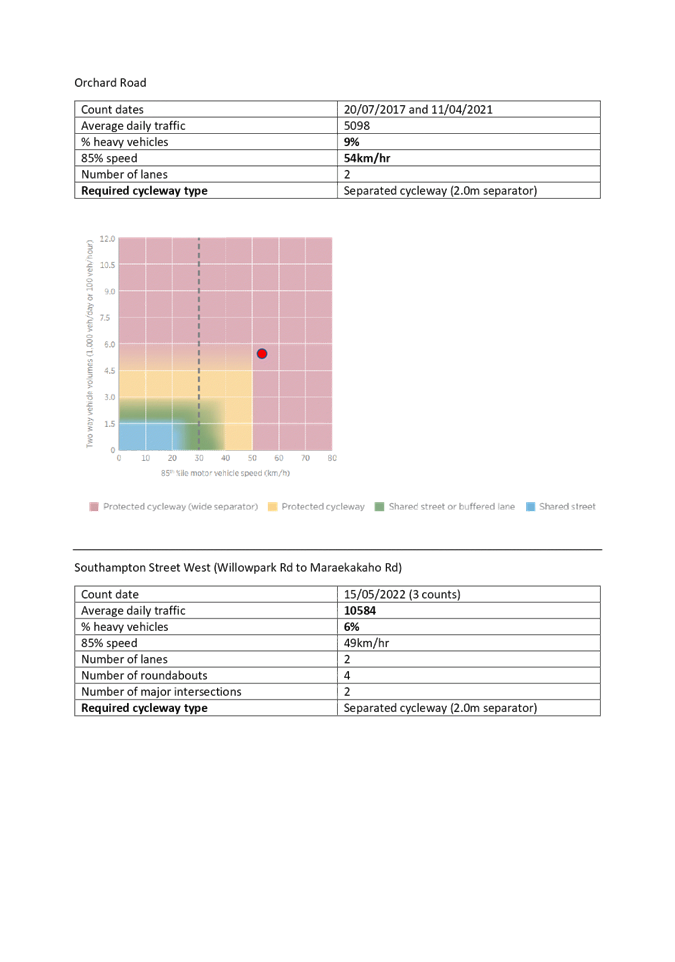
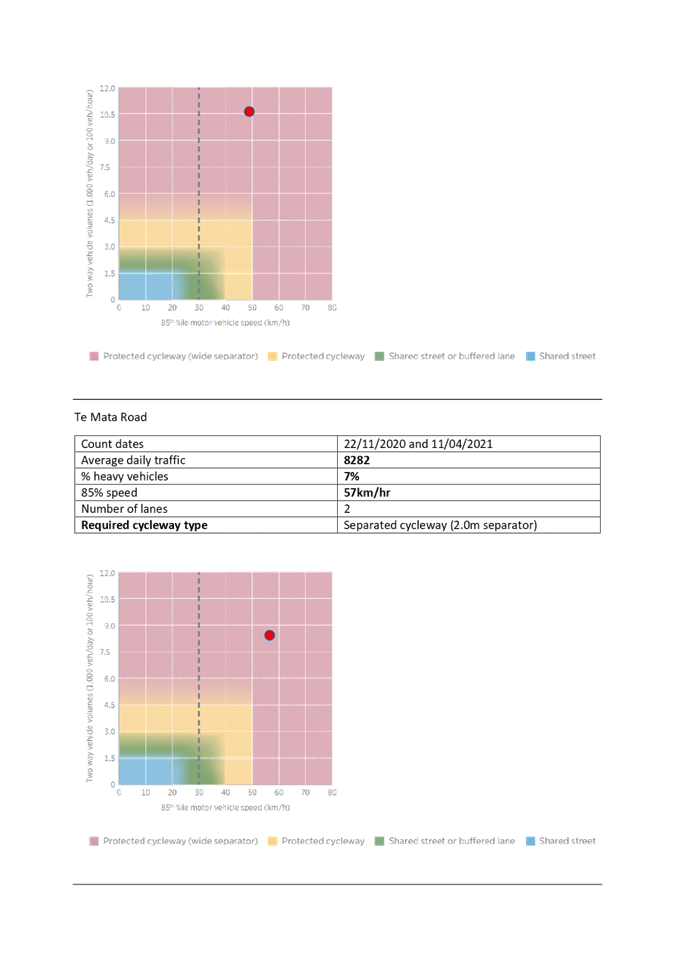
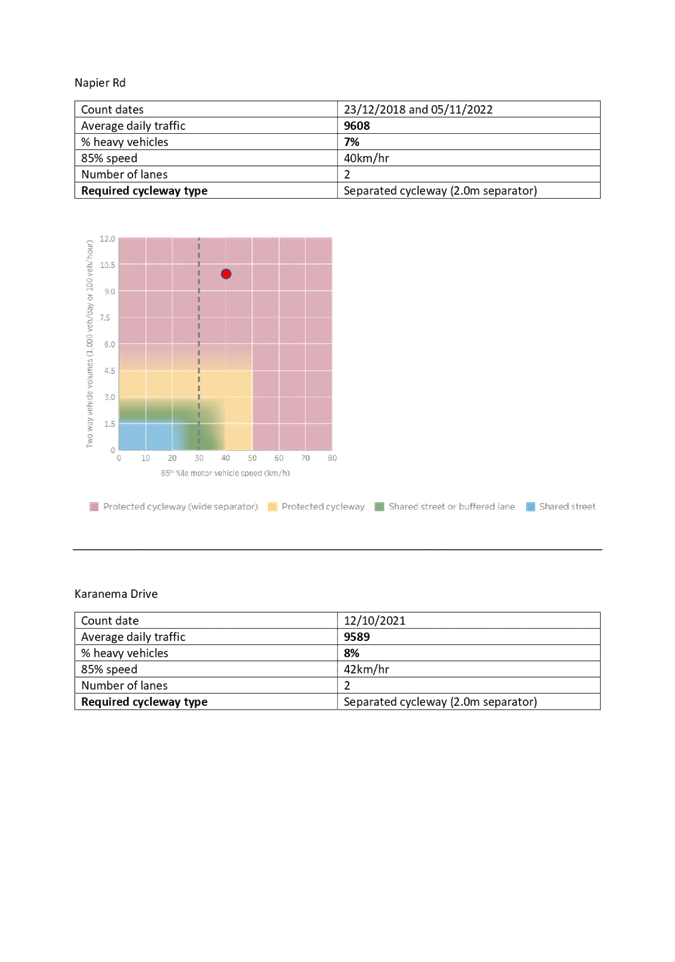
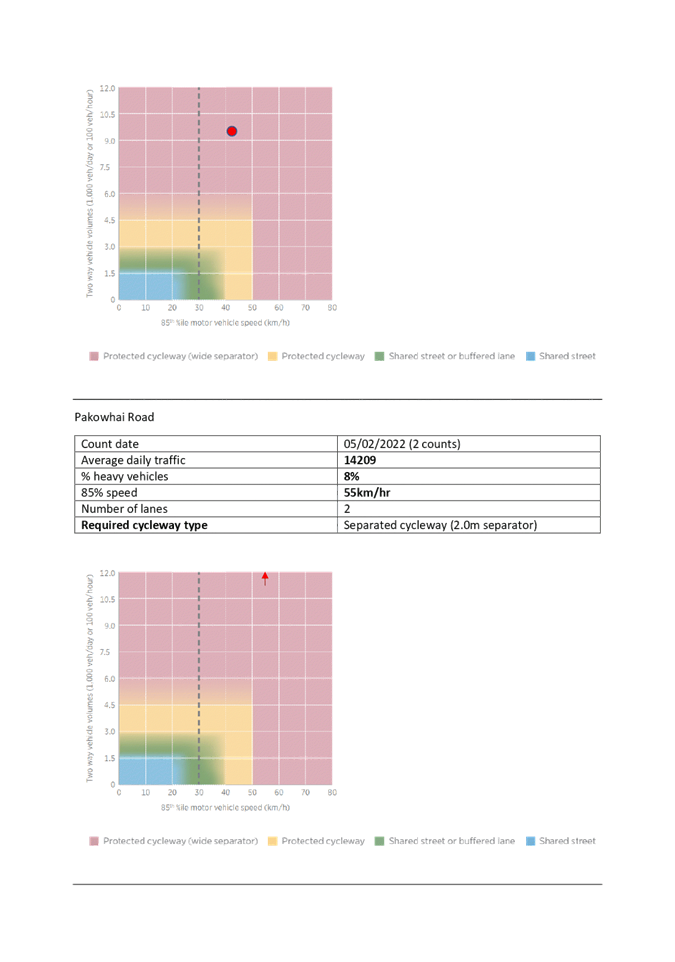
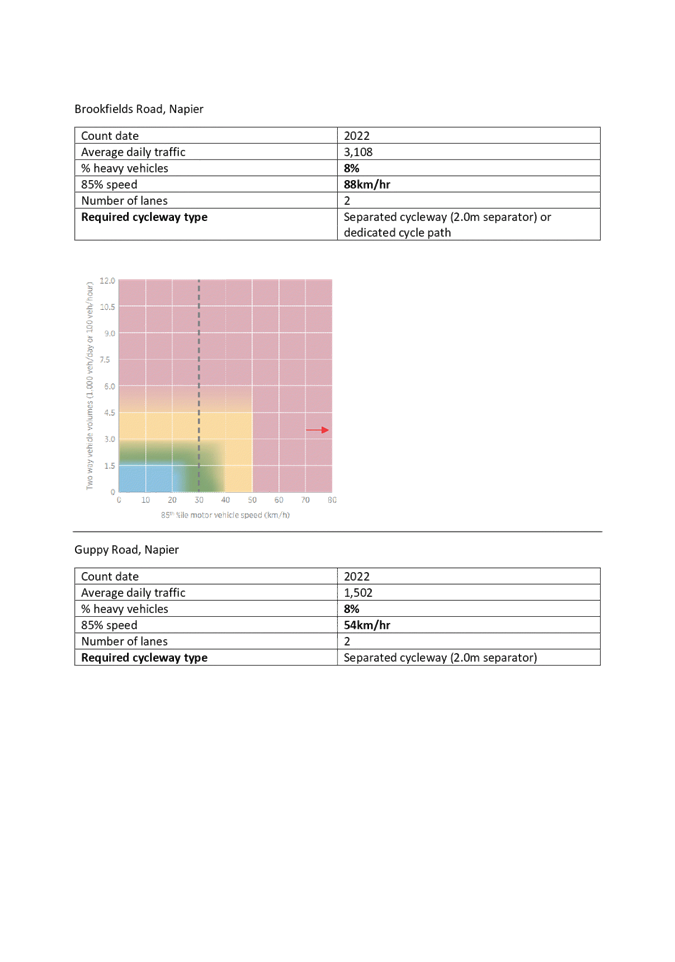
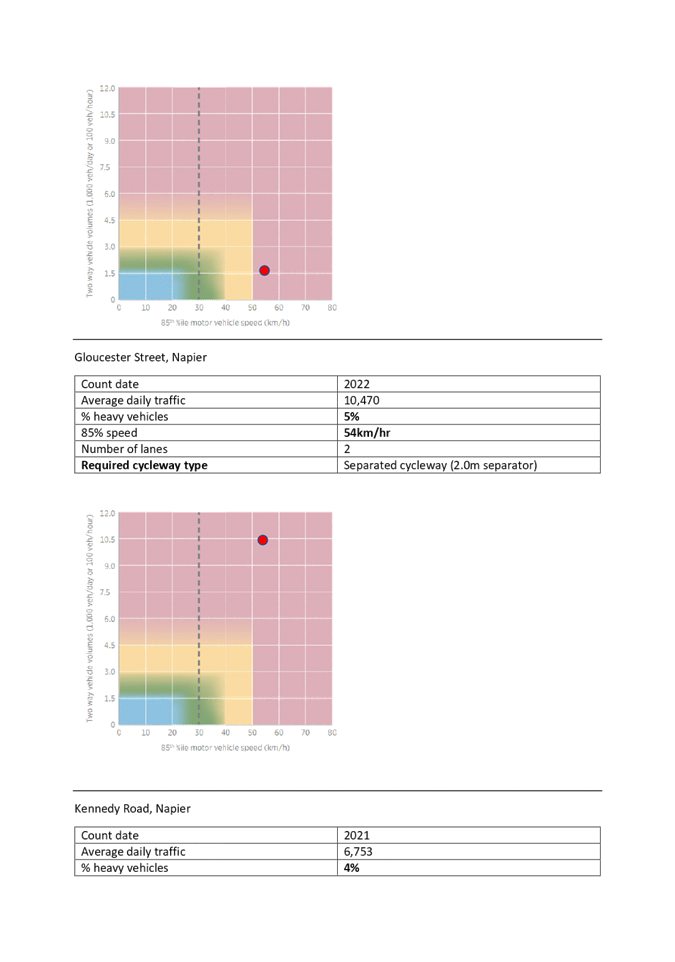
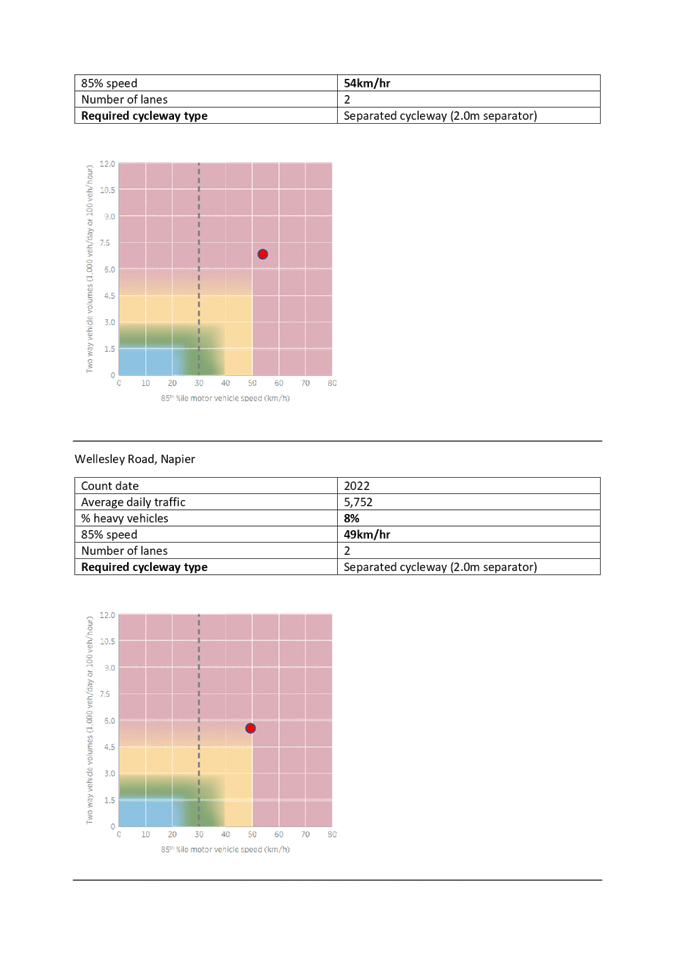
Hawke’s Bay Regional
Council
Regional
Transport Committee
Friday 10
February 2023
Subject:
Regional Land Transport Plan investment and delivery update
Reason for Report
1. This agenda item updates
the Committee on Regional Land Transport Plan investment and delivery.
Background
2. Regional land transport
plans (RLTPs) are six-year plans
that document the regions' land transport objectives, policies, and measures as
well as providing a statement of transport priorities for the region. The plans
incorporate programmes of regional land transport activities, including those
activities proposed for inclusion in the National Land Transport Programme.
They are reviewed after three years.
Discussion
RLTP 2024 timeline
3. In most cases Waka Kotahi
aims to adopt the National Land Transport Programme (NLTP) by 30 June of
the year immediately preceding the start of the NLTP.
4. This means that the final
RLTPs are required to be submitted to Waka Kotahi by 30 April of that year
(2024).
5. The date by which the final
RLTP must be published is usually set at 31 July of the start year of the RLTP.
6. Where development of the
NLTP is delayed, e.g., due to late release of the GPS, Waka Kotahi has until 31
August of the first year of the NLTP to adopt the NLTP.
7. As a consequence of such a
delay Waka Kotahi may adjust the deadlines for RLTP submission and publishing.
8. Hawke’s Bay Regional
Council aim to consult on the draft RLTP by November or December 2023. It is likely
the Regional Speed Management Plan (SMP) will be reviewed concurrently.
9. The Regional Technical
Advisory Group (TAG) will begin reviewing and developing the RLTP no later than
30 June 2023.
10. Prior to the review of the
RLTP, the TAG will have completed Investment Logic Mapping (ILM) and updated
the Regional Programme Business Case (PBC) that informs the review of the RLTP.
10.1. The ILM is in final draft
as of January 2023.
10.2. The PBC is due to be peer
reviewed and updated between March and May 2023.
RLTP
Investment Logic Mapping (ILM)
11. The TAG met twice in
December 2022 to workshop the ILM and develop the regional investment logic map
and benefits map in advance of requesting funding through the National Land
Transport Fund (NLTF).
12. The draft ILM (attachment
1) and Benefits Map (Appendix 2.) are included for comment.
Regional
Programme Business Case (PBC)
13. The Regional Transport
Committee (RTC) did not have an approved PBC ahead of the 2021 RLTP. The
document was completed as a Transport Study and had not been endorsed as a PBC
by Waka Kotahi. The document needs to be finalized based on Investment Quality
Assurance (IQA) feedback from Waka Kotahi.
14. The council and Waka Kotahi
have reviewed the scope of work outlined from the current draft programme
business case, to determine if there is any work outstanding with the current
contractor. Stantec are now undertaking a review of the work delivered in 2021
in accordance with the feedback from the IQA.
15. The PBC will need to be peer
reviewed and then updated ahead of the 2024 RLTP review.
16. The PBC needs to be
completed in the next six months to ensure the region is best placed to begin
reviewing the RLTP.
Technical
Advisory Group
17. The TAG now meets quarterly
with full-day agenda, made up of workstreams for each area of transport,
focussed on modes and outcomes. The workstreams are open to a wide range of
representatives, to ensure there is broad input into the transport outcomes.
The workstreams meet more regularly, ranging from monthly to bi-monthly
depending on the subject matter.
18. The TAG needs to represent
all land modes across all five transport outcomes. The workstreams are
representative of the activities undertaken by the Road Controlling Authorities
(RCAs) and the Council, as well as the transport outcomes set by the Ministry
of Transport (MoT). The workstreams include:
18.1. RLTP investment, delivery,
and development
18.2. Network resilience
18.3. Active Transport Strategy
18.4. Public Transport
Implementation
18.5. Road Safety Strategy
18.6. Emissions Reduction Plan
(Transport)
18.7. Speed Management Plan.
RLTP
investment and delivery issues
19. The TAG RLTP workstream has
not met since October 2022 due to the closedown period, ILM development, and
Speed Management Plan development.
20. Approved organisation RLTP
investment and delivery updates are currently being redeveloped based on
feedback and are not available this quarter. We will include them as items on
the agenda going forward, as a set of live documents with ongoing commentary.
These items will be talked to by each territorial authorities’ elected
member discussion.
Decision Making Process
21. Staff have assessed the
requirements of the Local Government Act 2002 in relation to this item and have
concluded that, as this report is for information only, the decision-making
provisions do not apply.
Recommendation
That
the Regional
Transport Committee receives and notes the Regional Land Transport Plan
investment and delivery update staff report.
Authored by:
|
Bryce Cullen
Transport Strategy &
Policy Analyst
|
Katie Nimon
Transport Manager
|
Approved by:
|
Katrina Brunton
Group Manager Policy &
Regulation
|
|
Attachment/s
|
1⇩
|
HBRC RLTP Investment Logic Mapping
|
|
|
|
2⇩
|
HBRC RLTP Draft Benefits Map
|
|
|
|
HBRC RLTP Investment Logic Mapping
|
Attachment
1
|
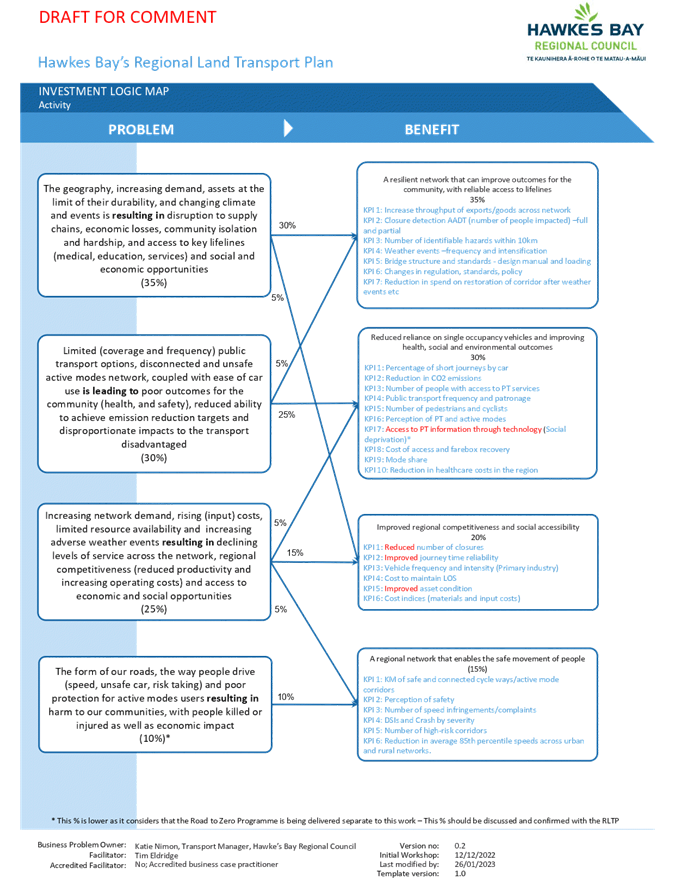
|
HBRC RLTP Draft Benefits Map
|
Attachment
2
|
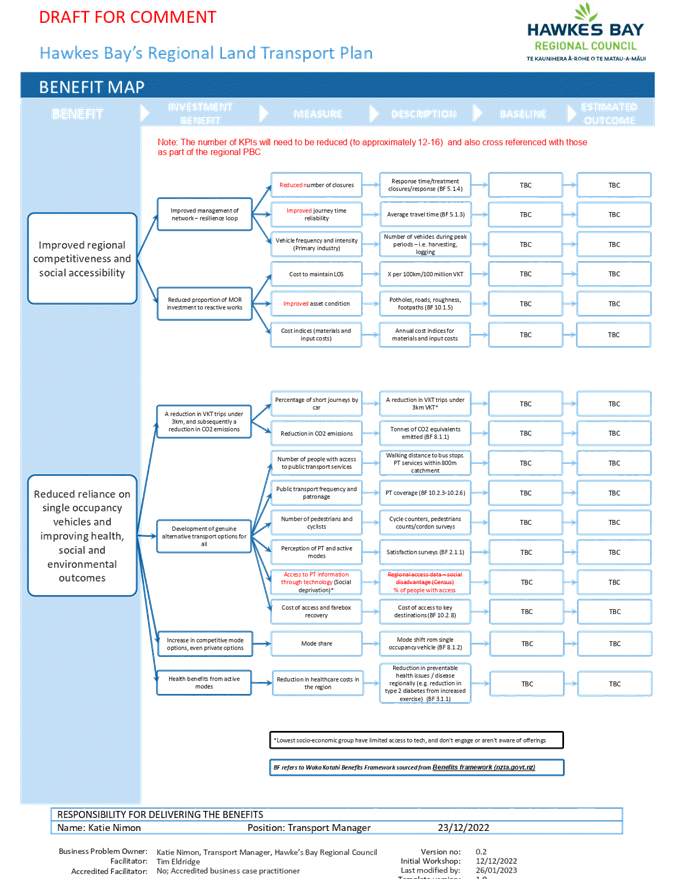
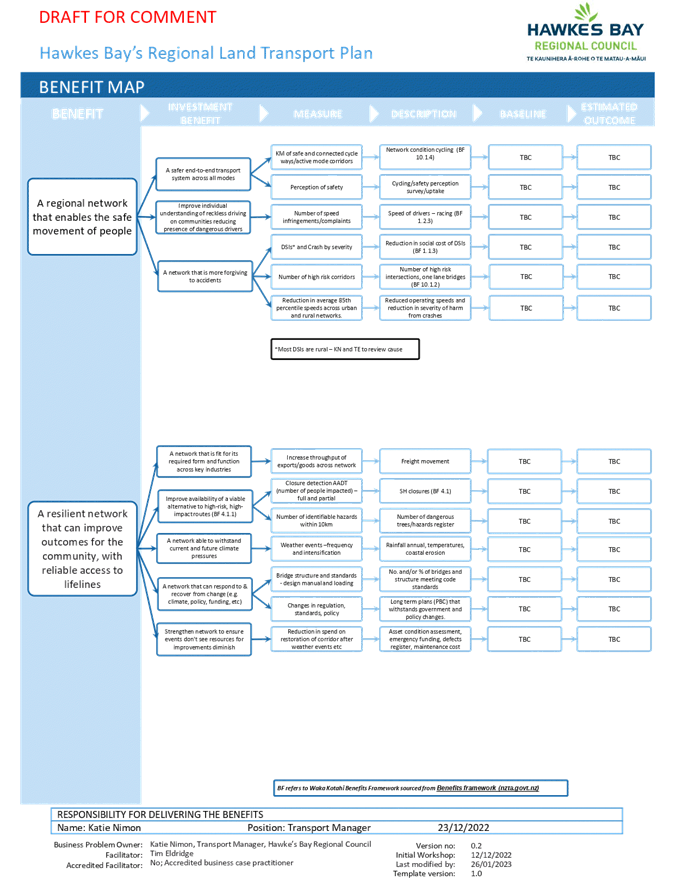
Hawke’s Bay Regional
Council
Regional
Transport Committee
Friday 10
February 2023
Subject:
Transport Emissions Reduction Plan update
Reason for Report
1. This repot provides the
Regional Transport Committee with an update on the Transport Emissions
Reduction plan.
Executive Summary
2. Hawke’s Bay Regional
Council is developing a transport emissions reduction plan which will form a
chapter of the Regional Emissions Reduction Plan.
3. The transport emissions
reduction plan will be informed by the community carbon footprint 2022 and will
direct the focus and efforts to set plans and targets for emissions reduction.
The plan will be developed through a series of workshops consisting of
transport staff, subject matter experts, and a working group of practitioners,
focusing on objectives and practical solutions.
Background
4. Emissions reduction across
transport modes is a clear focus area coming from central government. A
national emissions reduction plan has been developed with clear targets and
indicative enablers. A working group of practitioners and subject matter experts
has been convened to develop an emissions reduction plan for the Hawke’s
Bay region.
5. The plan is being led by
Pippa McKelvie-Sebileau, Climate Action Ambassador at Hawke’s Bay
Regional Council. The working group meetings are chaired and facilitated by Pippa,
Heather Bosselmann from Napier City Council, and Taylor Eubanks from Hastings
District Council.
6. The Transport Emissions
Reduction Plan will form a chapter of the Hawke’s Bay Emissions Reduction
Plan.
Discussion
7. A National Emission
Reduction Plan has been developed by the Ministry for the Environment, focusing
on reducing emissions across the New Zealand economy. A range of evidence-based
targets have been developed across all major emissions generating sectors of
New Zealand.
8. Many of the actions in the
National Emissions Reduction Plan have relevance for local government. We are
developing a regionally specific emissions reduction plan (the plan), echoing
the national plan, and setting out actions to reduce emissions across a complex
array of industries and modes within the region.
9. Primary industry forms a
large part of the Hawke’s Bay economy, naturally requiring a significant
heavy transport industry to support existing operations and growth aspirations.
The primary industry in Hawke’s Bay is experiencing ongoing growth, with
more expected. Inevitably, this will result in the increased movement of goods.
A growing need exists to support and enable this growth whilst actively
reducing emissions.
10. The residential population
in Hawke’s Bay continues to grow. This continued increase in population,
coupled with a car-centric culture and a need to travel across a geographically
dispersed region for work and leisure has supported a steady increase in journeys
for a range of purposes, both short and long. Therefore, vehicle kilometers
travelled, and transport emissions have increased.
11. In September 2022, the
first community carbon footprint was released identifying the sources of
greenhouse gas emissions in the region. Transport emissions account for 20% of
the regional footprint. An additional transport emissions analysis was
commissioned to identify sources from private / commercial vehicles and on-road
/ off-road emissions. This granular analysis showed that cars make up 51% of
total emission, while commercial vehicles make up 46%, and buses the remaining
3%. Interestingly, on an tonnes of C02 emitted per vehicle kilometer travelled
basis, buses were ranked the highest, ahead of heavy commercial vehicles. The
community carbon footprint can be found in attachment 1.
12. A working group of
practitioners has been established, led by Pippa McKelvie-Sebileau, to develop
the Hawke’s Bay emissions reduction plan. The plan is being developed
through a series of intensive, targeted workshops held monthly. Each workshop
focuses on a specific chapter of the national plan and seeks to tease out the
options and opportunities for Hawke’s Bay. Each workshop seeks to develop
a series of aspirational, measurable, and tangible actions to support emissions
reduction in our region.
13. The transport emissions
reduction plan will form a chapter of the regional plan and be developed by
council officers and subject matter experts, as required.
14. It is intended that a first
draft of the regional plan, including the transport chapter, is completed by
June 2023. This will enable alignment with territorial authority long term
planning (LTP) cycles, giving the opportunity for actions and outputs from the
draft plan to be included in LTP cycles. It is important to note that the draft
plan will be open to changes and builds.
Next Steps
15. Two workshops will be held
to develop and advance the transport chapter of the plan, focusing on the
national targets in a Hawke’s Bay context and seeking to identify options
and opportunities for the region. The first workshop is scheduled for 28 March
with the core group of practitioners and transport staff from all councils. The
second workshop is scheduled for 3 April with the full working group of
practitioners, convened by Pippa McKelvie-Sebileau, and transport staff from
each TA.
16. Several detailed planning
and preparation sessions will be held ahead of the scheduled workshops to
review the national plan, examine draft plans from other regions, and develop
some indicative options of best fit for Hawke’s Bay.
Decision Making Process
17. Staff have assessed the
requirements of the Local Government Act 2002 in relation to this item and have
concluded that, as this report is for information only, the decision-making
provisions do not apply.
Recommendation
That the Regional Transport Committee receives
and notes the Transport Emission Reduction Plan update staff report.
Authored by:
|
Bryce Cullen
Transport Strategy & Policy
Analyst
|
|
Approved by:
|
Katrina Brunton
Group Manager Policy &
Regulation
|
|
Attachment/s
|
1⇩
|
Transport Emissions Reduction
Community Carbon Footprint 2022
|
|
|
|
Transport Emissions Reduction Community
Carbon Footprint 2022
|
Attachment
1
|
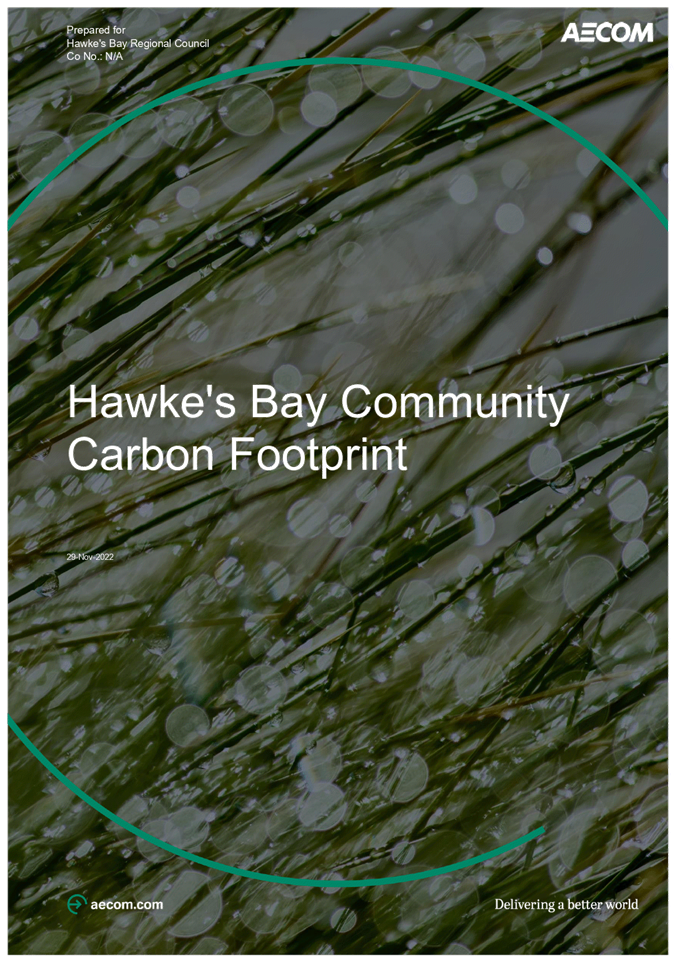

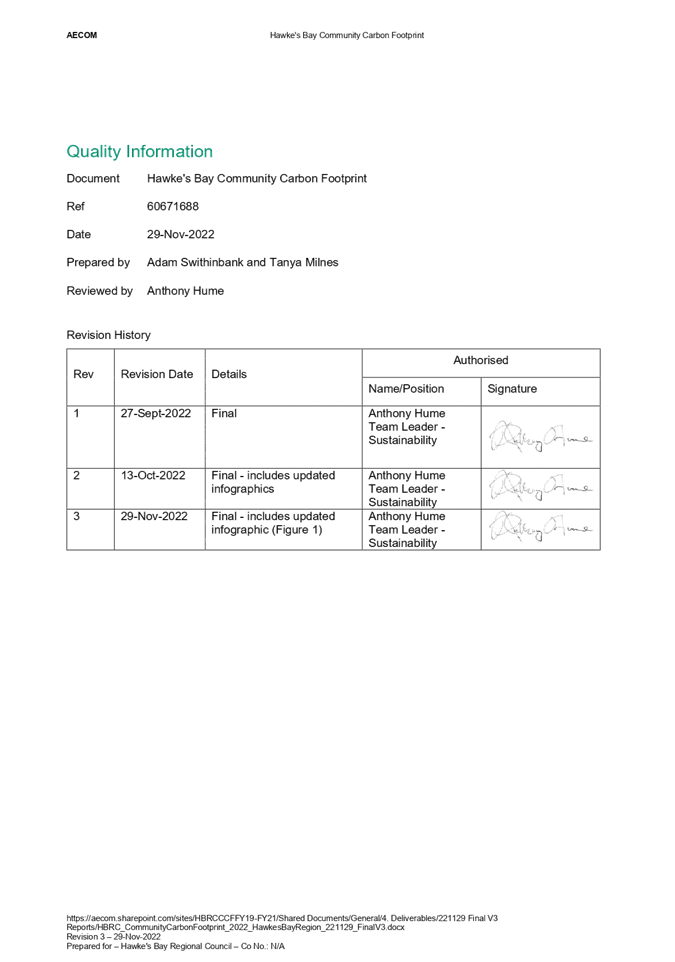
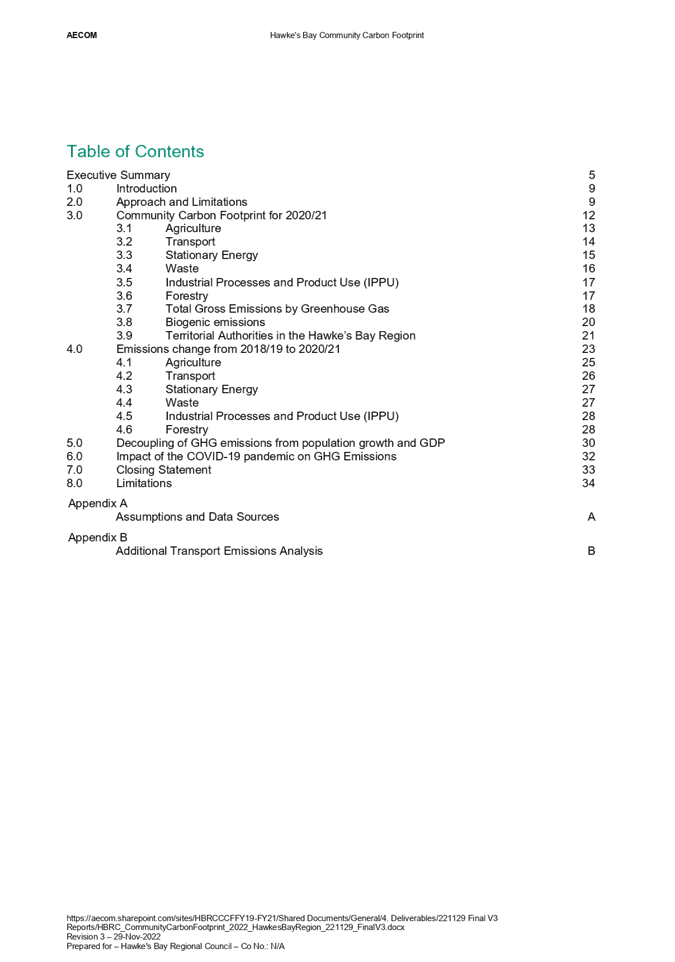
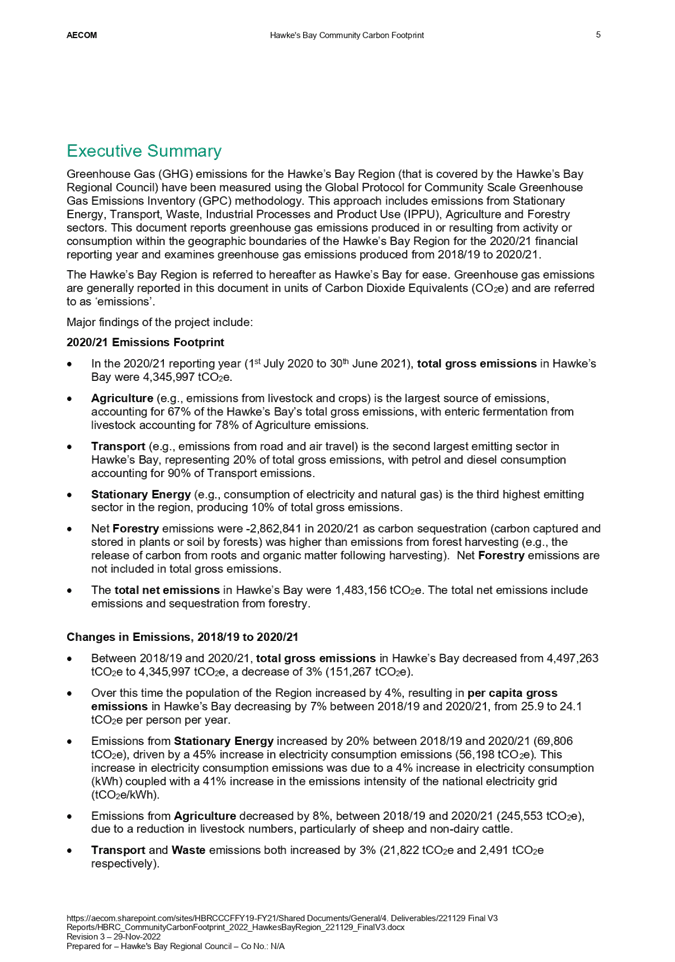

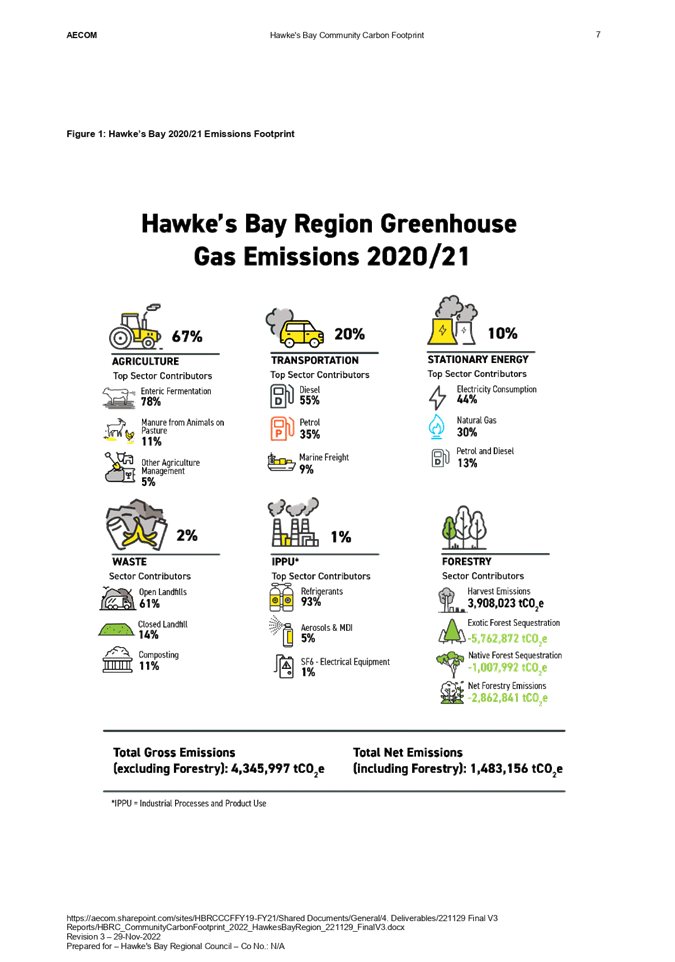
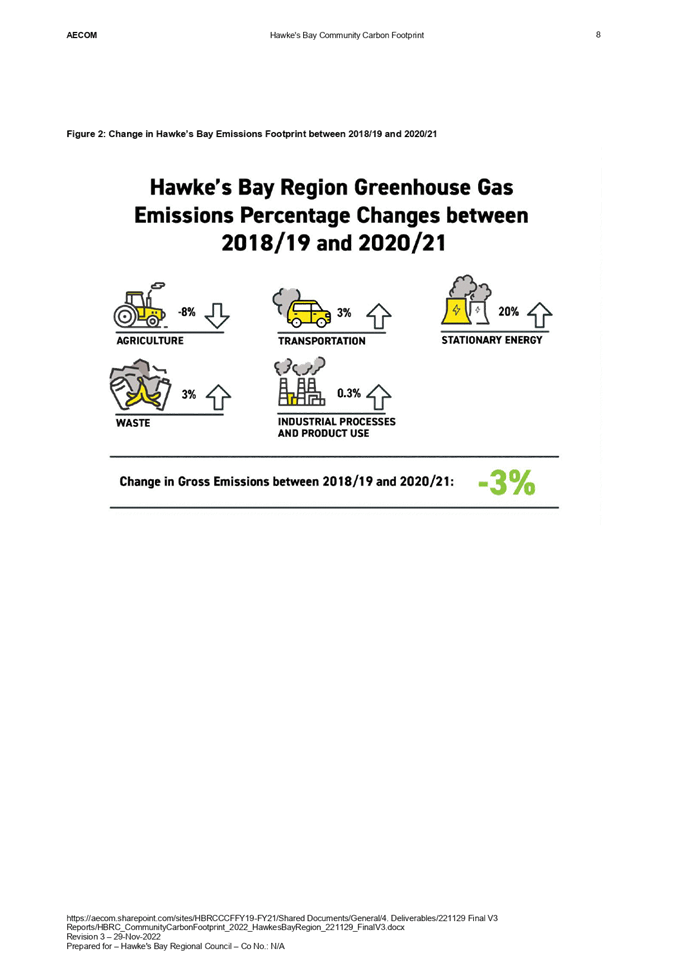
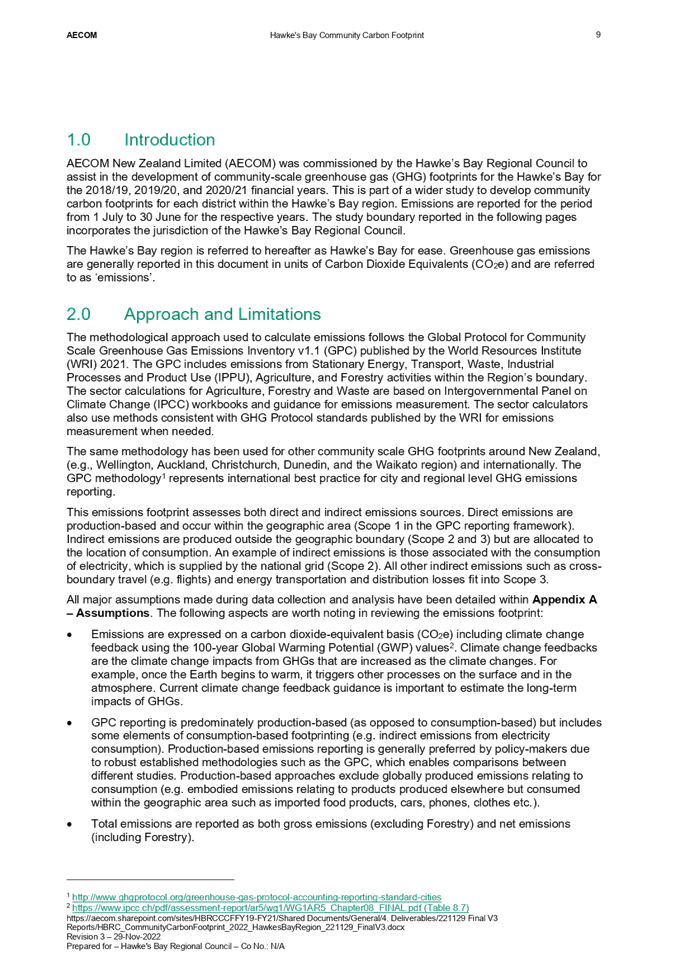
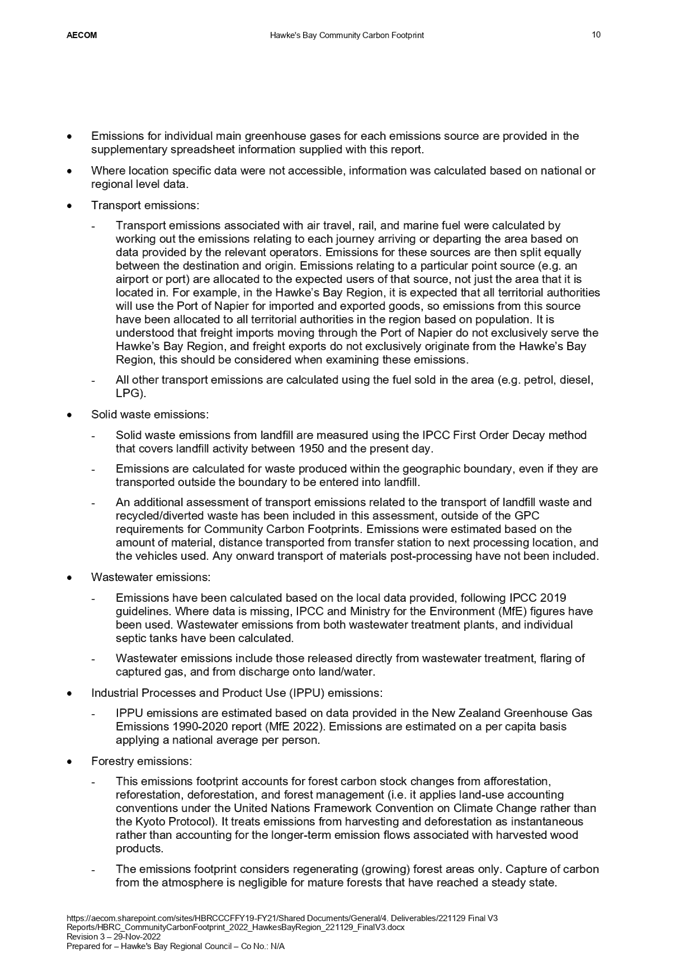

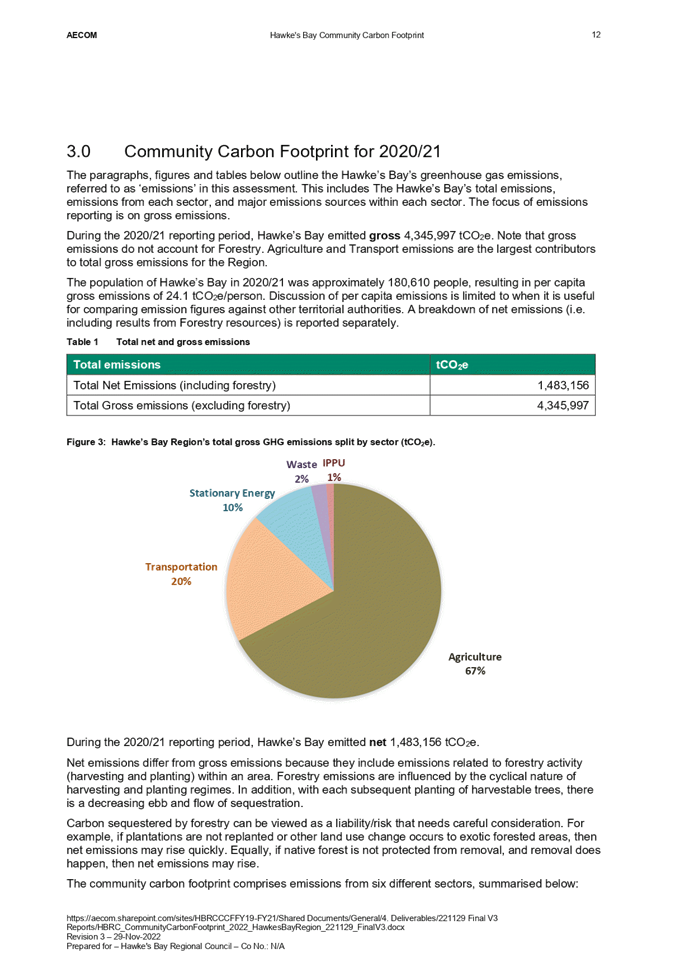
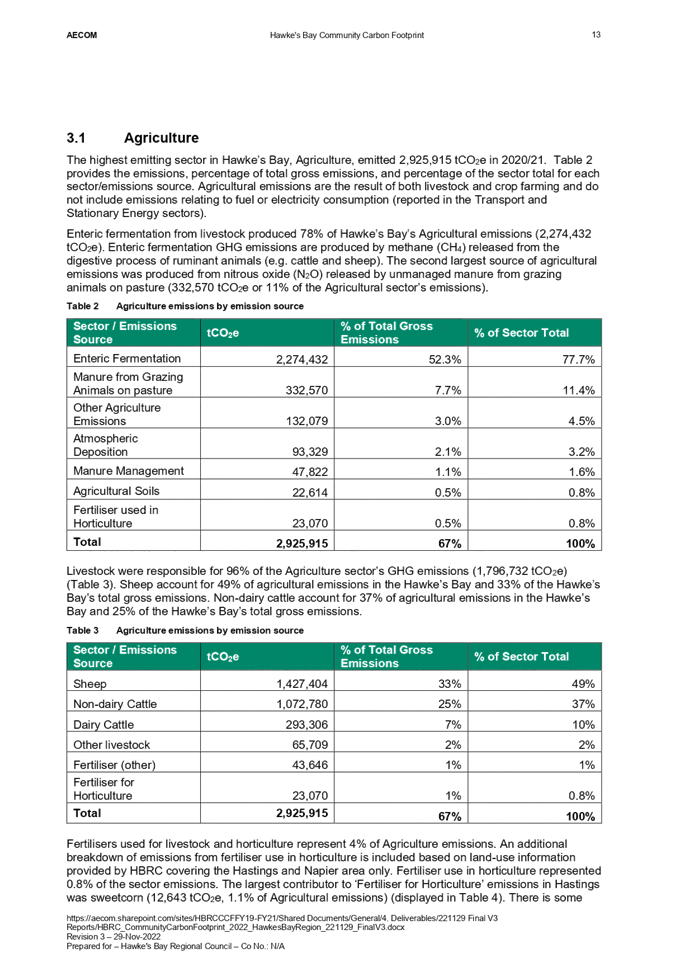
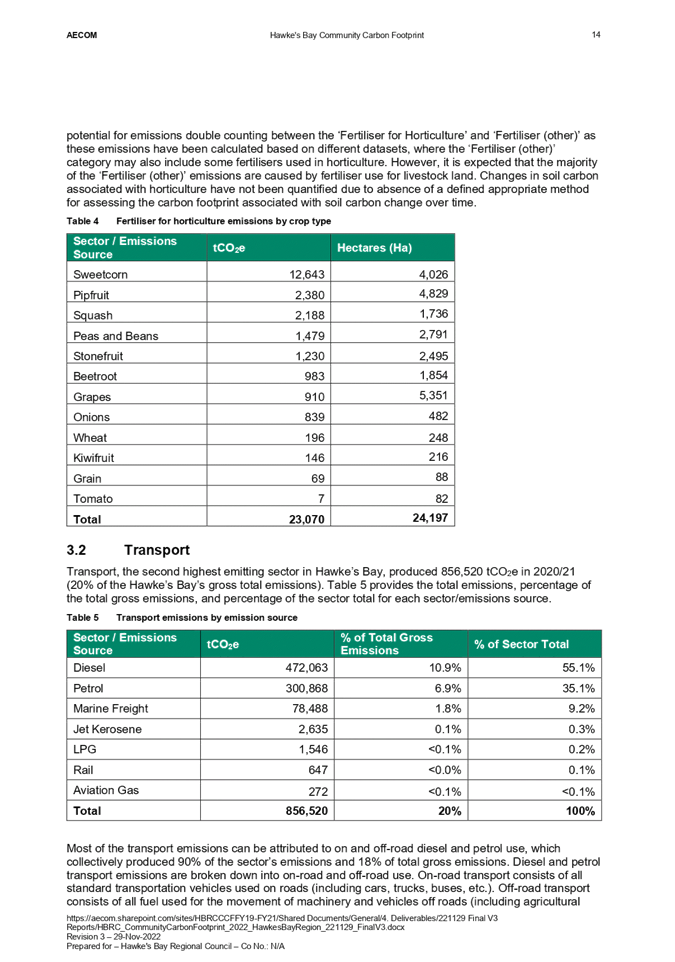
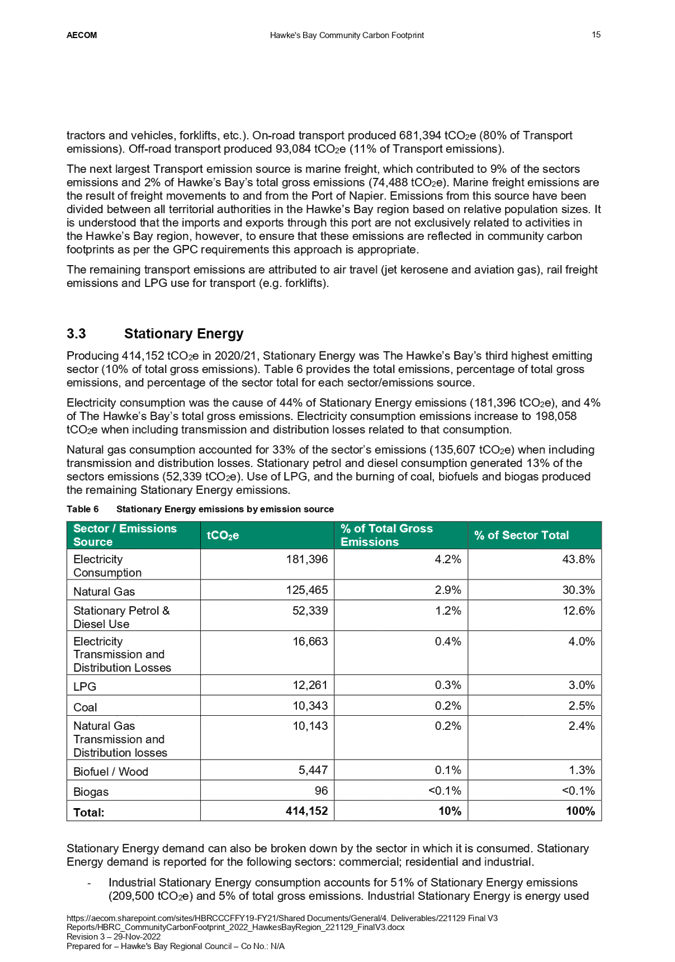
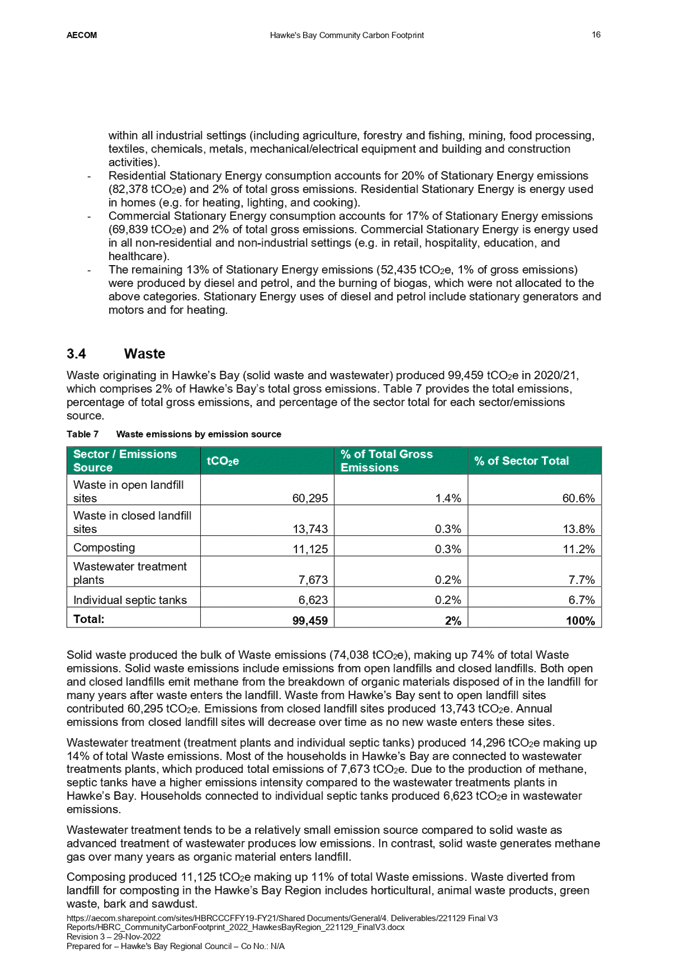
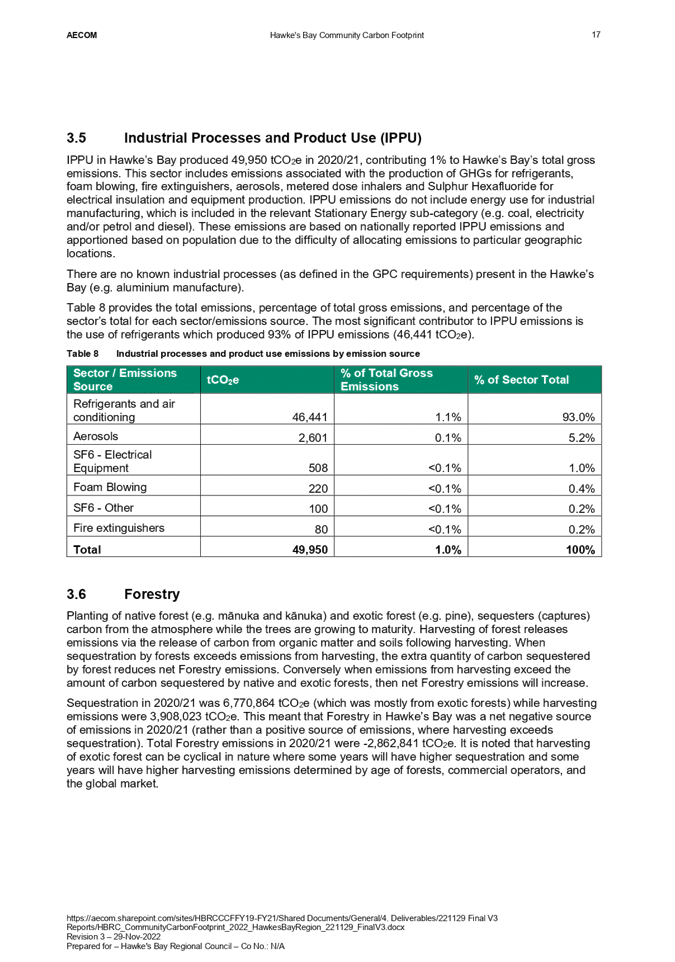
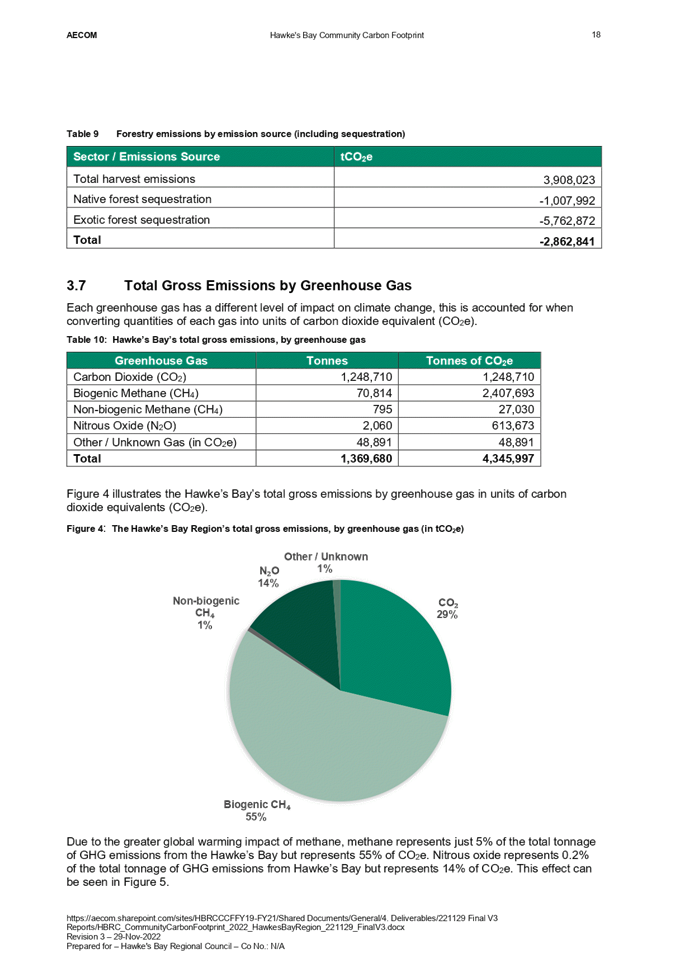
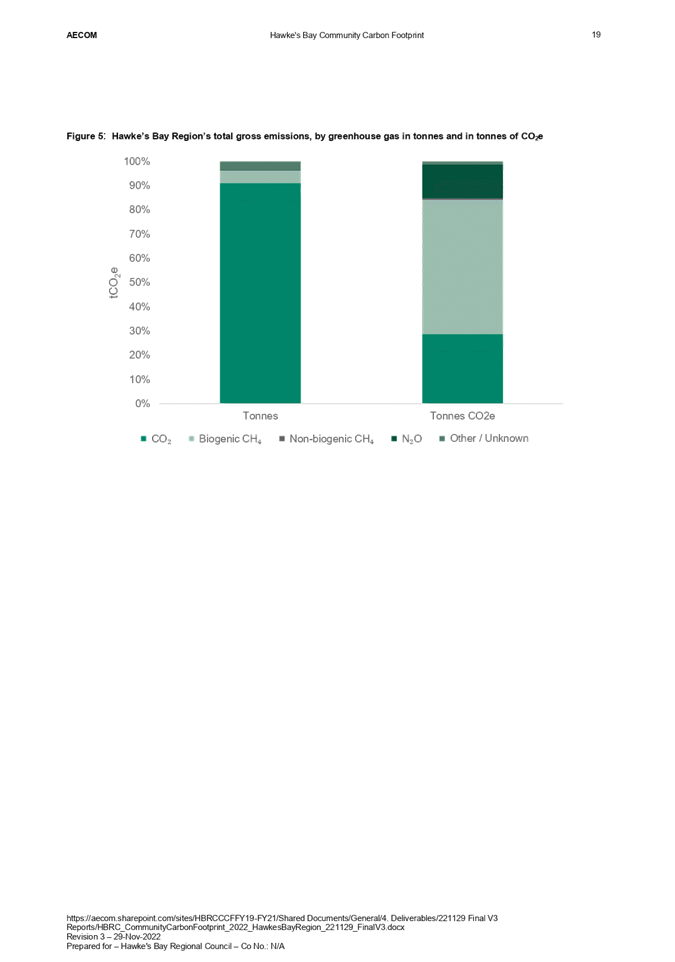
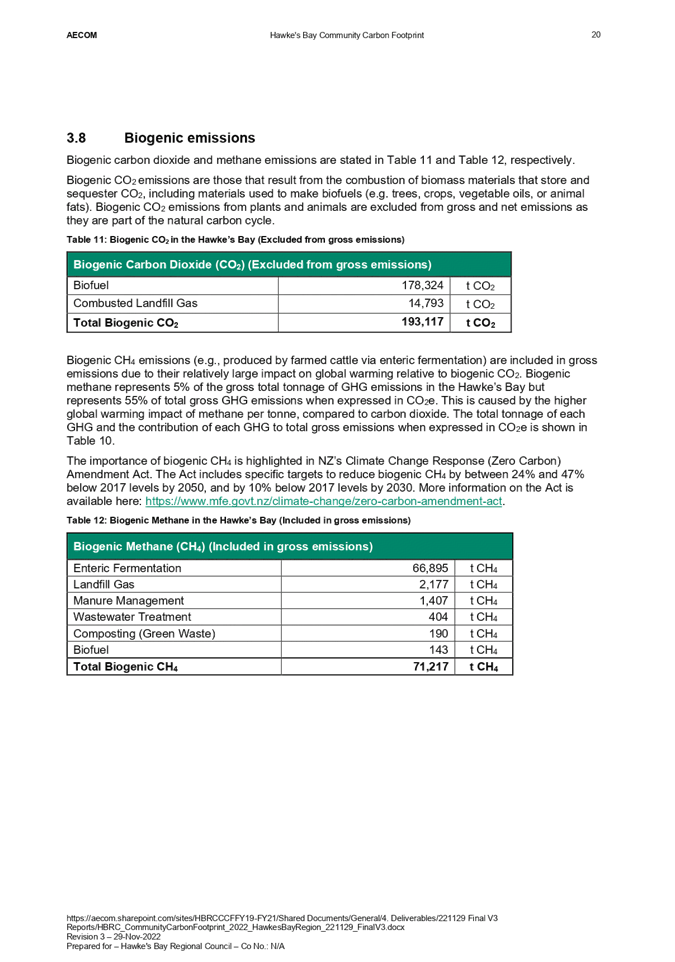
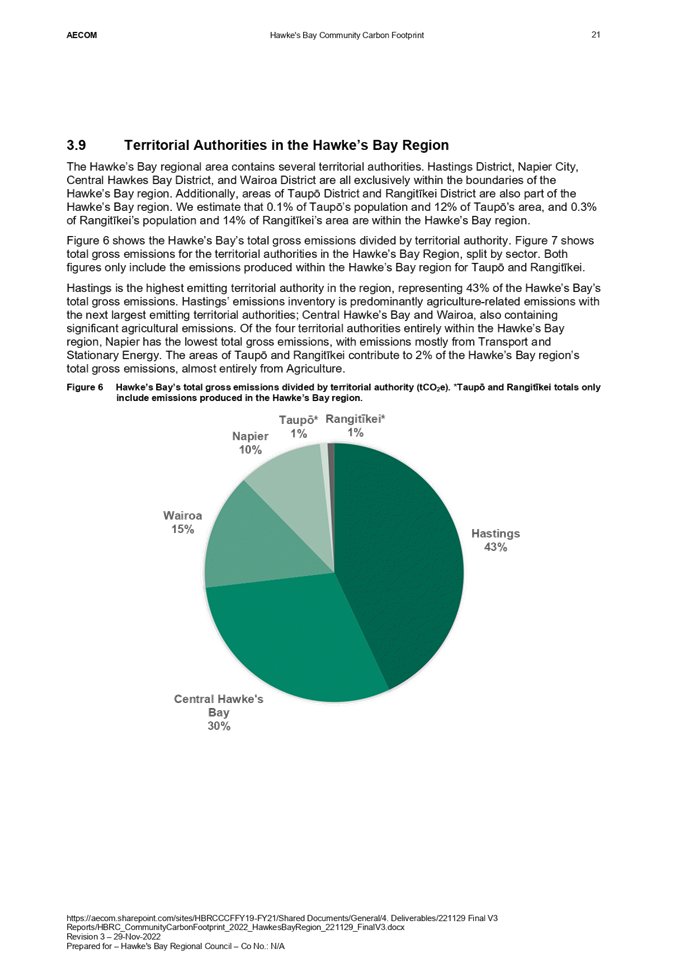
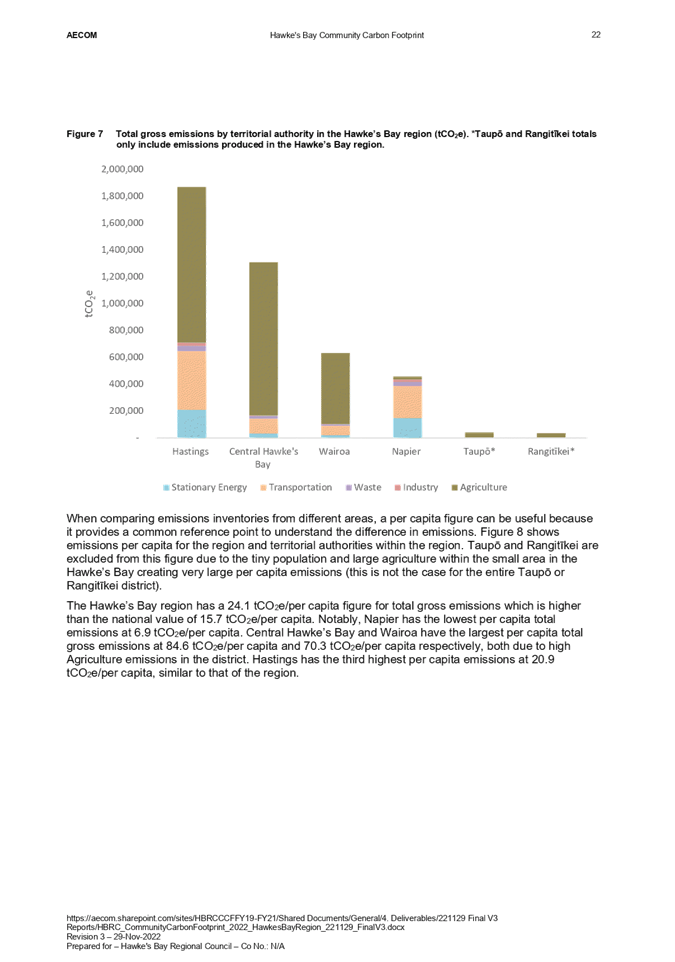
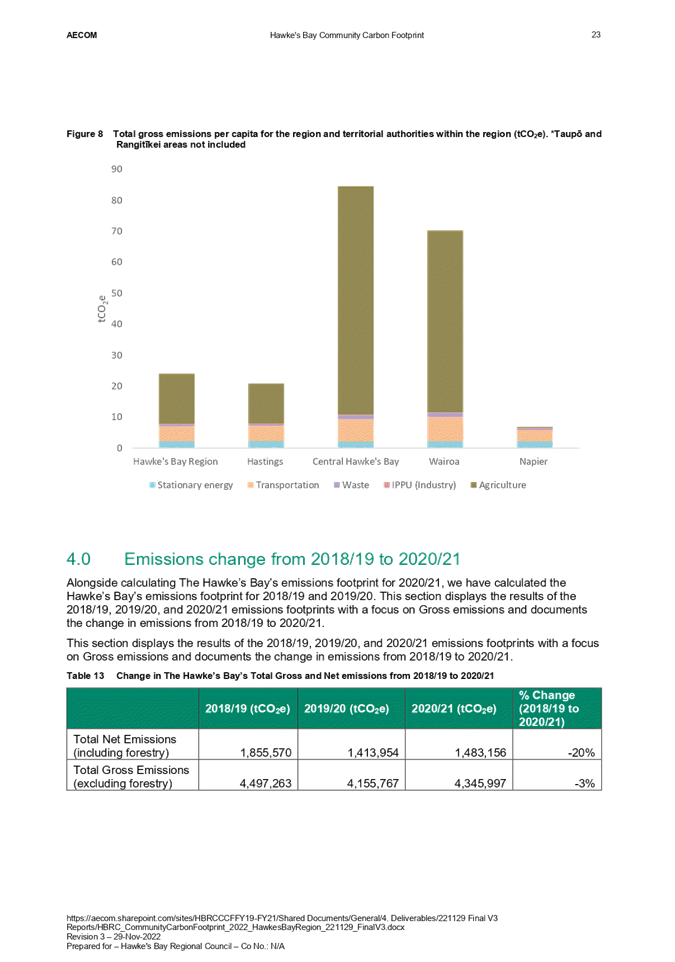
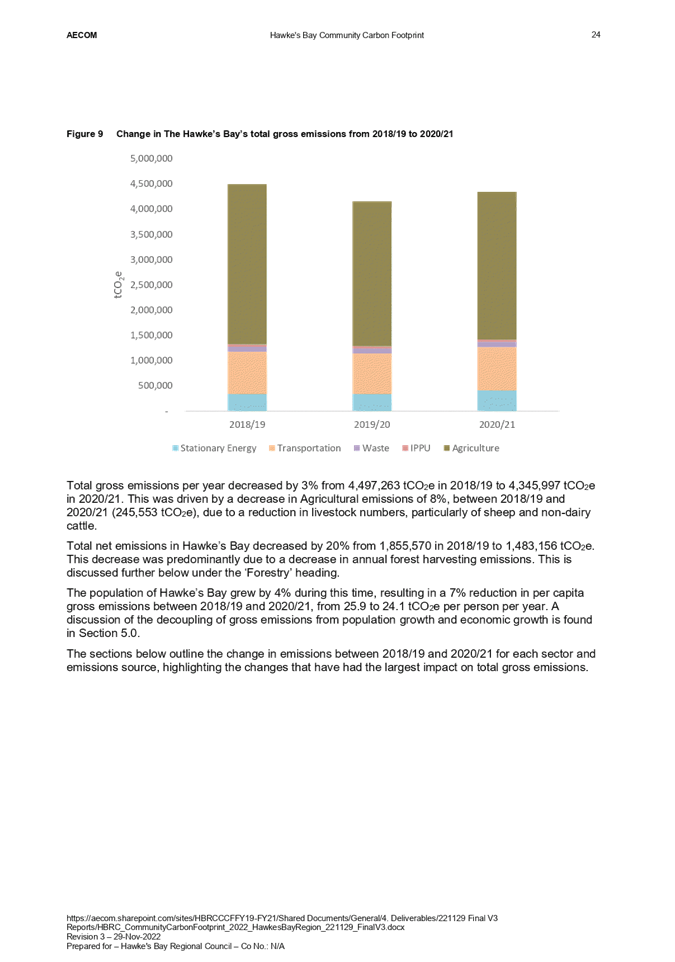
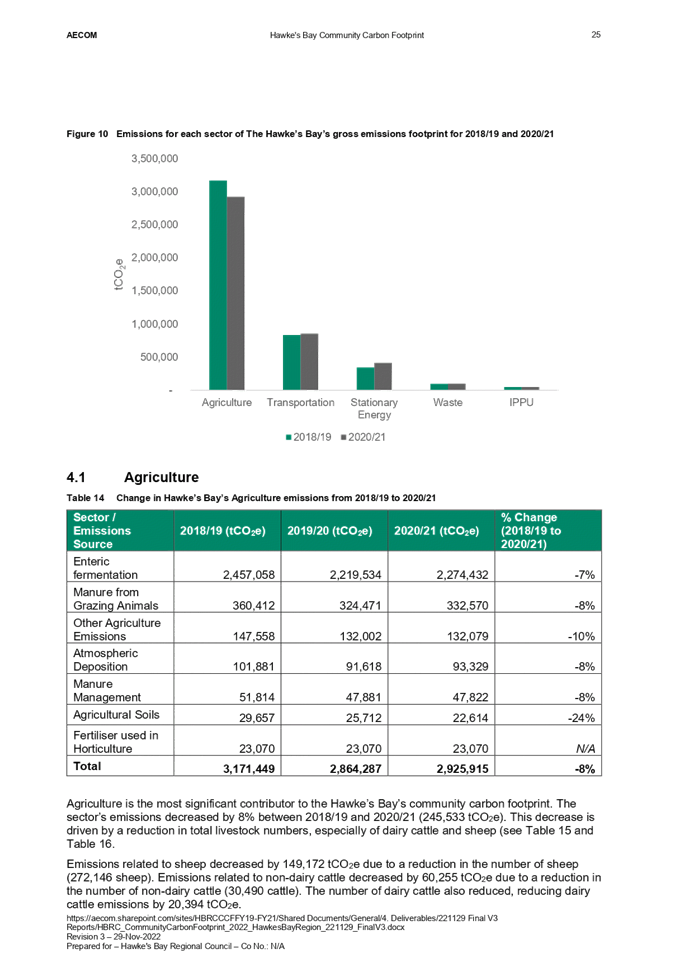
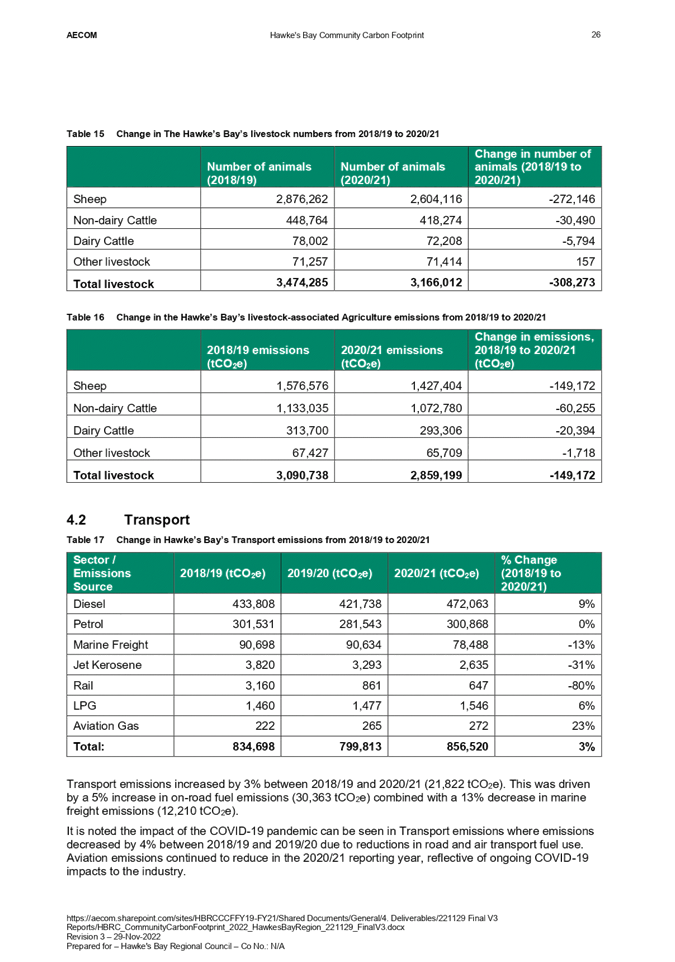
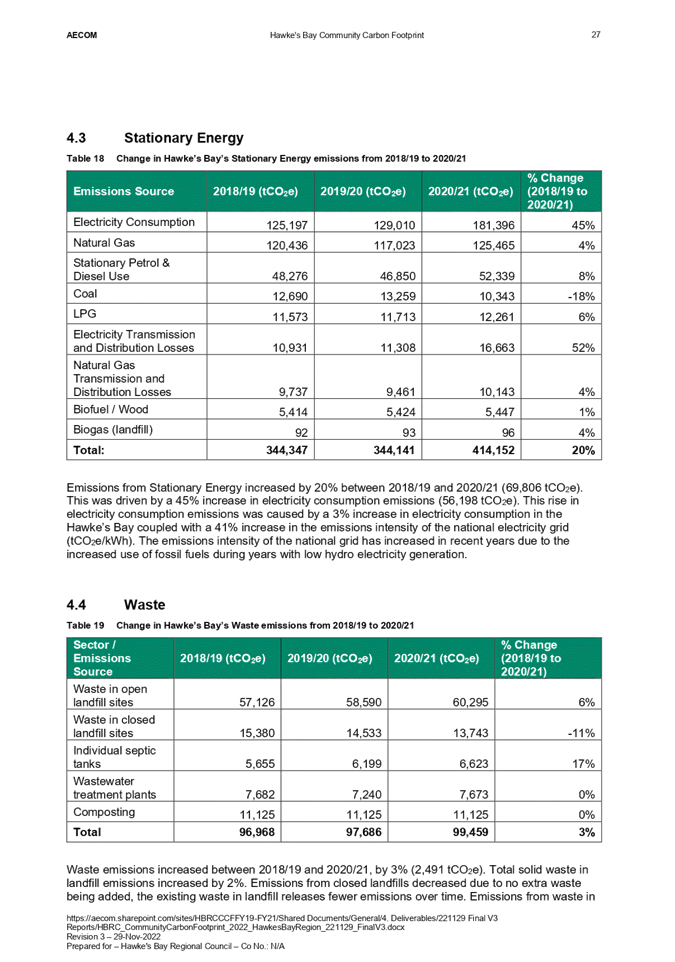
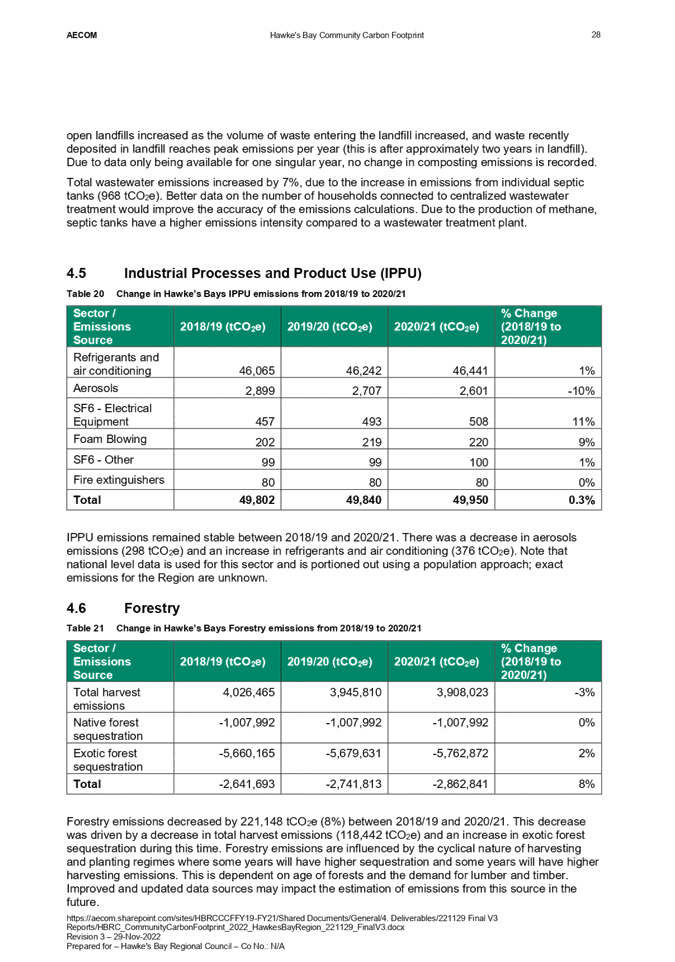
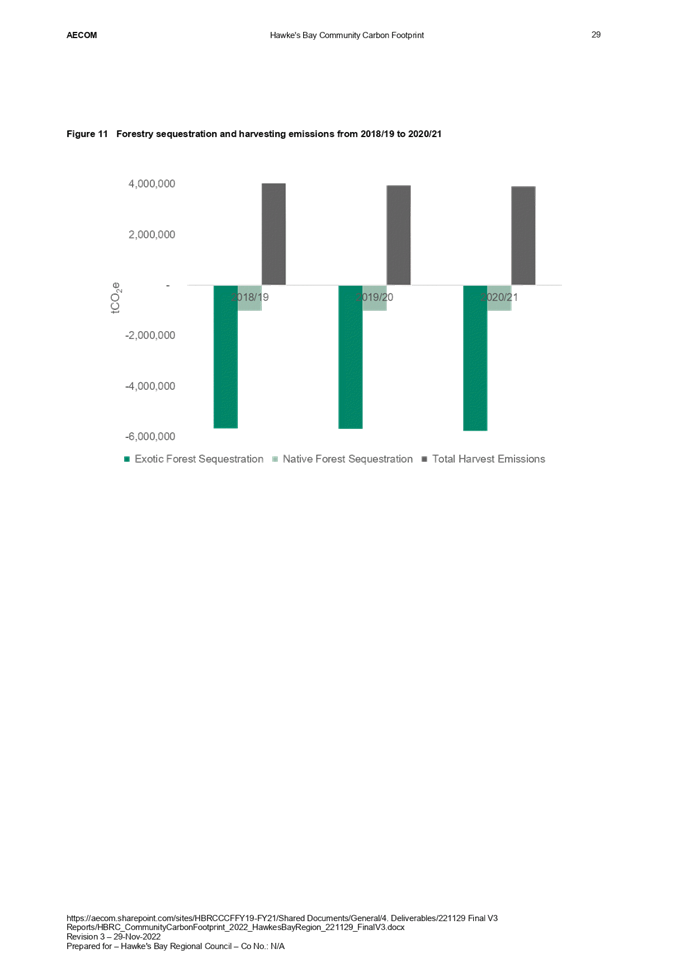


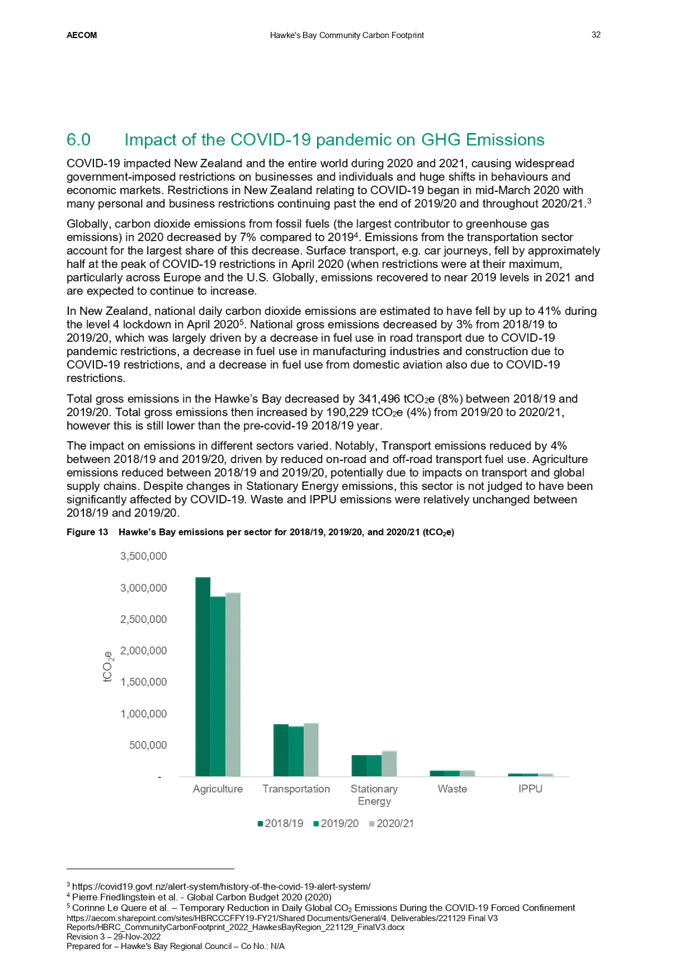


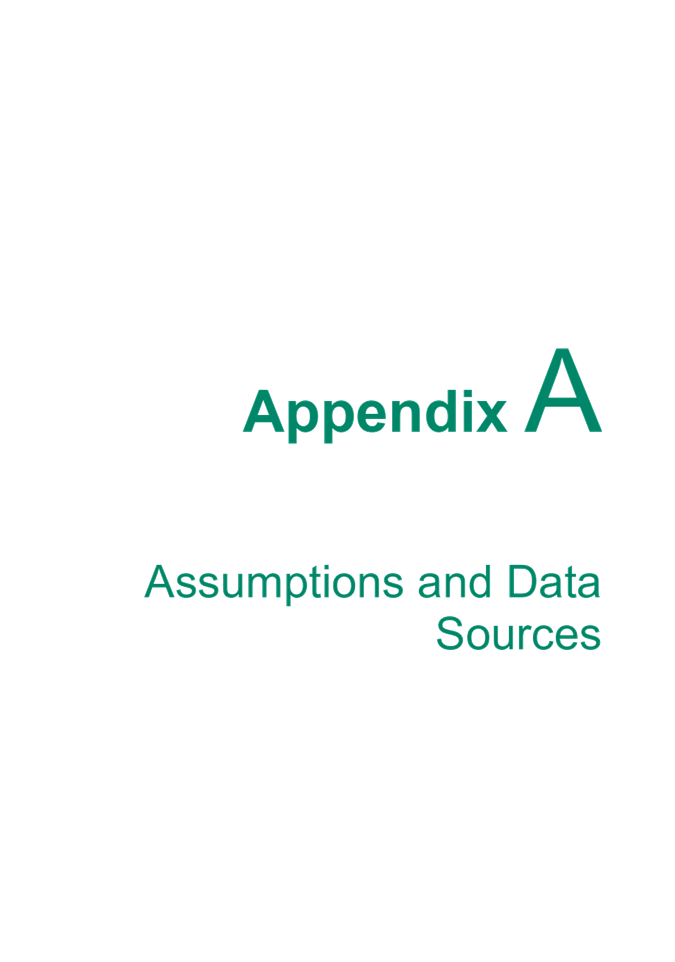
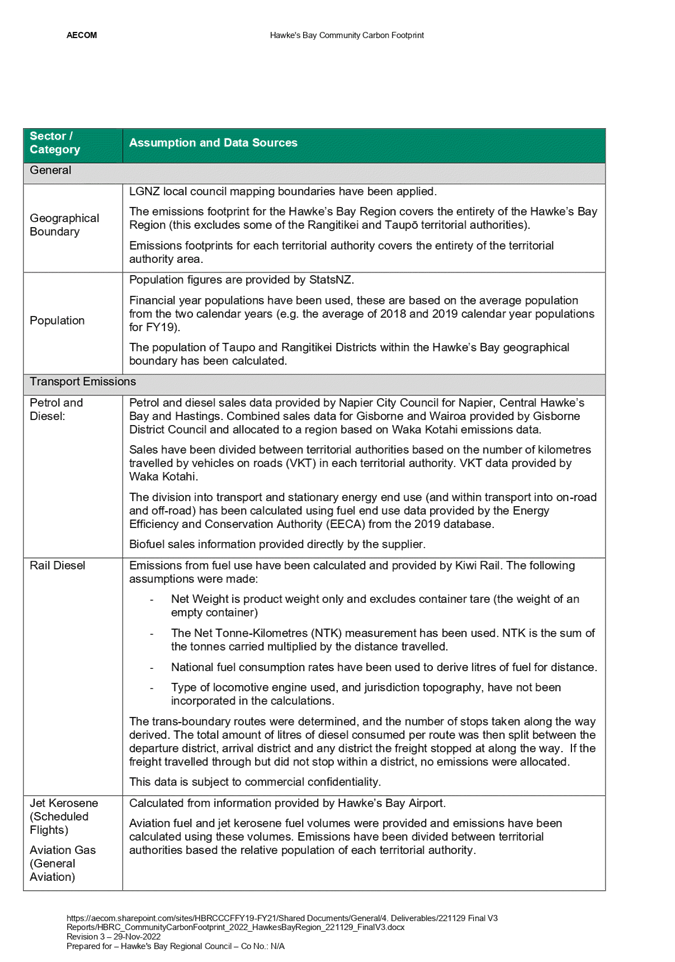
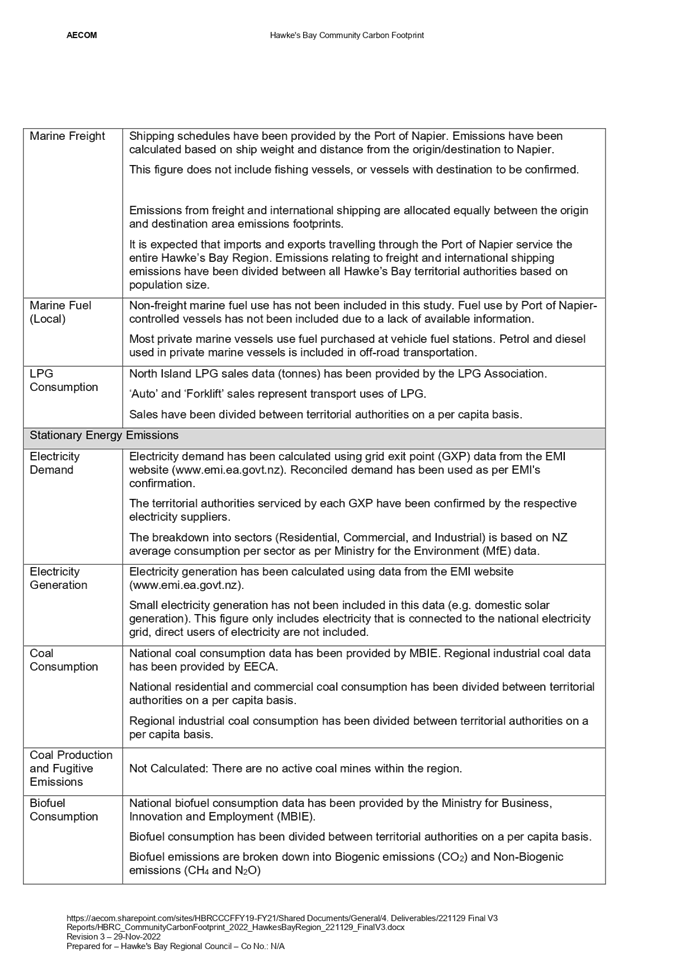
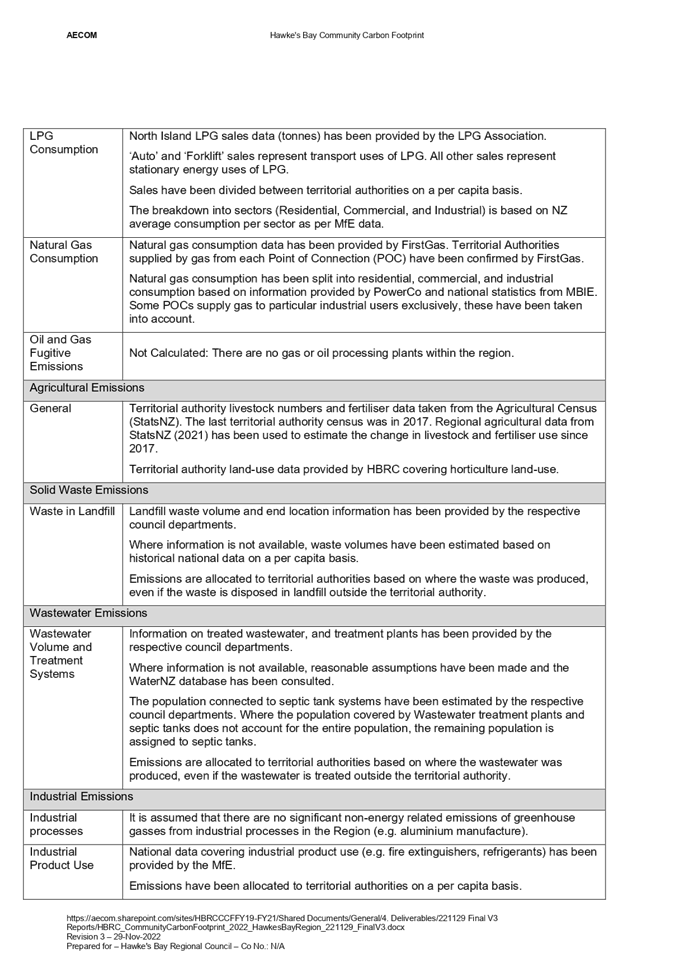
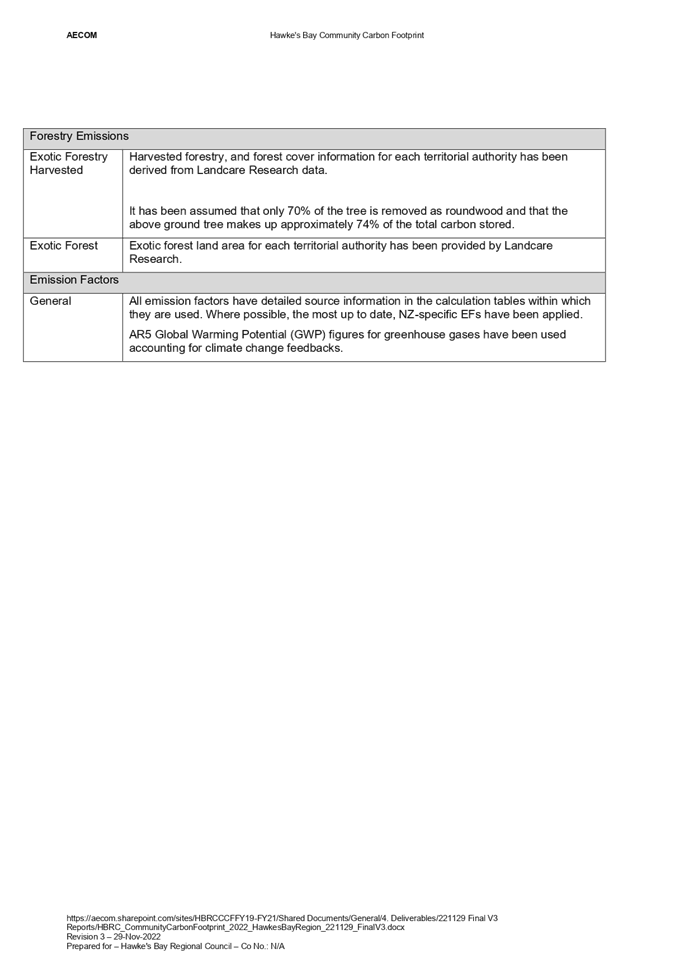
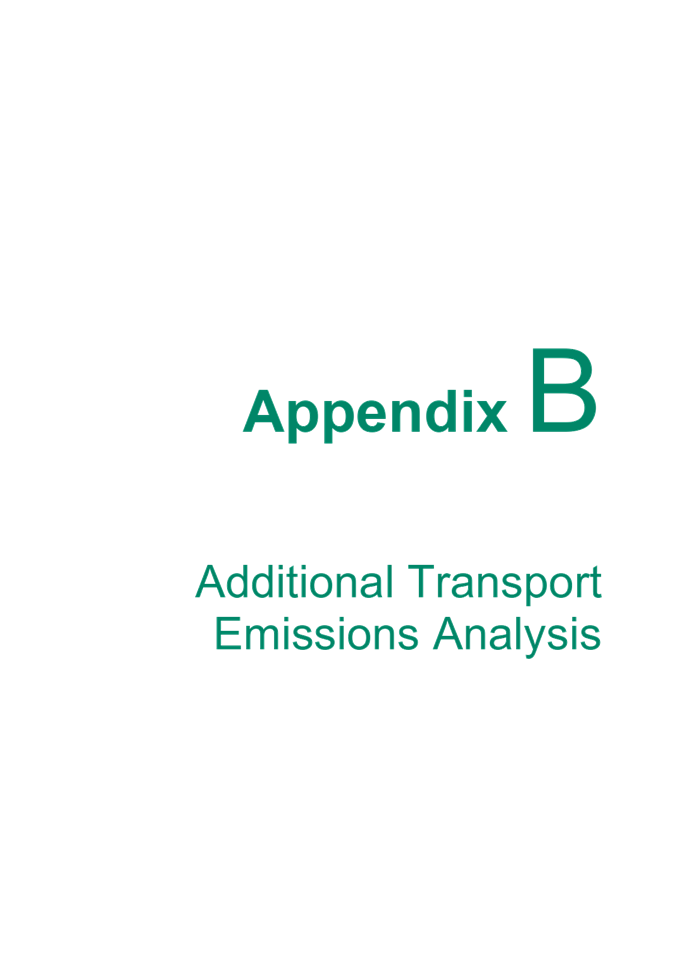
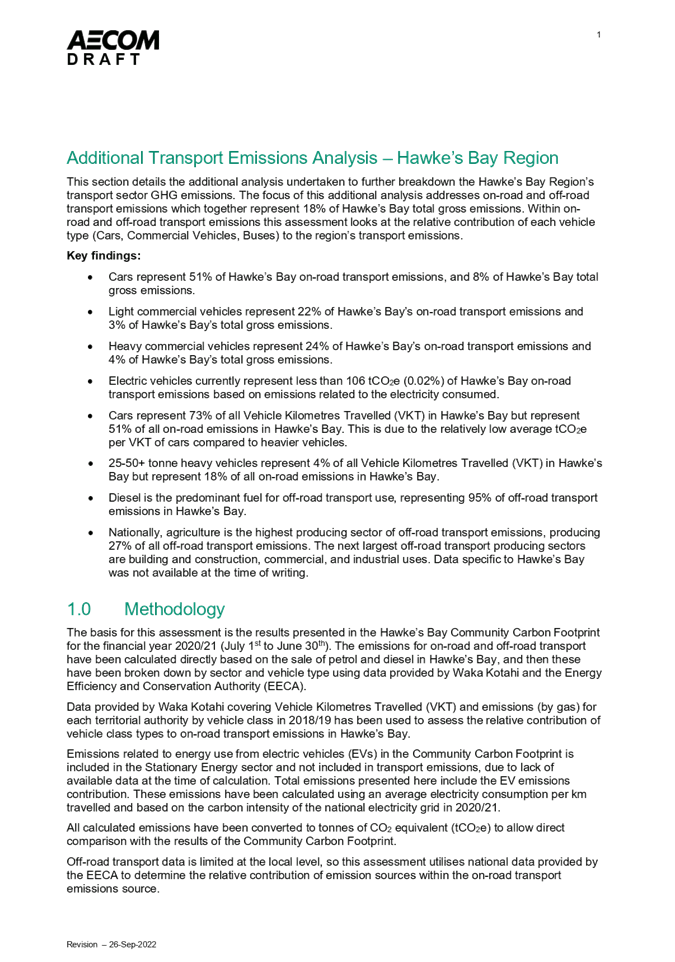
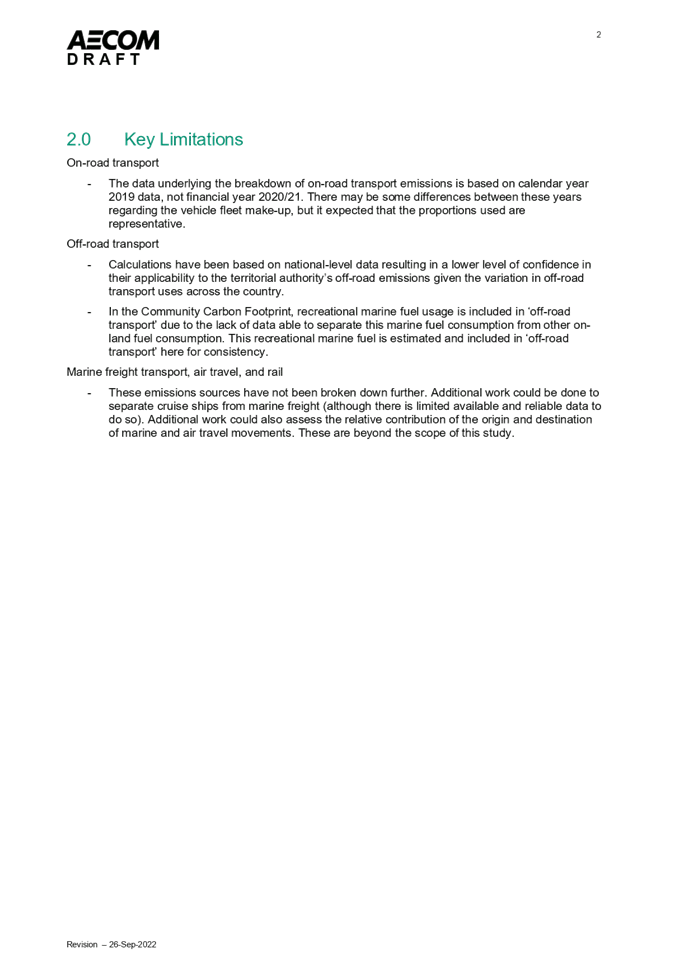
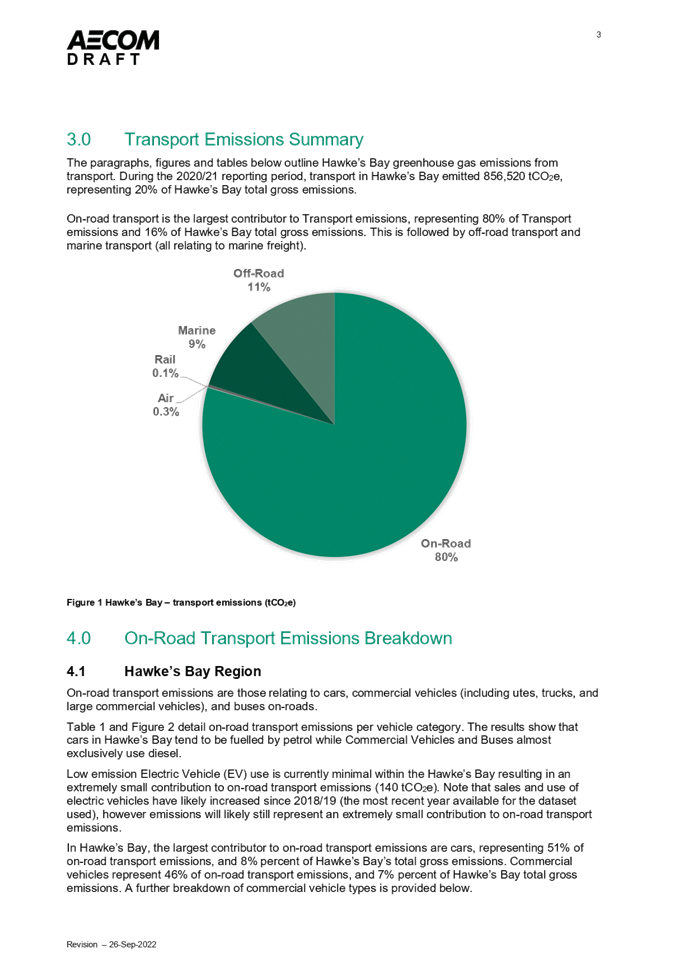
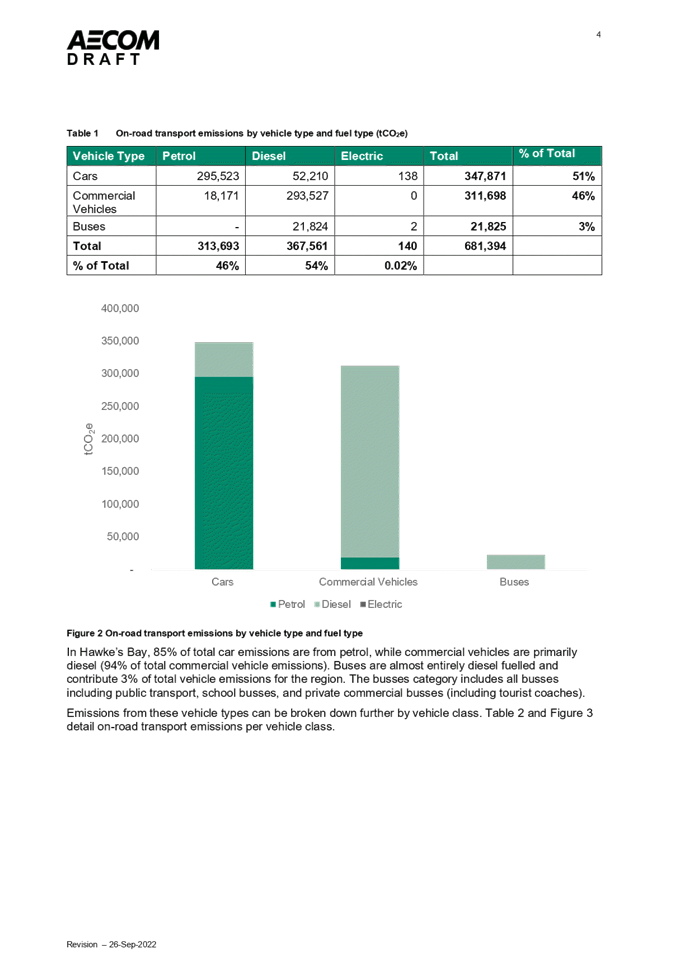
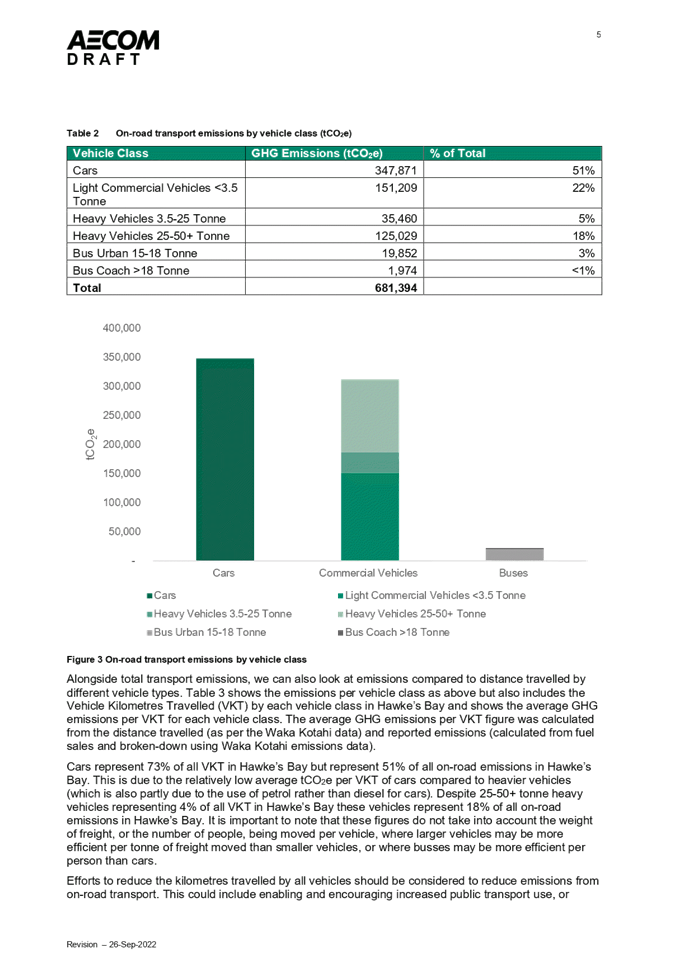
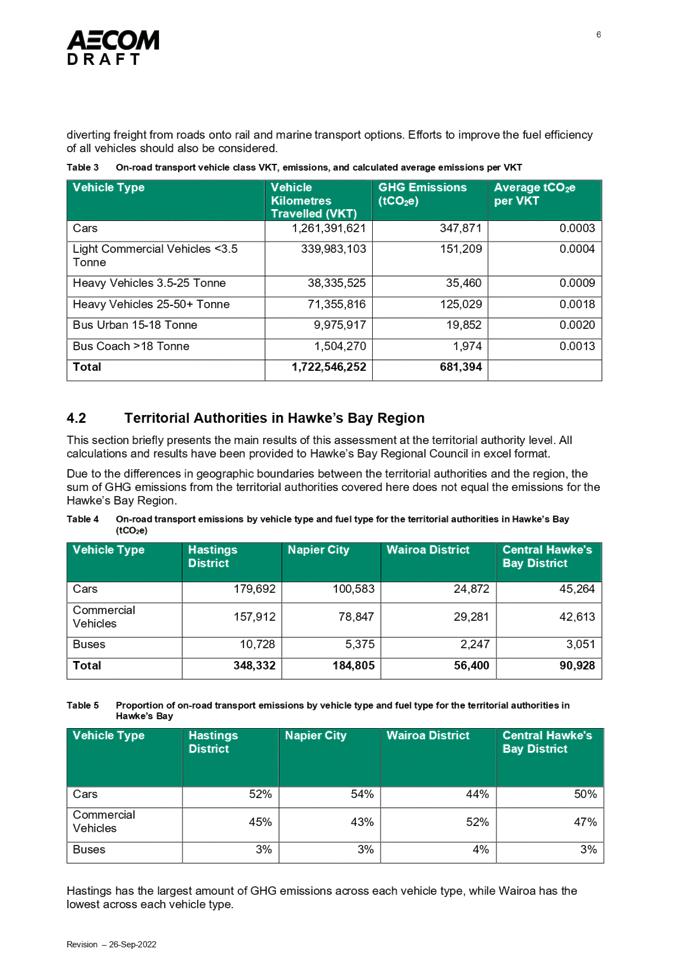
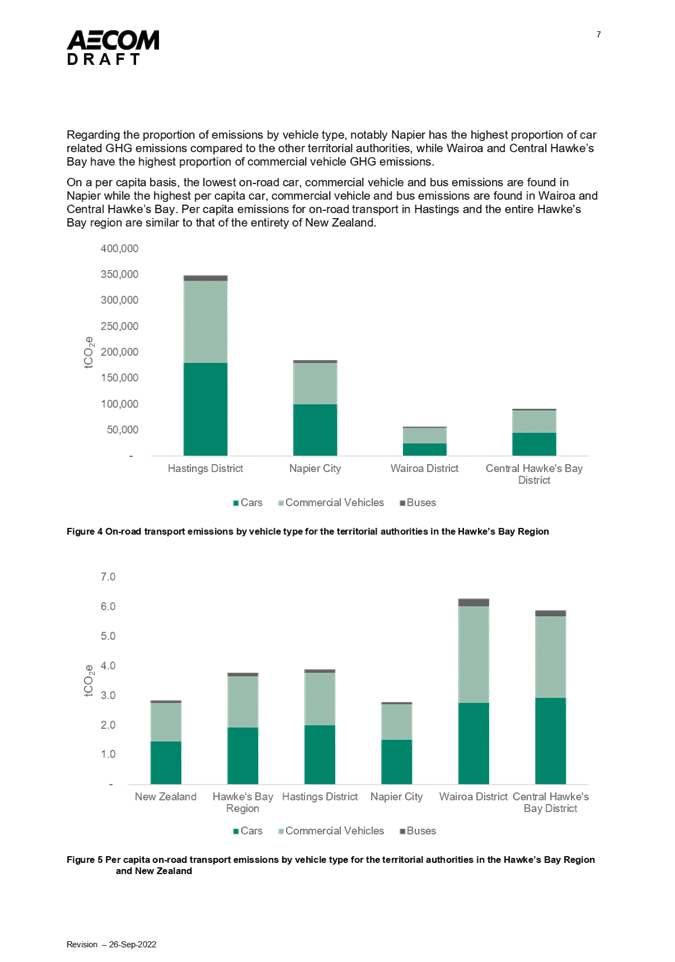
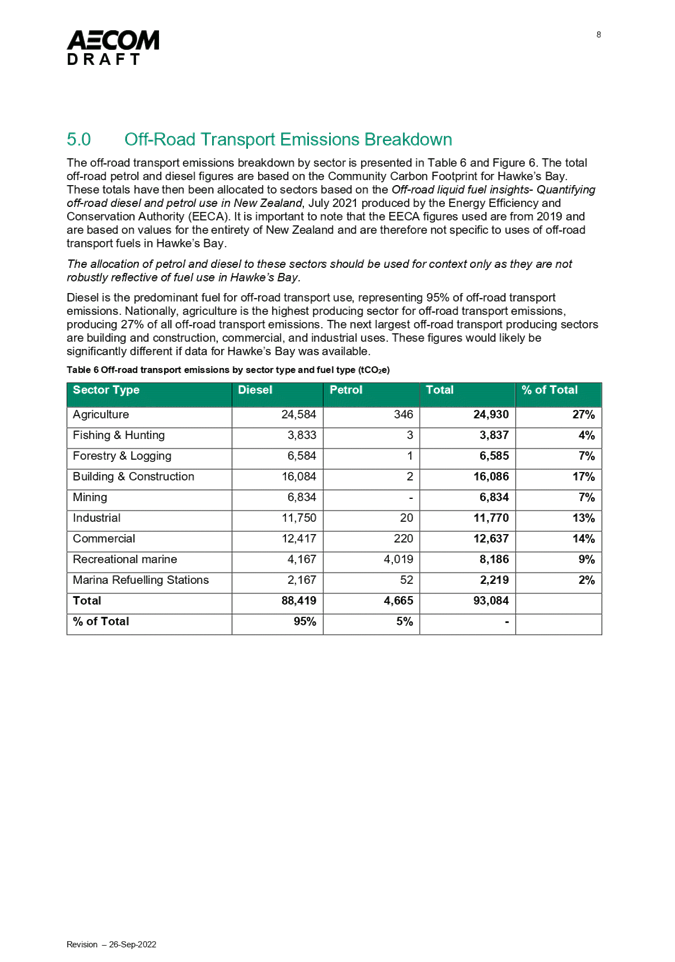
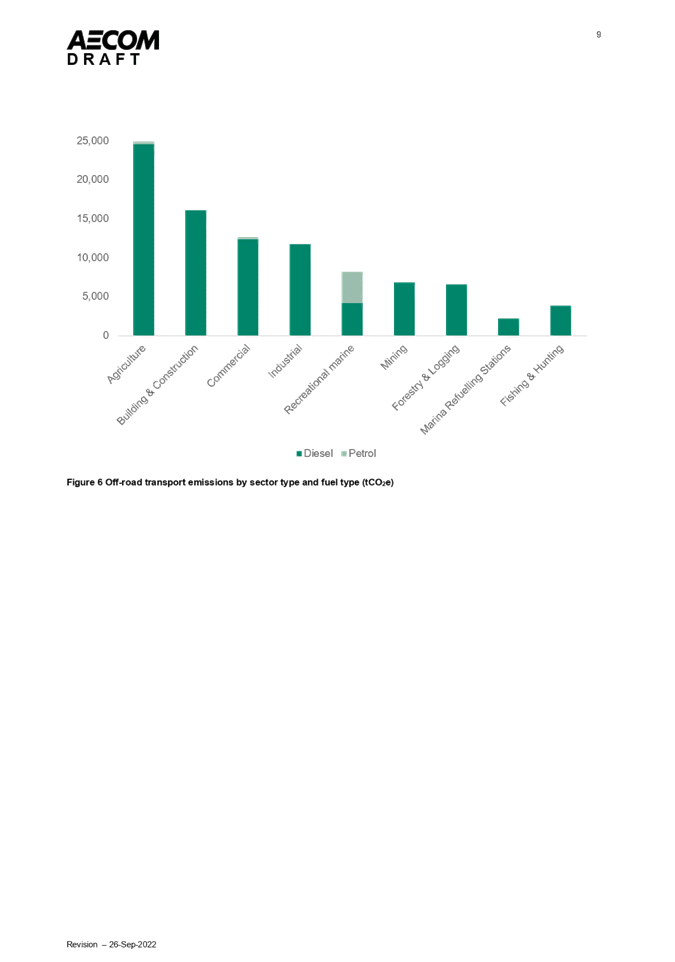
Hawke’s Bay Regional
Council
Regional
Transport Committee
Friday 10
February 2023
Subject:
Regional Transport Programme Tracker February 2023
Reason for Report
1. This agenda item introduces
the Regional Transport Programme Tracker to the Committee. The programme
tracker will be a standing item on the Committee agenda providing an update of
progress on RTAG workstreams.
Background
2. The TAG format
was restructured in late 2022, taking a focused workstream structure. The
programme tracker has been developed to track progress against deliverables and
report to the RTC. Comment is welcomed.
Decision Making Process
3. Staff have assessed the
requirements of the Local Government Act 2002 in relation to this item and have
concluded that, as this report is for information only, the decision-making
provisions do not apply.
Recommendation
That
the Regional
Transport Committee receives and notes the Regional Transport
programme overview February 2023 staff report.
Authored by:
|
Bryce Cullen
Transport Strategy &
Policy Analyst
|
Katie Nimon
Transport Manager
|
Approved by:
|
Katrina Brunton
Group Manager Policy &
Regulation
|
|
Attachment/s
|
1⇩
|
Regional Transport Programme Tracker
|
|
|
|
Regional Transport Programme Tracker
|
Attachment
1
|
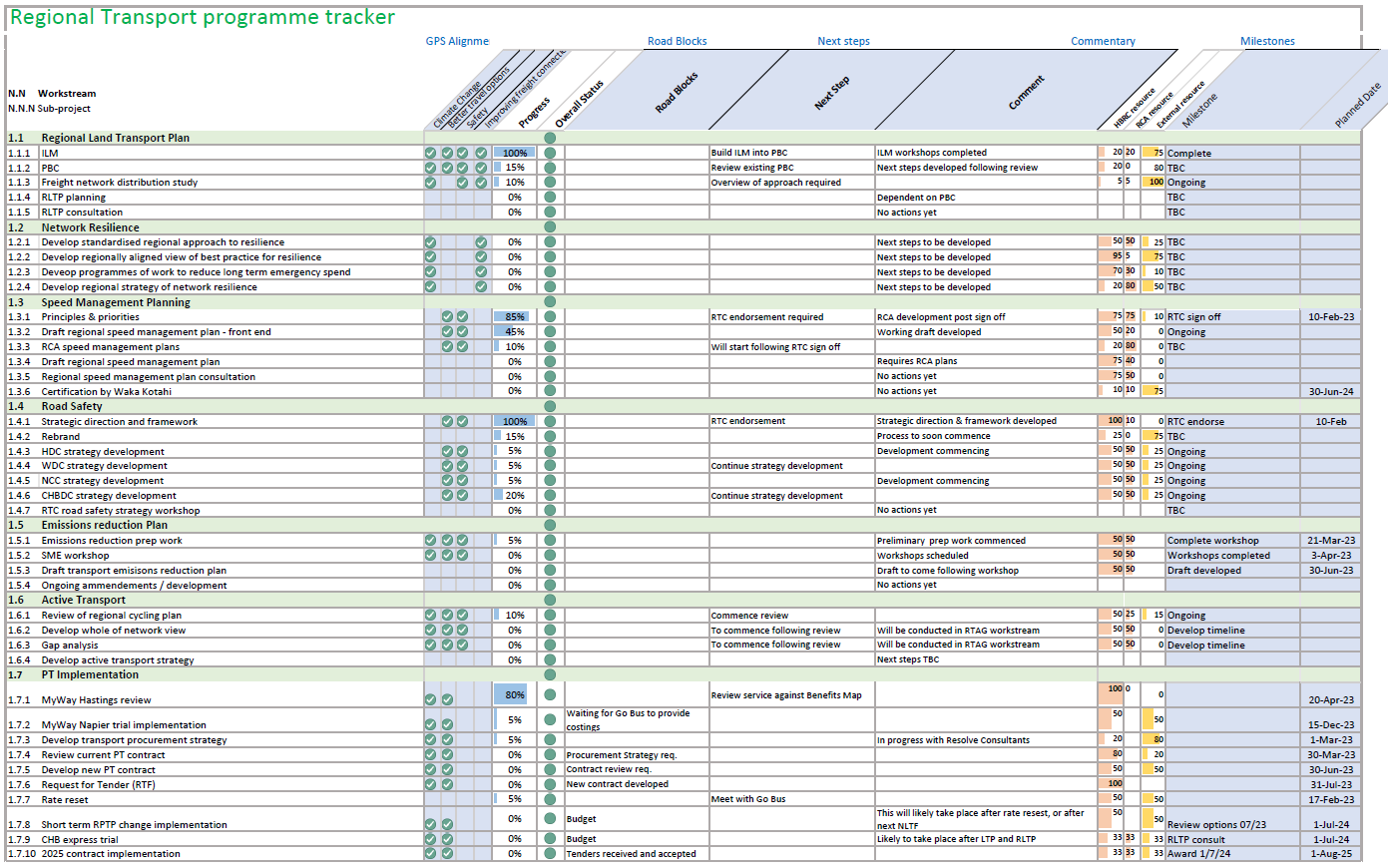
Hawke’s
Bay Regional Council
Regional
Transport Committee
Friday 10
February 2023
Subject:
Regional Road Safety update
Reason for Report
1. This report outlines the
new strategic framework and direction of Roadsafe Hawke’s Bay. It sets
out the framework, models, approach, and strategic ownership of Roadsafe
Hawke’s Bay activities into the future.
Executive Summary
2. Roadsafe Hawke’s Bay
is a business unit of the Hawke’s Bay Regional Council and is responsible
for delivering road safety education, messaging, and training across the
region.
3. In 2022 a section 17(a)
review of the Roadsafe Hawke’s Bay function was undertaken, finding that
ownership and delivery of road safety initiatives should sit within the TLAs
and be facilitated and enabled by the Roadsafe Hawke’s Bay business unit.
Essentially, Roadsafe Hawke’s Bay should create a fully integrated
regional road safety management solution that aligns engineering, education,
services, and enforcement.
4. A new strategic direction
has been developed to give effect to the recommendations of the sections 17(a)
review. This information paper, in conjunction with the supporting appendix,
give an overview of the new strategic direction and framework to enable Roadsafe
Hawke’s Bay to play a more strategic and integrated role across the
region.
5. The report sets out the
ongoing roles and responsibilities the Regional Transport Committee will have
in the RoadSafe Hawke’s Bay strategy.
6. Staff recommend the Regional
Transport Committee receives this information paper and endorses the new
strategic approach.
Strategic Fit
7. The RoadSafe Hawke’s
Bay strategy contributes to the strategic goal of having sustainable and
climate-resilient services and infrastructure. Road safety forms a critical
portion of this strategic goal. Safe roads closely support and enable greater
sustainability and resilience.
Background
8. RoadSafe Hawke’s Bay
(RSHB) is a business unit of the Hawke’s Bay Regional Council (HBRC)
responsible for delivering road safety education and messaging across the
region. RSHB is funded through a mixed model that sees each territorial
authority contribute some funding, as well as Waka Kotahi via a funding
assistant rate (FAR). The education and messaging are intended to support Waka
Kotahi’s Road to Zero strategy and is targeted to several prevalent risks
across the region. Historically, a team of five staff based out of HBRC has
delivered the road safety activities for the region. Through a series of staff
changes and period of structural change the team has gone from five staff to
one.
9. In 2022 a Section 17 (a)
review of RSHB was conducted. The review found that it is impractical for the
sole ownership and deliver of region wide road safety education to sit solely
within HBRC and be delivered by a single member of staff. The impact of the
existing operational model is a marked reduction in levels of service, largely
attributed to the limited time and resource.
10. The review outlined the
preferred option identified by regional stakeholders was to develop a fully
collaborative regional approach to delivering road safety. This recommendation
has been the catalyst for a new strategic direction that will see RSHB serve as
a facilitator and enabler of the delivery of road safety education in
Hawke’s Bay. Ownership of deliverables and / or activities will sit
within each council. A new strategic framework and direction has been developed
to reflect and give effect to this recommendation, set out in more detail in attachment
1.
Discussion
11. The new RSHB strategy casts
a wide net when considering road safety, largely aligning with Waka
Kotahi’s all of system approach. It encourages communities and councils
to think of all possible levers, interventions, and tools that may be available
to make material gain against risk factors.
12. The strategy goes down to
not only a Road Controlling Authority (RCA) level of detail, but down to the
communities within each RCA. Community strategies will be developed jointly with
RSHB, RCAs, and the community as the key subject matter experts. There are
multiple reasons for this, including:
The community will have an
intimate, detailed knowledge of the risk factors present in their community.
This will extend to a level of knowledge around who, why, what, and how we can
collectively enable change.
Gives depth and granular
detail to the strategy.
Creates a fully
collaborative regional approach to delivering road safety.
Offers action plans that
present an opportunity to make material change as they are developed by and for
the community. That being, they are targeted and specific.
Empowers the community and
/ or community groups to be the champions of change.
Enables the community to
deliver on their action plans themselves, where applicable and appropriate.
Help will be provided by RCAs, RSHB, and strategic partners when required.
Develops a holistic,
integrated picture of what road safety is in each community. It builds an all
of system picture and pulls on all threads (e.g. education, infrastructure,
services, etc.), enabling them to work together to create change.
Creates cross discipline
and cross community visibility of road safety and associated interventions or
actions.
13. The overall strategic
approach has been developed to recognize the outcomes of the section 17(a)
review, with the Road to Zero strategy setting the ‘north star’ for
the country. This then informs and directs the approach RSHB will take,
filtering this down to TLA strategies and deliverables. The strategy on a page
is detailed in Appendix 1; Section 1.
14. At a cursory level, the
strategy looks at all potential interventions using two key frameworks that
operate collaboratively. Using these frameworks in conjunction recognizes that
education is only a piece of the puzzle. The strategy takes an all of system
approach within communities, identifying ways to make practical and material
progress. The two key frameworks are described in detail in Appendix 1; Section
4 (a & b).
15. Importantly, what really
differentiates the new approach from historic RSHB business as usual is the
segmentation-based approach within districts and communities. The approach is
formed around an I, WE, ALL OF US segmentation model. The model will be applied
to the strategy as a whole and remains consistent as the basis for behavioral
driver / choice identification and intervention development and design. The
segmentation model is discussed further in Appendix 1, Section 3
16. Community risks, needs, and
evidence-based interventions sit at the heart of RSHB’s new strategy. The
evidence used to define risk factors and develop interventions will be a blend
of qualitative and quantitative insights, and crucially, builds in citizen led
insights and knowledge. The strategy recognises community members as subject
matter experts to assist in the development and execution of the strategy.
Strategy development process
17. As part of the new
strategic direction, RSHB will enter a brand redevelopment process. This will
see a new brand personality / tone of voice established, supported by a new
visual identity. The refresh will also encompass a new RSHB website that will
serve as a detailed resource and information hub, giving life to the delivery
of the new strategy.
18. A framework has been
developed to ensure risk factors, causal factors, citizen insights, and key
enablers of change have been identified and captured for each district and
community. This is the strategy development process, and it follows six steps, being:
18.1.1. Identification of district risk
factors
18.1.2. Development of district specific
segmentation model (I, WE, ALL OF US)
18.1.3. Development of district risk
identification model
18.1.4. Transformation of key enablers of
change into the behaviour intervention matrix
18.1.5. Development of clear action plans
based off the behaviour intervention matrix
18.2. More detail on the strategy
development process and outcomes can be found in Appendix 1, Section 6
18.3. A standardized framework to develop
the strategy and capture relevant insights has been developed. This is
described in Appendix 1, Section 7 a – e.
RoadSafe Hawke’s Bay governance and the role of the RTC
19. The RTC play a critical role in road
safety across the region. At a high level, the RTC is responsible for the
strategic governance of road safety activities and working to keep our roads
safe. At a council level, RTC members are the champions of road safety
messaging, education, and interventions. For the purposes of this new strategy,
RTC members are also the champions of change.
20. We expect that the ownership of
strategic governance sits with the RTC, and the chair is the overall owner of
the RSHB strategic governance. RTC members will be the champions and owners
within their respective territorial authorities.
21. The RTC will have operational
involvement at two clear points throughout the strategy development process.
21.1. Firstly, RTC consideration and
endorsement of the new strategic direction and framework as presented in this
paper.
21.2. Secondly, once the majority of the
strategy development has taken place (i.e. risk factors and causal elements
identified by the community) the draft interventions for each community and
risk factor will be brought back to the RTC. It is anticipated that the RTC
will play a role in reviewing, providing feedback, and validating the
intervention mix. This will then form an action plan within each TLA.
Next Steps
22. RSHB will initiate a
rebranding process that will encompass a new brand personality and tone of
voice, accompanied by refreshed visual identity. A new website will form part
of this process with the intention of being a resource and information hub to
underpin the new strategic direction and empower partners and communities. Road
safety messaging, detailed resources, and collateral will be developed in line
with the new strategic direction, segmentation model, and risk factors.
23. HBRC staff will continue
the strategy development process with TLAs and existing road safety action
groups, updating the RTC as required.
24. Once draft interventions
are designed these will be brought back to the RTC for review, feedback, and
validation before being transformed into an agreed action plan. The timeline
for this is fluid as the strategy development process is expected to take some
time.
Decision Making Process
25. Staff have assessed the
requirements of the Local Government Act 2002 in relation to this item and have
concluded that, as this report is for information only, the decision-making
provisions do not apply.
Recommendation
That the Regional Transport
Committee receives and notes the Roadsafe Hawke’s Bay staff report
and that it endorses the new approach.
Authored by:
|
Bryce Cullen
Transport Strategy & Policy
Analyst
|
|
Approved by:
|
Katrina Brunton
Group Manager Policy &
Regulation
|
|
Attachment/s
|
Roadsafe HB overview
|
Attachment
1
|
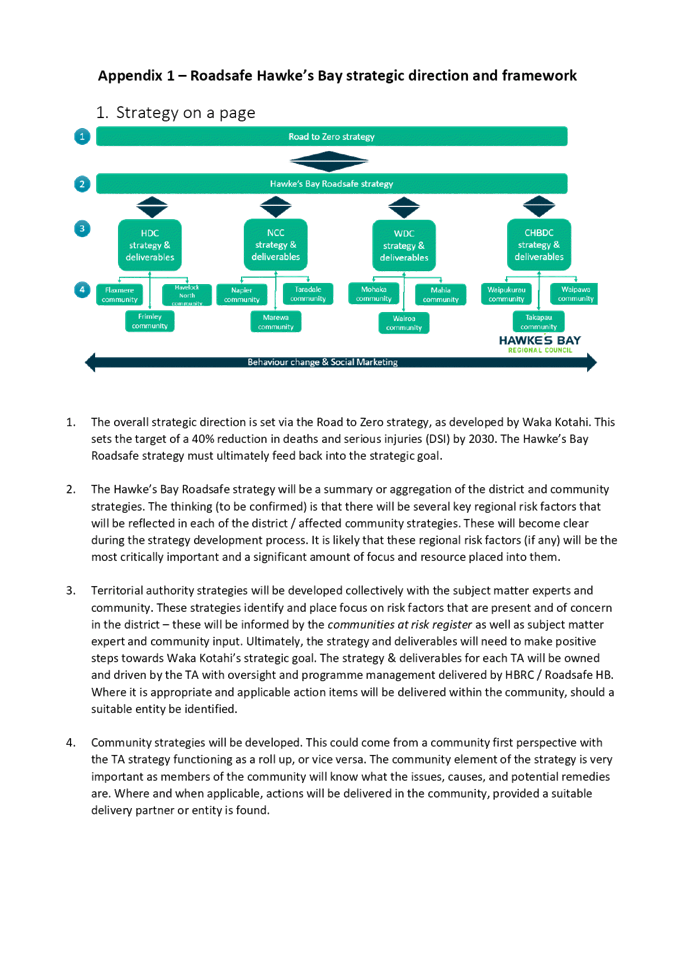
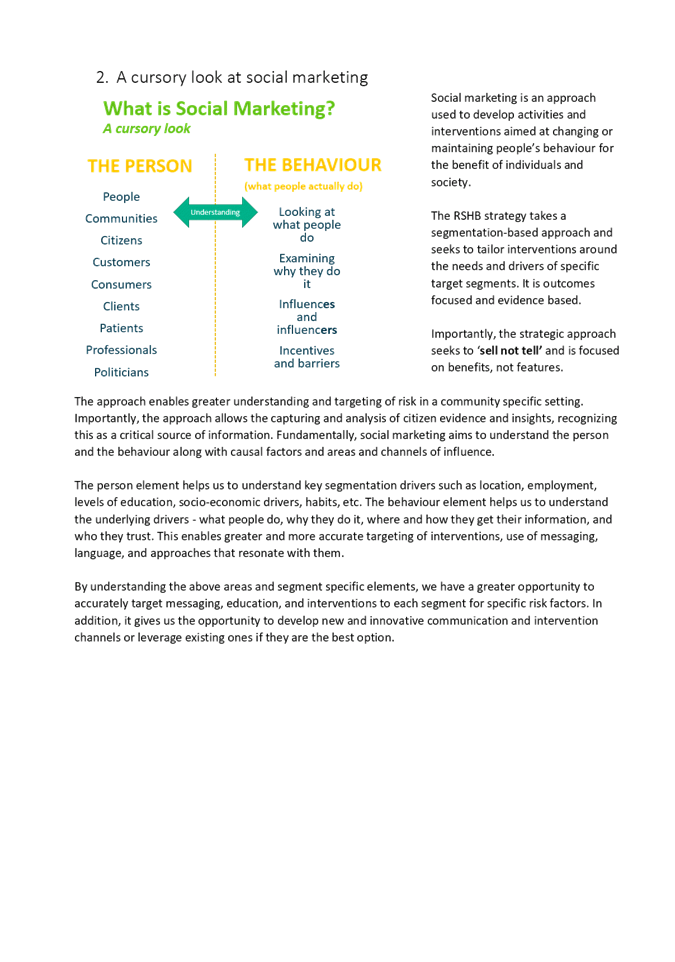
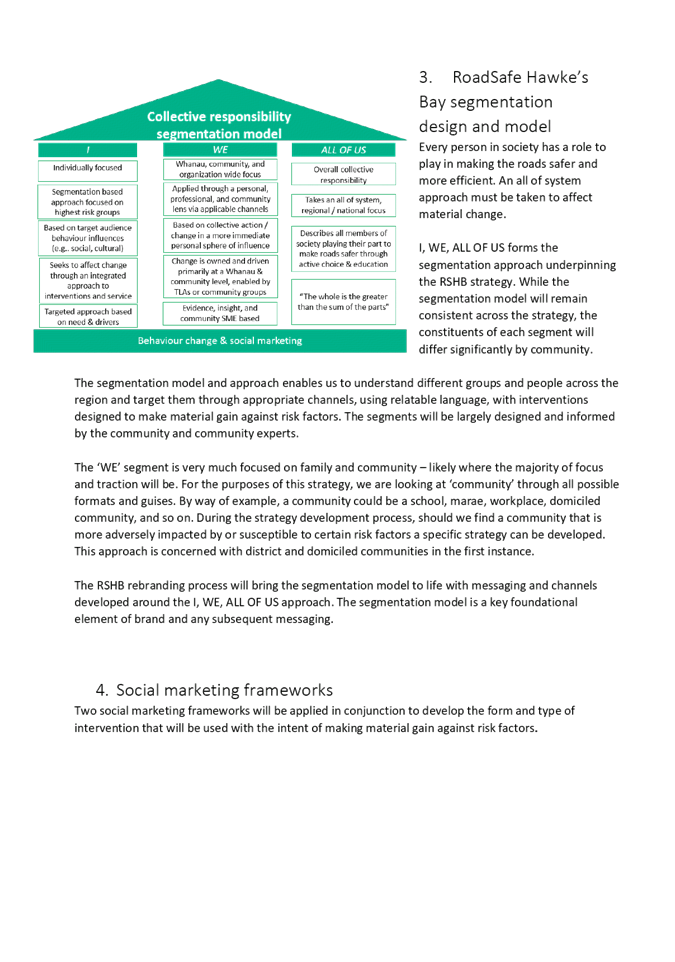
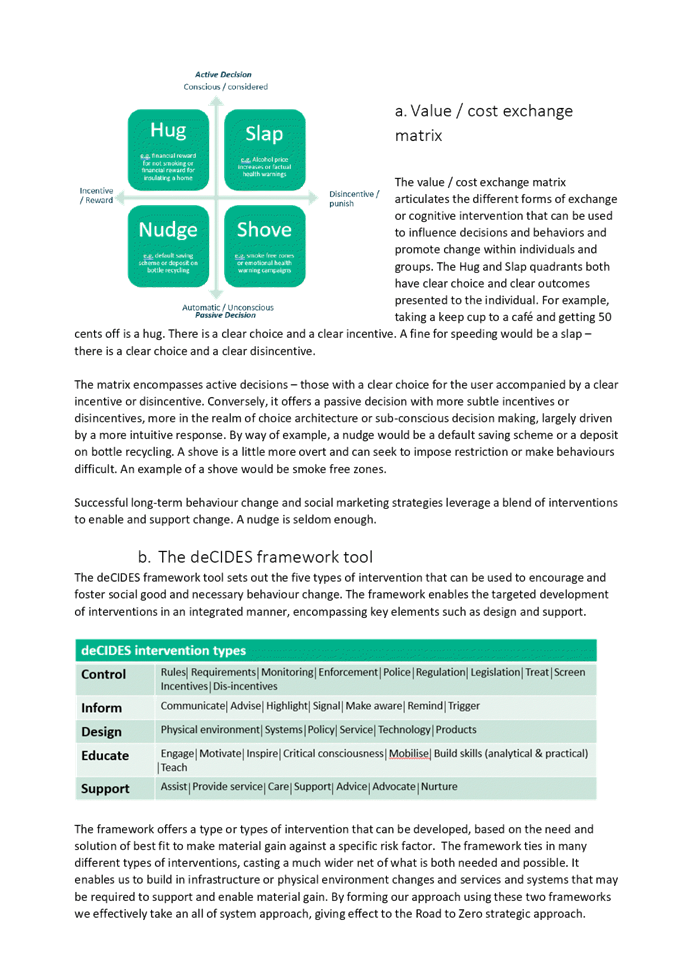
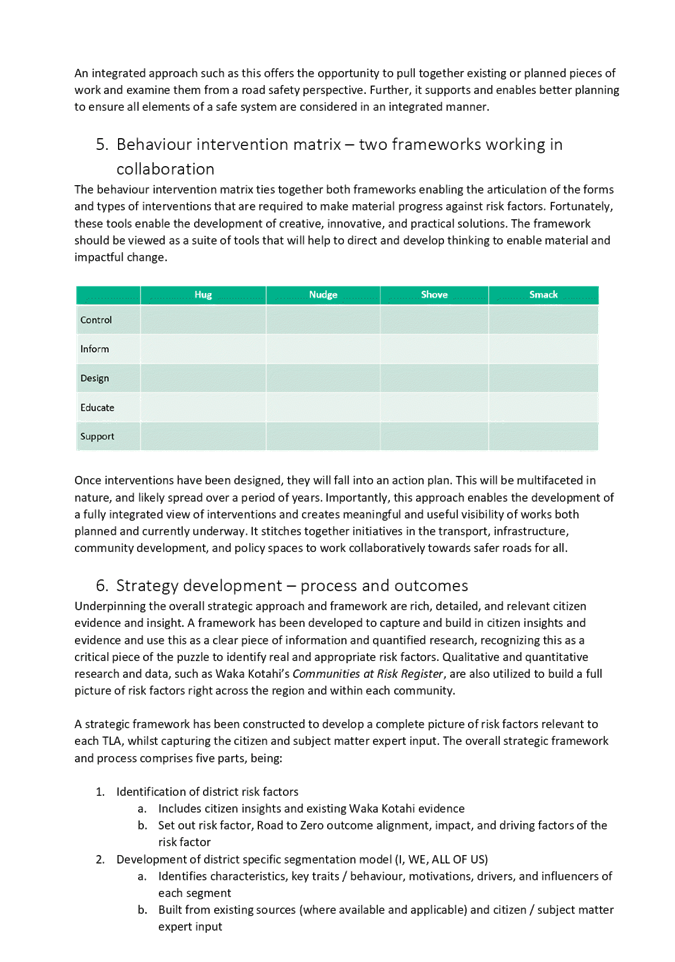
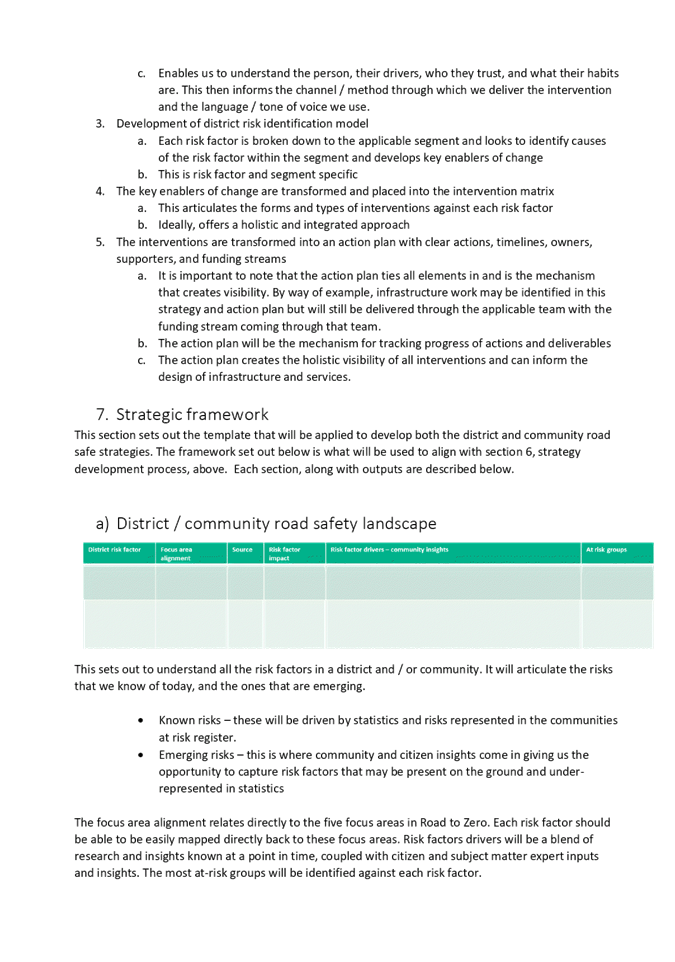
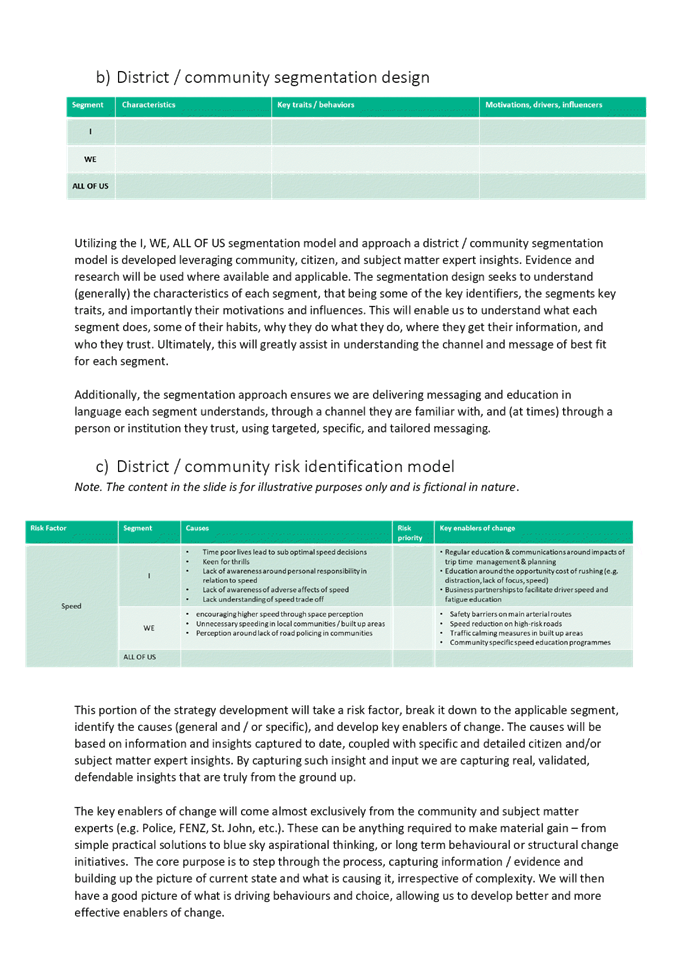
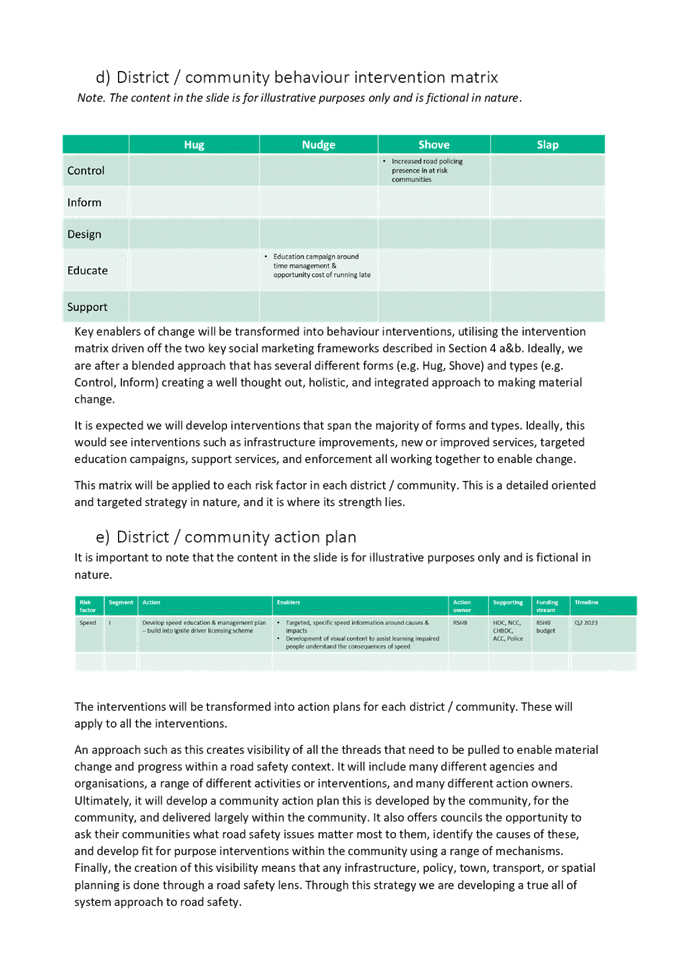
Hawke’s Bay Regional
Council
Regional
Transport Committee
Friday 10
February 2023
Subject:
Public Transport update
Reason for Report
1. This agenda item provides
an update on Public Transport operations in the region.
Background
2. The responsibility for
contracting public transport services is assigned to regional councils under
the Land Transport Management Act 2003. Under Section 35, the council
must consider the needs of the transport disadvantaged when preparing
its Regional Public Transport Plan (RPTP), which sets out the services that the
council will provide.
3. Transport disadvantaged means people who the
regional council has reasonable grounds to believe are the least able to travel
to basic community activities and services (for example work, education,
healthcare, welfare, and shopping). As part of the responsibility to the
transport disadvantaged, councils also provide Total Mobility services where
suitable transport operators exist to deliver the service.
Discussion
goBay operations
4. The goBay service
implemented a set of 20 indefinite cancellations since 21 November 2022 to
mitigate the impact of ongoing ad hoc cancellations because of recruitment
issues experienced by our contract operator. Since January, goBay has seen
additional cancellations due to further Go Bus staff shortages, due to driver
departures, illness, and long-term injuries. The additional ad hoc
cancellations are difficult for the Council to communicate to the public. The
Council continues to work with Go Bus to achieve a more sustainable set of
cancellations that can be better communicated and are consistent. This can take
weeks to achieve due to scheduling, which results in varied cancellations in
the interim. Go Bus is working on further recruitment methods to address the
issue. Figure 1 shows the cancellation rates for the last 12 months.
|
Month
|
Expected trips (Ave.)
|
Cancelled trips #
|
Cancelled trips %
|
|
Feb-22
|
3667
|
867
|
24%
|
|
Mar-22
|
3834
|
1667
|
43%
|
|
Apr-22
|
3758
|
1379
|
37%
|
|
May-22
|
3815
|
1117
|
29%
|
|
Monthly trips decrease from June due to 16a, 16b, 17 being
replaced by MyWay
|
|
Jun-22
|
3287
|
267
|
8%
|
|
Jul-22
|
3397
|
243
|
7%
|
|
Aug-22
|
3397
|
279
|
8%
|
|
Sep-22
|
3287
|
54
|
2%
|
|
Oct-22
|
3397
|
114
|
3%
|
|
Nov-22
|
3287
|
464
|
14%
|
|
Dec-22
|
3195
|
392
|
12%
|
Figure
1: goBay cancellation rates (February 22 – December 22)
5. Public Transport Patronage
|
Month
|
Total Patronage
|
Peak Patronage
|
Total Pax KMs
|
Total Fare Revenue
|
|
Jul-22
|
32,964
|
17,714
|
359,852
|
$ 19,620.00
|
|
Aug-22
|
44,621
|
27,172
|
460,202
|
$ 26,241.00
|
|
Sep-22
|
47,562
|
28,442
|
471,112
|
$ 30,501.00
|
|
Oct-22
|
38,157
|
20,566
|
383,367
|
$ 24,404.00
|
|
Nov-22
|
41,168
|
23,876
|
412,889
|
$ 26,852.00
|
|
Dec-22
|
31,332
|
14,755
|
317,811
|
$
20,238.00
|
Figure
2: Public Transport patronage (July 22 - December 22) incl. MyWay
6. The Napier Hastings Bus
Unit contract requires a gross price rate reset at the end of the sixth year of
the contract. This was due in July 2022 and is currently underway. This is in
accordance with Section 2.4 of the Contracting Manual for SD-16-000, which is
advised by the Waka Kotahi Procurement Manual, Section 10.28:
Section 10.28 – Gross Price Resets for PT units
Rule
1. Bus public transport unit
contracts procured through an open supplier selection process will have a cost
reset of the annual gross price informed by benchmarked price data (see
appendix I Contract negotiation processes for bus public transport units) at
six years of the nine-year term.
2. This section does not apply
to contracts for commercial units.
3. Approved Organisations with
small or medium-sized bus markets and where suitable price benchmark
information is not or is unlikely to be available, can reconfirm the contract
price at the current contract price when undertaking a gross cost reset.
Guidelines
Bus
public transport unit contracts longer than six years, will have the annual
gross price reset at year six of the contract to ensure confidence in costs.
This is a reset of the price only. It is not a review of the contract terms, or
an opportunity to end the contract early.
The
reset price will apply for the start of year seven of the contract, and if
necessary, will be paid in arrears.
The
price reset is intended to recognise that agreements need to ensure best value
for money is being achieved in the longer term, and a reasonable balance is
being maintained between operator profit and the expenditure of public funds.
Over
time, indexation payments, changes in farebox recovery and financial incentive
mechanisms may shift the balance between best value for money and sustainable
revenue. The reset process is designed to restore the balance.
This
reset may result in the annual gross price increasing or decreasing.
Half
Price Fares
7. The Government funded Half
Price Fares scheme has been in operation since 1 April 2022, to mitigate the
impact of rising fuel prices and encourage the use of public transport. During
the scheme, we have not seen a noticeable increase in patronage as a result.
The scheme is due to end on 30 June 2023. From 1 July 2023, the Half Price
Fares will stay in place for Total Mobility users, as well as Public Transport
users with Community Services Cards (CSC). This will be known as Community
Connect.
8. Community Connect will go
live on 1 July 2023 and will have a medium impact on the organisation. This is
due to the likelihood of an increase in Bee Card sales, and the requirement to
set up the concessions required for CSC holders to access the concession. The
Bee Card technical team are working with technology partners to automatically
integrate the data with the Ministry of Social Development, so our teams
aren’t required to manually authorise each individual request. Council
staff will simply enter the CSC number and the validation will occur in the
back end. Waka Kotahi is making funding available to cover the increased
administration cosst that may be involved.
On
Demand Public Transport (ODPT)
9. MyWay has been operating as
a separately funded improvement activity under Public Transport Programme since
June 2022 with the intention to trial a new mode of transport to increase
patronage.
10. MyWay performs well
comparative to similar services around Australasia. The Hastings Trial has met
its successful ridership targets; however, we can see that the service is
vulnerable to driver shortages and struggles to meet demand during peak time
due to the size of the zone and number of vehicles. Figure 3 shows the trends
across the last quarter in relation to meeting demand and ride requests.
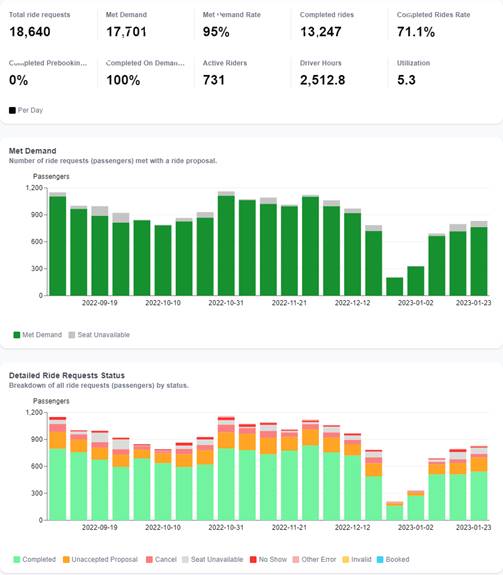
Figure
3: MyWay Service Operation (September 22 to January 23)
11. MyWay has undergone several
service-parameter changes to increase service levels in response to feedback
and pressure points in delivery. These changes have included:
11.1. Increased detour rates (the time the
rider spends in the vehicle can increase to allow additional riders to be
collected that might be further out of range), which allows MyWay to offer more
rides to users at peak times.
11.2. Increased booking window (increased
from 30 minutes to 45 minutes), which improves the likelihood of being offered
a ride. Although this results in a longer wait time, the rider can secure a
ride and doesn’t need to make ongoing attempts to book.
11.3. Reduced virtual stops (eliminating
several possible stops that are within a close walkable distance to the same
likely location i.e., Kmart and Hastings Hospital) which results in a faster
trip time for the passengers.
11.4. Increased walking distance (yet to be
actioned), which sees riders walk further to connect to the service, allowing
the vehicle to take a more efficient route. This decreases the “walking
distance” level of service, which would make this measure a last resort.
12. The Hastings MyWay service is still in
its trial period. The service will be reviewed using a benefit map and an
evaluation plan. The review will likely take place between February and April
to inform a trial in Napier due to be implemented in the 23/24 financial year.
13. The Napier MyWay trial is
still in the scoping phase, and further development is dependent on the success
of the Hastings trial. More options are being explored for the Napier trial, as
trialling a different model for Napier would be beneficial; to identify whether
another style of ODPT will have better community or patronage outcomes. This
will determine whether the trial is delivered inside the scope of the current
bus unit contract, or as a complimentary service.
Total
Mobility
14. The Total Mobility Scheme
provides subsidised taxi travel for Hawke’s Bay residents who are unable
to use public transport due to a significant, permanent impairment. People
assessed for and registered to the scheme receive taxi vouchers entitling them
to a 50% fare discount (which is currently subsidised to 75% under the Half
Price Fares scheme). The scheme is administered by the Regional Council and
funded by both the Council and Waka Kotahi.
15. Total Mobility trips have
risen as a result of the increased subsidy; however, they continue to remain
stable. Figure 4 shows the trips compared to total fares. The concession amount
is the amount of subsidy the scheme covers per month. The lower trips and fare
in July are directly related to the month Ridewise was launched, where some
trips were still being recorded by voucher rather than captured in the data.
|
Month
|
Total Trips
|
Total Fare
|
Concession Amount
|
|
Jul-22
|
5,002
|
$ 90,242.90
|
$ 63,929.28
|
|
Aug-22
|
8,181
|
$ 156,511.04
|
$ 110,948.68
|
|
Sep-22
|
8,627
|
$ 167,754.17
|
$ 119,641.10
|
|
Oct-22
|
8,348
|
$ 164,278.81
|
$ 115,913.21
|
|
Nov-22
|
9,247
|
$ 187,423.20
|
$ 132,424.56
|
|
Dec-22
|
8,850
|
$ 174,783.10
|
$
123,713.01
|
Figure
4: Total Mobility Trips and Cost (including flat fee hoist charges)
Climate
Emergency Response Fund (CERF) Transport Choices Package
16. Hawke’s
Bay Regional Council has successfully secured funding of $1.39 million from
Central Government to spend on projects aimed at the Transport Choices package.
The funding is part of a $350 million Transport Choices package included in the
Government’s Climate Emergency Response Fund (CERF) led by Waka Kotahi.
The funding secured by the Regional Council will upgrade ten bus stops in the
region, as well as creating two new stops. This package is fully funded by Waka
Kotahi. Bus stops will be upgraded at key locations across the network,
designed in accordance with expected patronaged and use style i.e., main
terminus, transfer point, high-volume stop. This also includes the development
of two new bus stops at locations new to the network: Whakatu, and the
Hawke’s Bay Regional Sports Park. Upgrades to the stops will include
real-time bus information, solar power for real-time travel information
displays, charging for scooters, bikes, and phones, as well as WiFi capability,
secure bike/scooter parking, 24-hour security lighting and cameras. The bus
stops will be designed for all abilities and allow bus users to get a sense of
the improved services that they can expect to the region’s bus network
from mid-2025.
Decision Making Process
17. Staff have assessed the
requirements of the Local Government Act 2002 in relation to this item and have
concluded that, as this report is for information only, the decision-making
provisions do not apply.
Recommendation
That the Regional Transport Committee receives
and notes the Public Transport update staff report.
Authored & Approved by:
|
Katie Nimon
Transport Manager
|
|
Attachment/s
There are no attachments for this
report.
Hawke’s
Bay Regional Council
Regional
Transport Committee
Friday 10
February 2023
Subject: Active Transport update
Reason for Report
1. The purpose of this report
is to give an update of active transport specific actions and deliverables that
are either planned or underway in each territorial authority. Additionally,
this paper outlines the purpose and focus areas of the active transport workstream.
Executive Summary
2. The report updates the RTC
on active transport activities that are either planned or underway across the
region. Detailed planning is well underway within councils that received
Transport Choices and Streets for People funding.
3. The report sets out the
next steps for the active transport workstream, with the overall goal being the
development of a regional active transport strategy. The existing regional
cycling plan will be reviewed as the foundation to the new active transport
strategy. The strategy will look at active transport through the lens of
vehicle kilometres travelled (VKT) reductions, emission reduction plan, one
network framework, and modal shift to determine what needs to be updated and
added to form a robust active transport strategy for Hawke’s Bay.
4. The TAG agreed that the
core purpose of the workstream is not to be involved in operational detail or
planned works. Instead, the workstream would take a strategic focus, setting
the ‘north star’ for active transport in Hawke’s Bay.
Background
5. The technical advisory
group (TAG) was restructured in late 2022 to take a workstream based structure,
resulting in a more focused approach to workstream content and deliverables.
With a regional focus on modal shift, emissions, and VKT reductions the
establishment of an active transport workstream was a clear decision.
Discussion
The following sections will give an
overview of current active transport activities that are either underway or
planned in each council
6. Central Hawke’s Bay
District Council (CHBDC)
6.1. Towards the end of 2022
CHBDC successfully secured funding from Streets for People and Transport
choices. Streets for People funding will be used to encourage walking and
community connectedness in Waipawa. Preliminary design is underway and an
initial site safety walk has taken place.
6.2. CHBDC was awarded $4.2
million from the Transport Choices fund, with most of this funding focused on
the Ōtāne community. The vision is to completely link the
Ōtāne community through well designed, modern footpaths throughout
the settlement, creating a model connected community. Pōrangahau is set to
become increasingly connected via footpaths linking the school to key areas of
the community, provided funding allows.
7. Wairoa District Council
(WDC)
7.1. WDC successfully secured
funding through the Transport Choices package in 2022. The funding will see the
design and development of a network of integrated multi modal paths with the
urban area of Wairoa. WDC envision a network that links all key areas around
the town. Planning is currently underway.
7.2. WDC’s aspiration is
to encourage increased active transport among the younger generations, using
this as a springboard to involve the entire family and creative positive
habits.
8. Hastings District Council
(HDC)
8.1. Like the other TA’s,
HDC successfully secured funding from both the Transport Choices and Streets
for People packages. The funding will see the design and development of a
several infrastructure interventions, including traffic calming around several
schools along with supporting and enabling infrastructure.
8.2. A portion of the Transport
Choices funding has been allocated to the Camberley and Mahora communities. The
funding will focus on the design and development of safe walking and cycling in
and around these communities and will be carried out in a targeted, integrated
way.
8.3. The Akina to Mayfair
cycleway project has been initiated, increasing connectivity north-south across
Hastings. A network wide review of the existing iWays in the district is taking
place with a view to increasing separation within the network, improving levels
of comfort and safety for cyclists. Other projects will focus on remediation of
some existing network gaps in suburbs such as Flaxmere.
8.4. HDC continues to place
significant focus on enabling and encouraging active transport in and around
schools. The underpinning principle is that schools are one of the best
mechanisms to create and support long term behaviour change and habits.
9. Napier City Council (NCC)
9.1. No update from NCC
10. Hawke’s Bay Regional
Council (HBRC)
10.1. Over the coming months several active
transport events across the region will take place, including the Aotearoa bike
challenge and the Hawke’s Bay marathon. Both large events will heavily
leverage and utilize the Hawke’s Bay trails.
10.2. Detailed feasibility analysis and
costing is underway on the Ngaruroro explorer, a new trail skirting the
Ngaruroro River and connecting Omahu iWay routes and wineries ride with
Taradale iWay, water ride, and Pakowhai regional park. This is part of the NZCT
2018 Business Case for Hawke’s Bay Trails.
10.3. Repairs and maintenance are ongoing,
with priority of repairs in the wake of ex cyclone Hale. Most damage around
Ngaruroro / Tūtaekurī rivers and Waitangi regional park. A New
Zealand cycle network audit was completed, resulting in several priorities for
health and safety and need to update operational documents.
11. Technical Advisory Group
structure (TAG)
11.1. Following a full day structure
workshop in 2022, the TAG has been restructured to focus on key workstreams,
with active transport being one. The intent of this workstream is not to
replace any existing committees, or review work currently underway.
11.2. The workstream is made up of staff
from all councils who are leading work in the active transport space. A
representative from Waka Kotahi also sits on the workstream. Subject matter
experts will be brought in when required.
11.3. At the active transport TAG meeting on
19 January 2023, it was agreed that the workstream would focus on the
development of a regional active transport strategy. This would encompass
active modes and micro mobility across Hawke’s Bay. The strategy would
not seek to review work currently underway from the
draft Hawke’s Bay Regional Cycle Plan but use these as a base to
build an integrated active transport strategy.
Next Steps
12. The active transport TAG
workstream agreed a regional active transport strategy was required, focusing
on network connections, emissions reduction, VKT reduction, modal shift /
behaviour change, safety, and useability. The TAG workstream will review the
existing regional cycling plan as the foundational document for the strategy.
13. The first stage in the
development of the active transport strategy will be pulling together a full
view of the regional network, including the urban network and Hawke’s Bay
trails. Subsequently, this will be used to develop a network wide gap analysis,
informing the focus of the strategy development.
14. Key themes in the active
transport strategy will be enabling safe and effective active transport,
integration with the future public transport network, enabling and supporting
modal shift, and focusing on long term behaviour change. Influencing future
spatial planning will be a central consideration.
15. Initially, the focus will
be to review the current regional cycling plan through the lens of vehicle
kilometer travelled reductions, emission reduction plan, one network framework,
and modal shift to determine what needs to be updated and added to form a
robust active transport strategy for Hawke’s Bay.
Decision Making Process
16. Staff have assessed the
requirements of the Local Government Act 2002 in relation to this item and have
concluded that, as this report is for information only, the decision-making
provisions do not apply.
Recommendation
That the Regional Transport
Committee receives and notes the Active Transport workstream staff
report.
Authored by:
|
Bryce Cullen
Transport Strategy &
Policy Analyst
|
|
Approved by:
|
Katrina Brunton
Group Manager Policy &
Regulation
|
|
Attachment/s
There are no attachments for this
report.
Hawke’s
Bay Regional Council
Regional
Transport Committee
Friday 10
February 2023
Subject: NZTA Regional Relationships
Director's February 2023 report
Reason for Report
1. This item introduces the
NZTA Central Region Regional Relationships Director’s report.
Decision Making Process
2. Staff have assessed the
requirements of the Local Government Act 2002 in relation to this item and have
concluded that, as this report is for information only, the decision-making
provisions do not apply.
|
Recommendation
That
the Regional Transport Committee receives and notes the Regional
Relationships Director’s February 2023 report.
|
Authored by:
|
Linda Stewart
Waka Kotahi Regional Relationships
Manager
|
|
Attachment/s
|
1⇩
|
Waka Kotahi Presentation
February 2023
|
|
|
|
2⇩
|
Waka Kotahi update February 2023
|
|
|
|
Waka Kotahi Presentation February
2023
|
Attachment
1
|
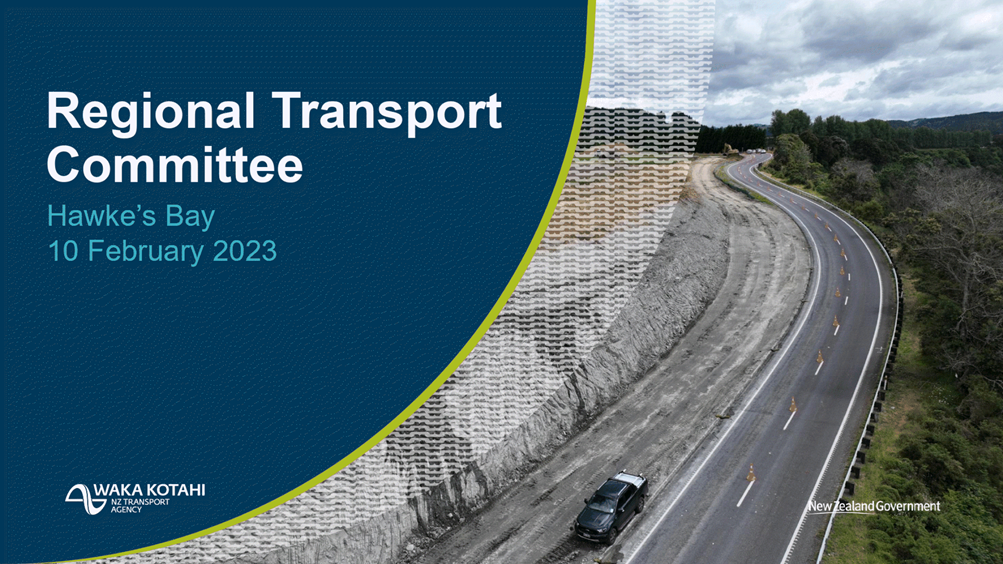
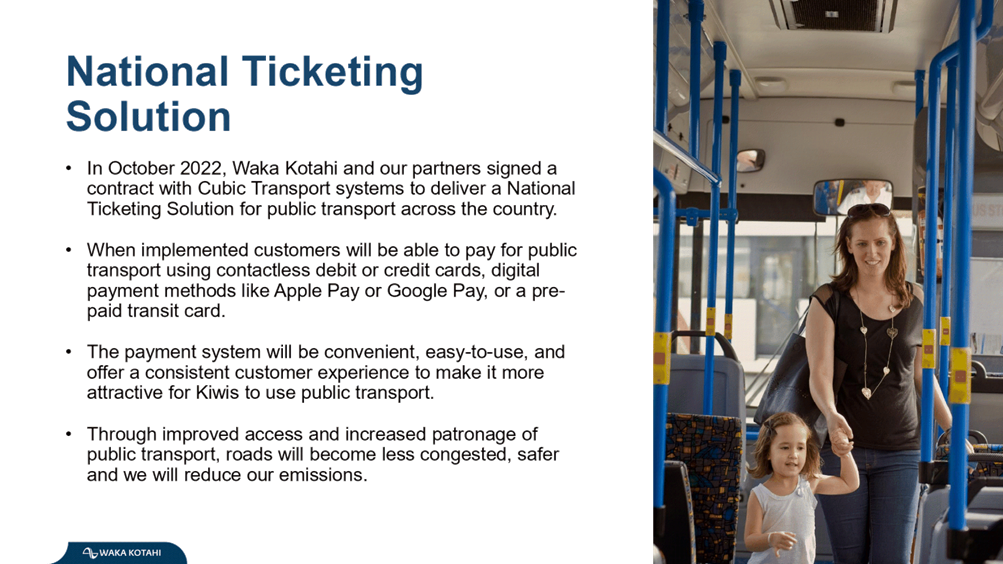
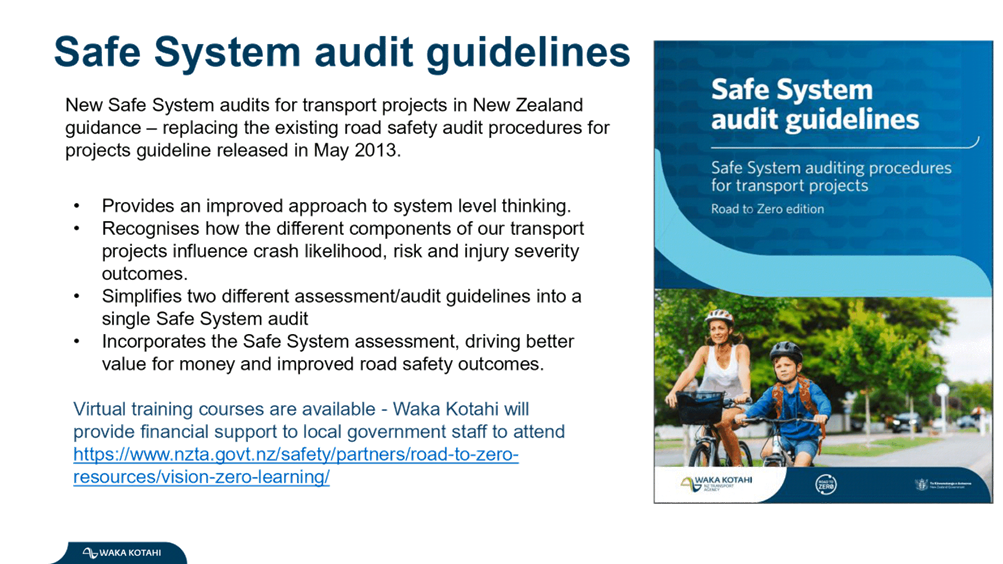
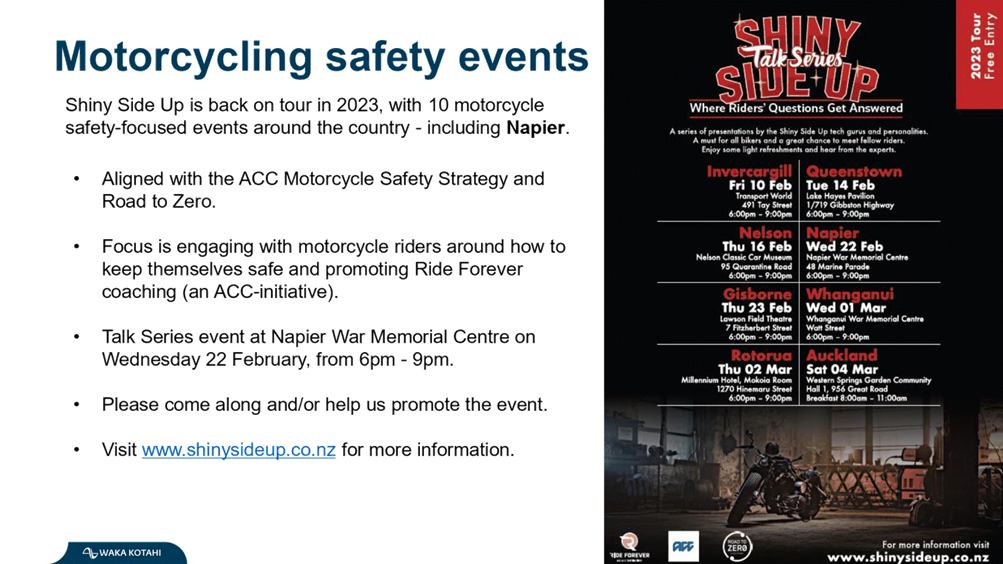
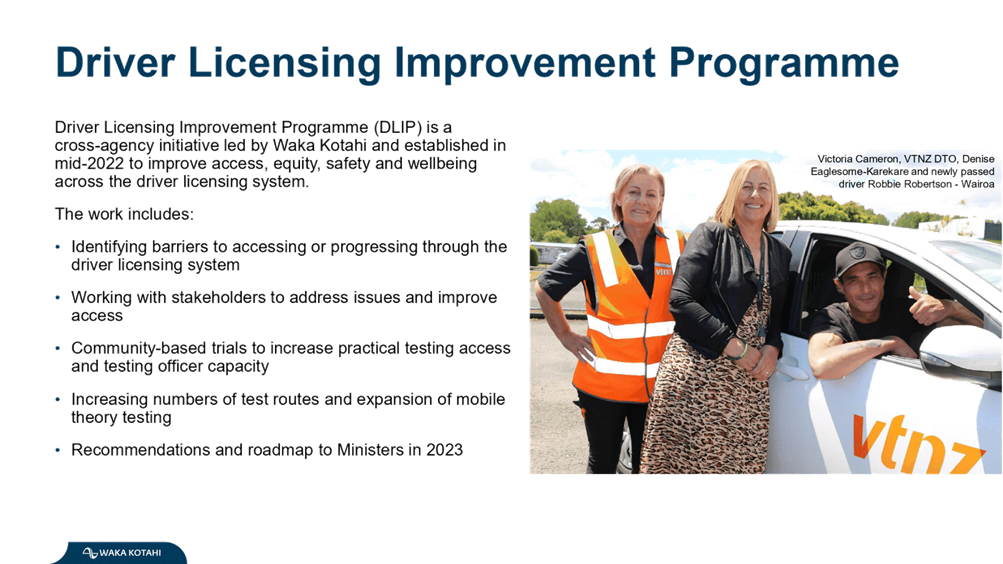
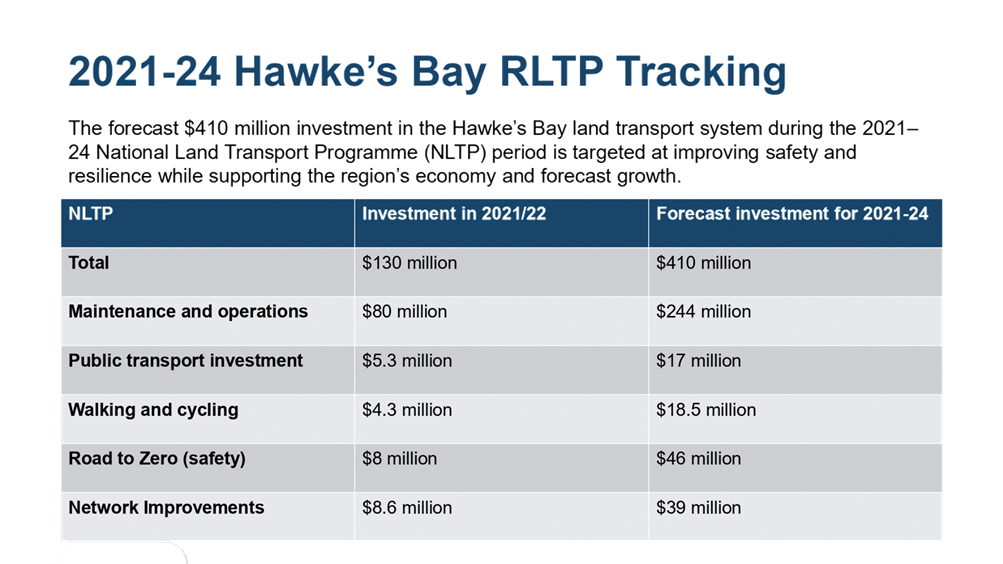
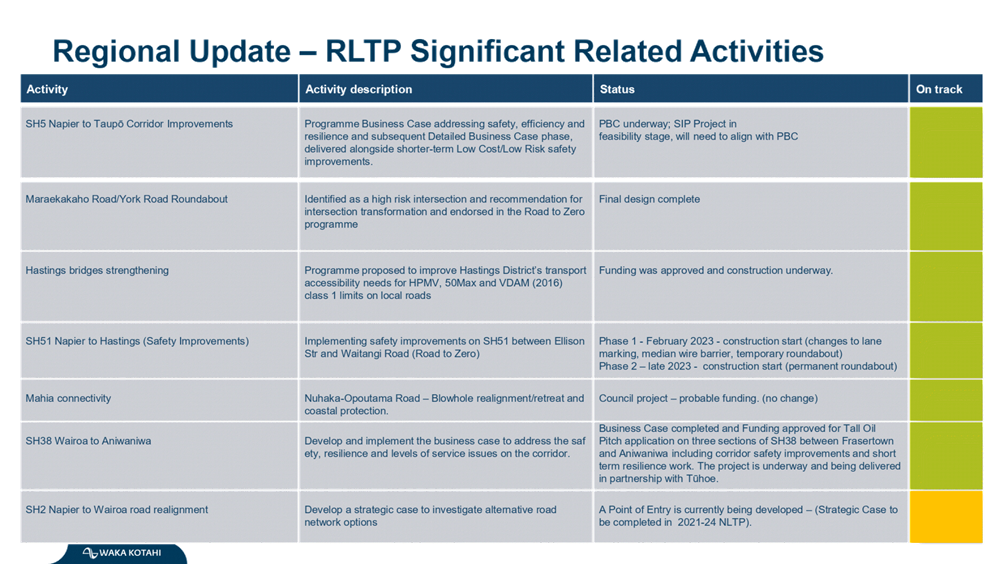
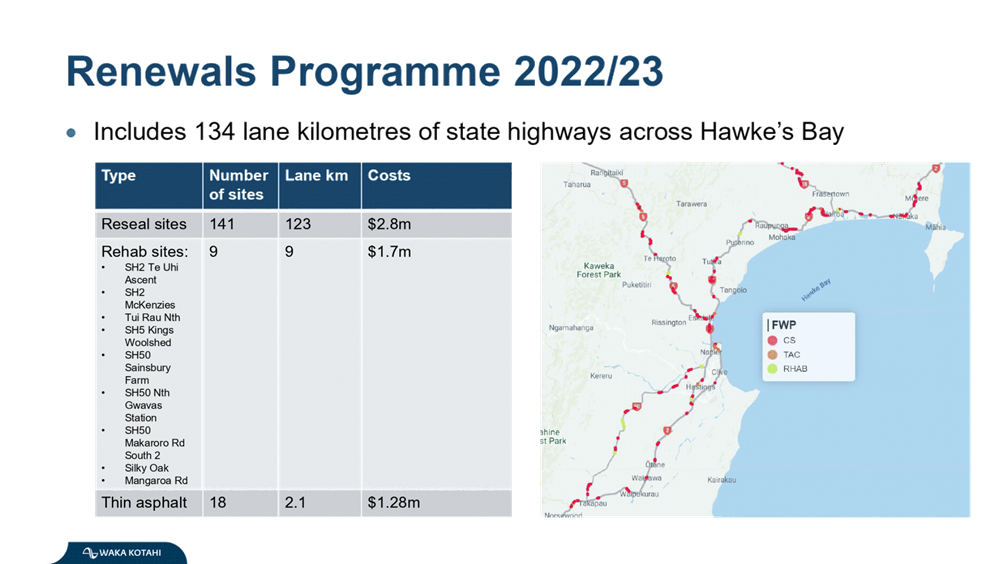
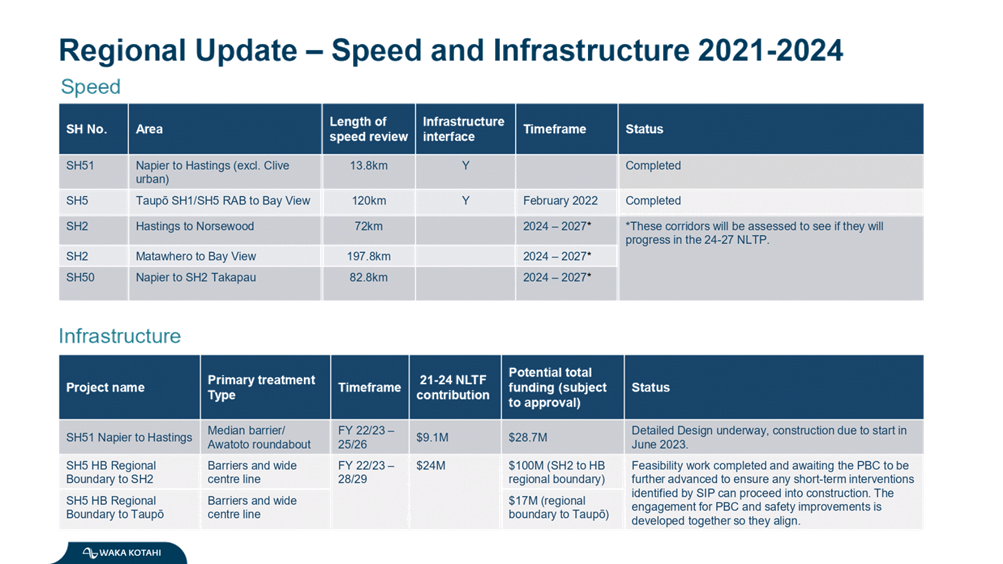
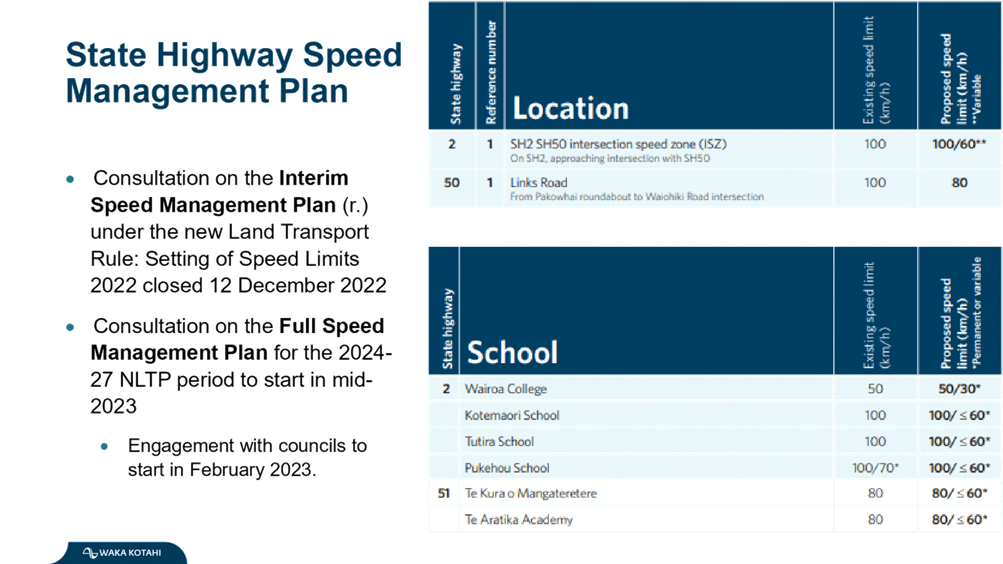
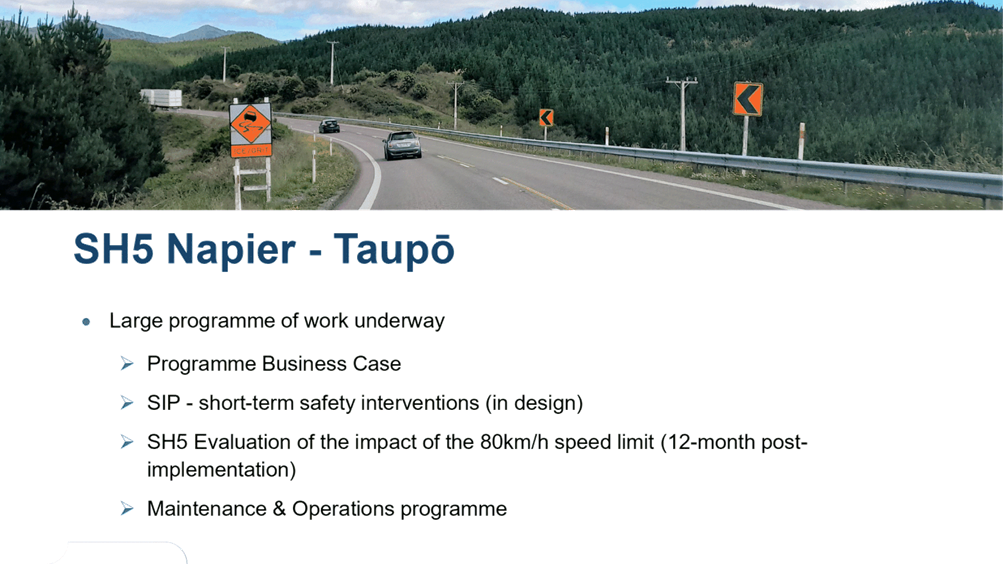
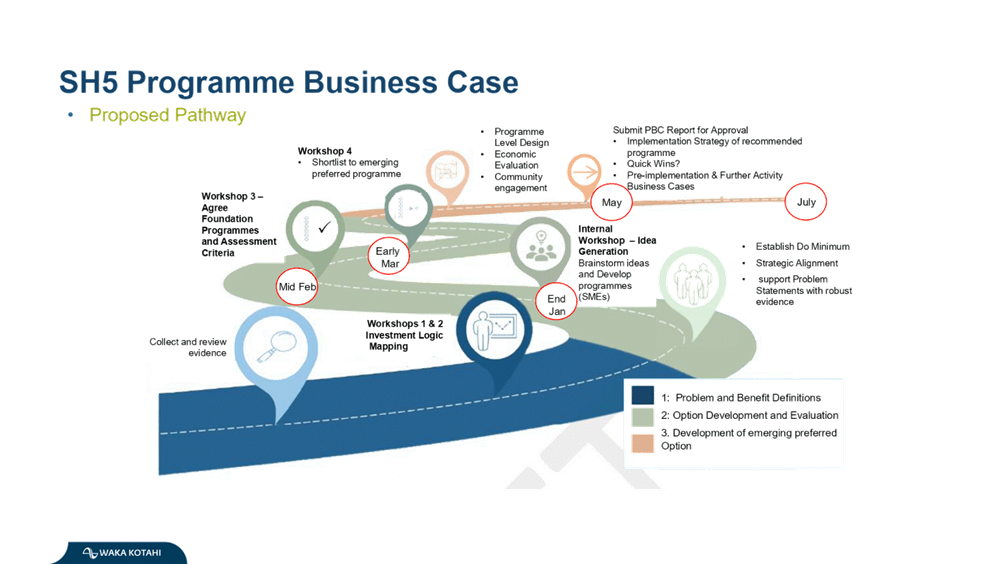
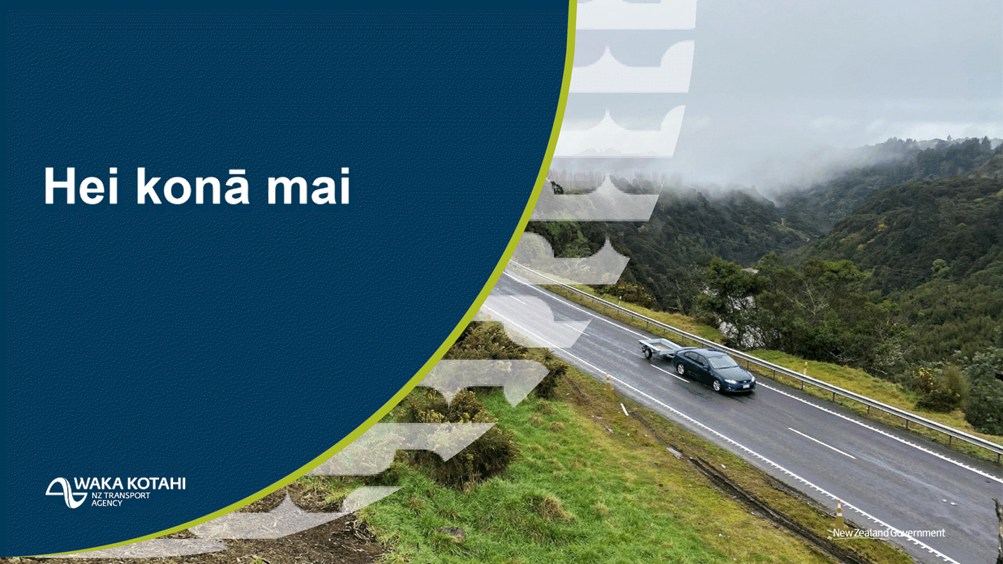
|
Waka Kotahi update February 2023
|
Attachment
2
|
